Anyone who ventures into the world of vintage French copper cookware will quickly come across the name Dehillerin, an iconic and photogenic kitchenware store operating in Paris since 1890.
A brief history of Dehillerin
The most entertaining (and presumably authoritative) history of Dehillerin comes from its own website and I encourage you to read it. (The September 2017 issue of the French magazine mint also has a wonderfully evocative story about the store.)
According to my research, André Charles Eugène de Hillerin de Préssec (1855-1902) — known as Eugène — began his business “in the 1880s” with the purchase of quincailleries-chaudronneries (hardware stores with integrated coppersmithing workshops) at 7 Rue de Bouloi and 1 Rue Montmartre. (I can’t verify the 7 Rue de Bouloi purchase.) It is the 1 Rue Montmartre property, purchased in 1885, that I believe is the source of the company’s “founded in 1820” claim, as that property had housed a series of chaudronneries since that year.
In 1890 Eugène opened a large retail store he named “Dehillerin” at 18 and 20 Rue Coquillière and consolidated manufacturing to a workshop at 3-5 Rue Léon Delagrange in the 15th arrondissement. The firm focused on a single mission: aider modestement à promouvoir la cuisine française (“modest assistance in the promotion of French cuisine”). Dehillerin sold its house-made goods alongside quality products from other French manufacturers to outfit the many restaurants and hotels in Paris.
Eugène de Hillerin passed away in 1902 and his widow Augustine continued the business with their children Maurice and Andrée. (Note that the family name remains de Hillerin while the store is one word, Dehillerin.) In 1907, the company purchased the former Lasnier chaudronnerie at 7-8 rue St-Simon in the 7th arrondissement, but during this same period also advertised that its copper cookware was made at a usine (factory) in Villedieu so it’s unclear what copper was manufactured where. Around 1922 the company expanded the workshop in the 15th to make its batterie de cuisine en cuivre. According to Dehillerin’s own lively writeup of its history,
This is where cookware, the famous copper and tin baking pans, and refrigerators for appetizers and pantry coolers for restaurants is made… A hundred employees are divided between the store and the workshops in a multitude of trades now missing. Tinsmiths, scourers, scrapers and passeurs à la terre made the walls of the factory ring with sound until the 1960s.
Dehillerin’s beautiful copper pots and pans are mentioned in the same breath as such august names as Gaillard, Jacquotot, and Pommier.
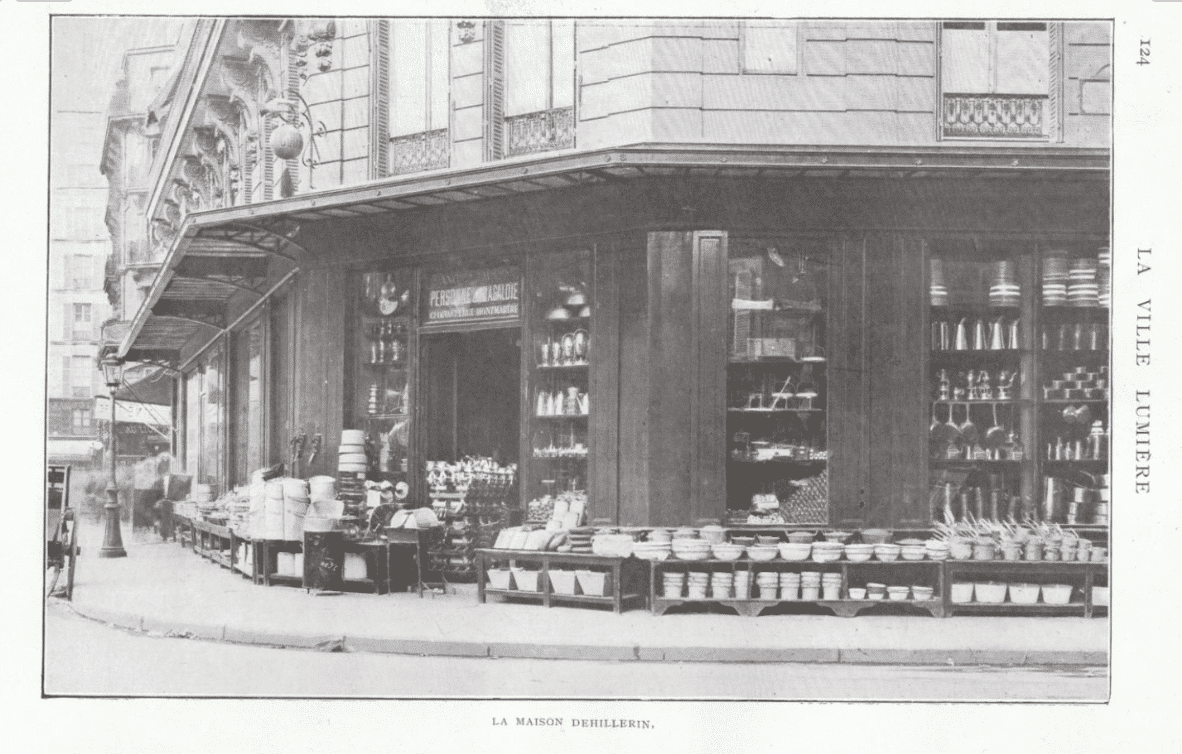
Dehillerin had been central to the Parisian (and French) cooking industry for more than a hundred years when Americans began to discover French cooking en masse after World War II. Julia Child bought many of her copper pots from Dehillerin and you can see them hanging in the Smithsonian Museum of American History in Washington, DC. According to the Smithsonian Magazine, “The pots were purchased in France between 1948 and 1952, during the time that the family lived in Provence. Several bear the address 18 rue Coquillière.” When Chuck Williams came to Paris in 1953 he visited the Dehillerin store and it served as part of his inspiration to open the first Williams-Sonoma store in California.
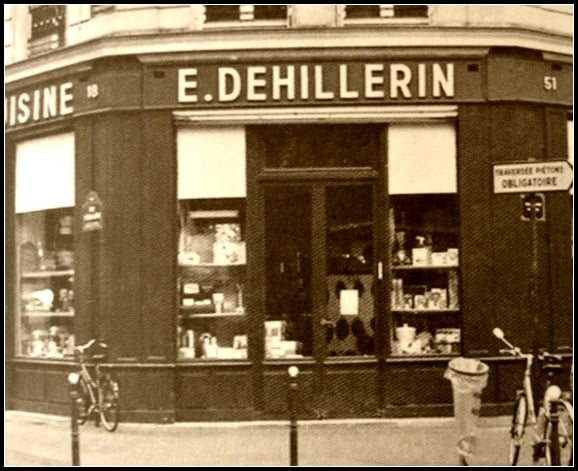
What is most relevant to my purposes for this post is that Dehillerin manufactured copper pots and pans from the 1880s through World War II, after which it stopped making copper. From an amateur copper appreciator’s perspective, this is the key thing to remember: Dehillerin is both a copper maker and a seller of other makers’ copper. A pot stamped Dehillerin was sold by Dehillerin but not necessarily made by Dehillerin. True Dehillerin-made pieces will all predate World War II (mid-1940s), but even prior to that, Dehillerin sold other manufacturer’s goods under the Dehillerin stamp as well.
Is this a distinction without a difference? Perhaps. After all, as the redoubtable TJFRANCE would say, “Copper pots brands stamped or not? Thickness in first!”:
I see that some people still raises the question of whether a tinned copper pot thickness of 3mm or more with a mark above is better than a pot of the same thickness that is not stamped? We must stop asking this amazing question! No matter whether stamped or not. A tinned copper pot 3mm and more is necessarily very high quality! Obviously with a stamp that is more beautiful. But to use the result is the same. It is strange to ask whether a 3mm copper pot Mauviel, Dehillerin will cook better than 3mm copper pot unnamed. There are so many variations! But keep in mind that 3mm and more is the top! There is no wrong making in this thick!
Ultimately, the heft and hardware of a pot speaks far more to its quality and performance than the stamp of one house or another. But still, I like to study these old vintage coppersmiths simply for the sake of appreciating them. What is early Dehillerin like? How did Dehillerin evolve over the decades? As with Gaillard, Dehillerin stamps changed style over the years. I have multiple examples in my collection and I’m going to use this post to look closely at them.
I’m big on summary tables, so here they are.
Pre-Coquillière
The very earliest stamps I’ve ever seen for Dehillerin represent the brief period when Eugène de Hillerin first began producing his own copper cookware from around 1885 to the early 1890s, before the family acquired the famous Rue Coquillière storefront.
There are two three of them that I have seen. (Many thanks to reader Joe W. who spotted two of these.)
 |
ANCNE MON PERSONNE E. DEHILLERIN SUCR DE LAGALDIE 1.R.MONTMARTRE PARIS |
 |
E. DEHILLERIN |
 |
DEHILLERIN |

Lagaldie frères operated a chaudronnerie et quincaillerie at 1 Rue Montmartre starting in 1860, and in 1870, acquired Personne (founded 1843) and its premises at 5 and 34 Rue Pagevin as well. (Rue Pagevin was demolished starting in 1880.) In October 1882 the company was acquired by Bastid & Fonrouge, a hotel and restaurant supplier. Bastid & Fonrouge continued to run Lagaldie at 1 Rue Montmartre for three more years until 1885, when they sold the property to Eugène de Hillerin and moved their own business to 39 Rue de l’Arbre Sec. This purchase entitled Eugène to use the names of both Lagaldie and Personne to help establish his name in the industry.
This is conjecture on my part, but I suspect these stamps represent Dehillerin’s very earliest production before the enterprise consolidated behind the storefront at Rue Coquillière. The time window for this would be no earlier than 1885 when he bought the 1 Rue Montmartre property. I think the oval stamp came first, immediately after Dehillerin assumed the business; the second and third stamps omits the notation of Lagaldie and Personne, implying that Dehillerin no longer felt the need to evoke these antecedents.
Eugène de Hillerin bought the property at 18 Rue Coquillière in 1890 but I think it’s possible he continued to use these 1 Rue Montmartre stamps for a period of time.
Linear series
I believe these are the first series of stamps with the new 18 Rue Coquillière address, no earlier than 1890 and likely a year or two later than that. They are all two- or three-line word marks with very minor differences between them. I would love to know how it came to be that there are four five six stamps like this. Val Maguire of Southwest Hand Tinning has a theory that Dehillerin was sourcing pans from other makers and that each maker may have had a slightly different version of the stamp. If this is the case, and it seems reasonable, I’d like to figure out which stamp came from whom.
 |
E. DEHILLERIN 18 RUE COQUILLIÈRE This stamp has no “Paris” in the address and the typeface is a sans-serif font. |
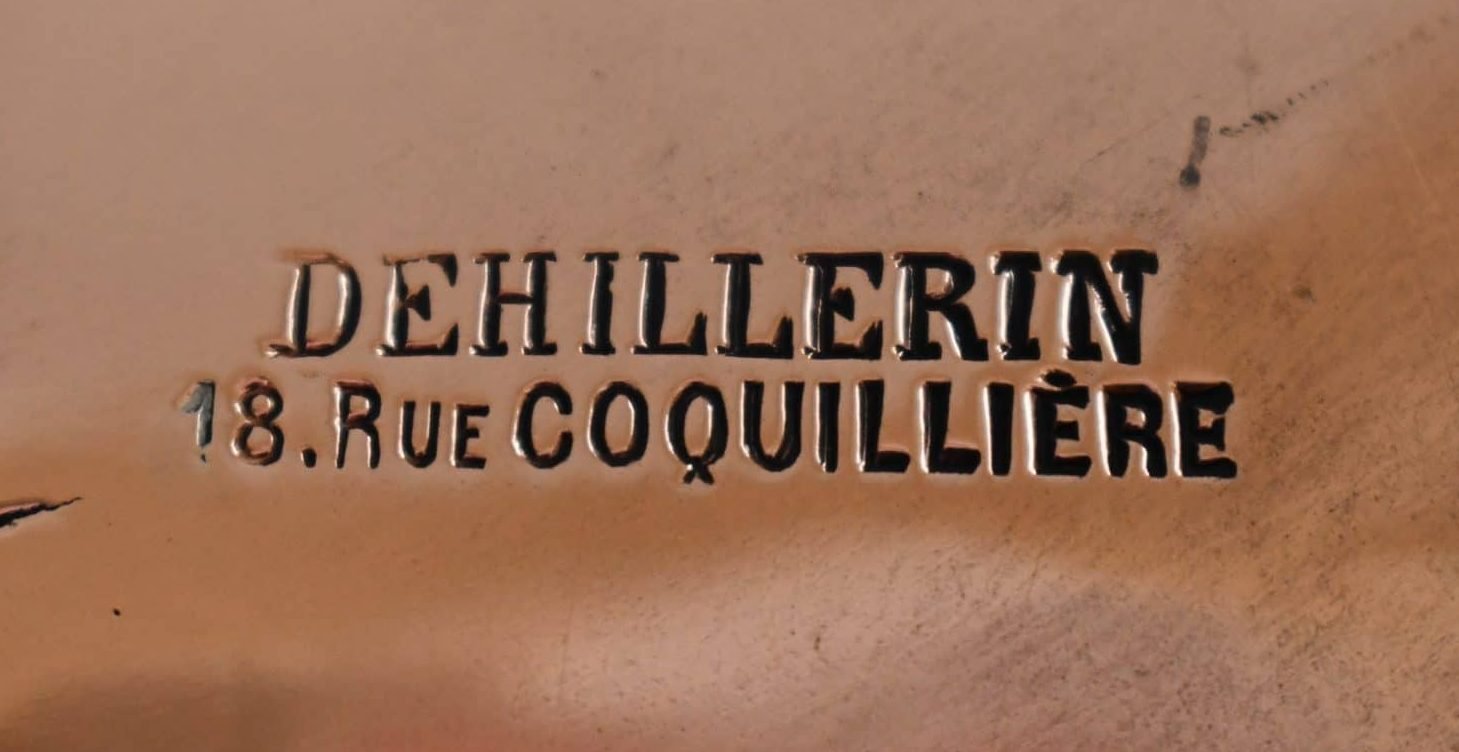 |
DEHILLERIN This stamp omits the “E” for Eugène Dehillerin, founder of the store, and the typeface for “Dehillerin” is a serif style. Note that the word “Rue” includes small-cap letters. |
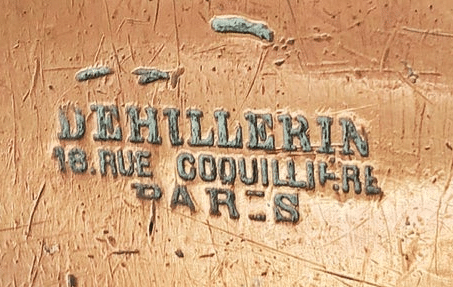 |
DEHILLERIN This is similar to the stamp above but adds the word Paris. |
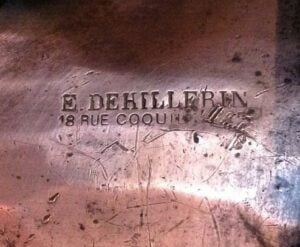 |
E. DEHILLERIN This stamp has the full “E. DEHILLERIN” in a serif style. Note that the top and bottom lines are the same width. (The lack of Paris may be a mis-stamp.) |
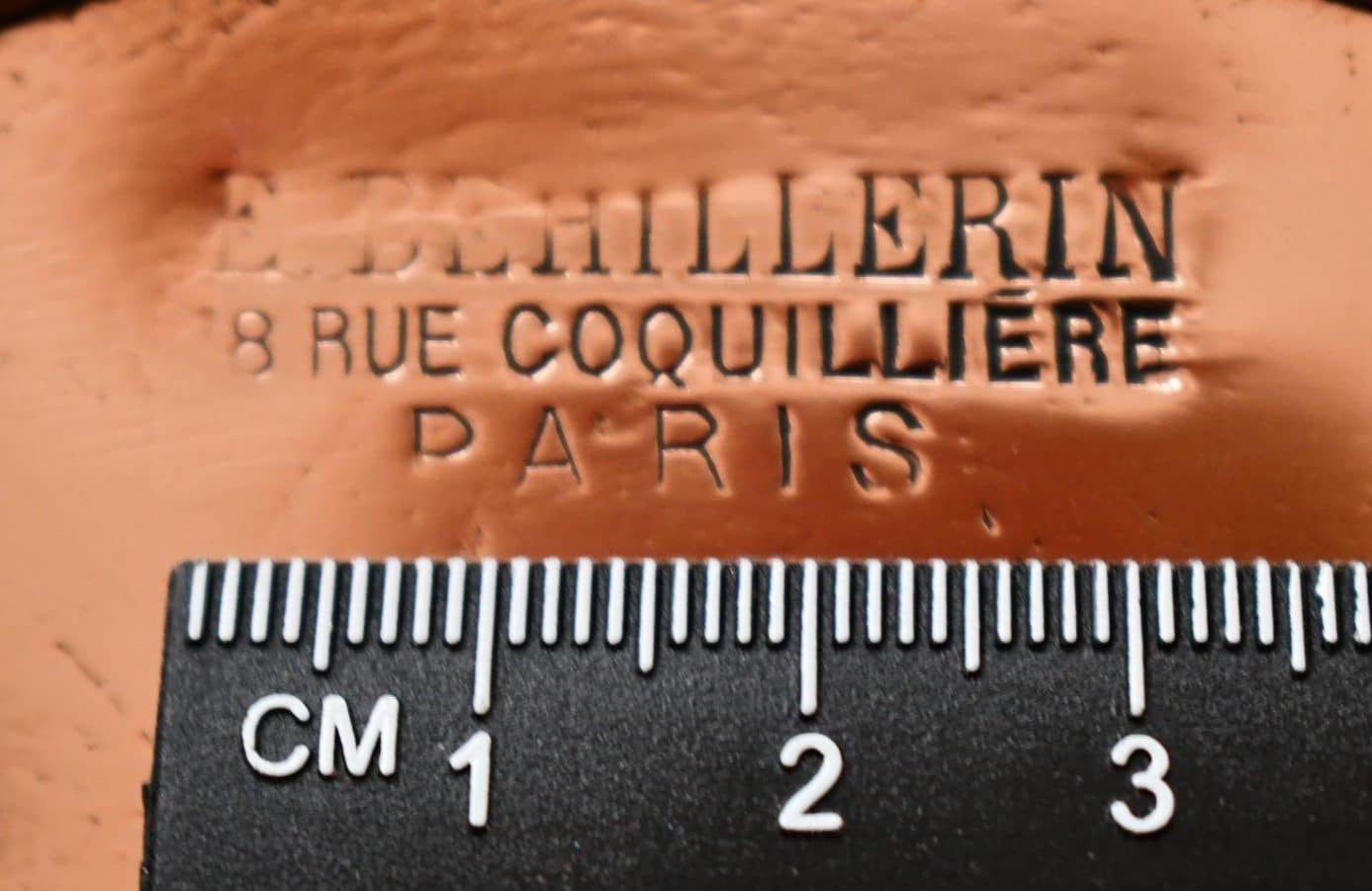 |
E. DEHILLERIN 18 RUE COQUILLIÈRE PARIS This uses serif font, includes the full street address, and the word Paris. It is about 32mm wide. |
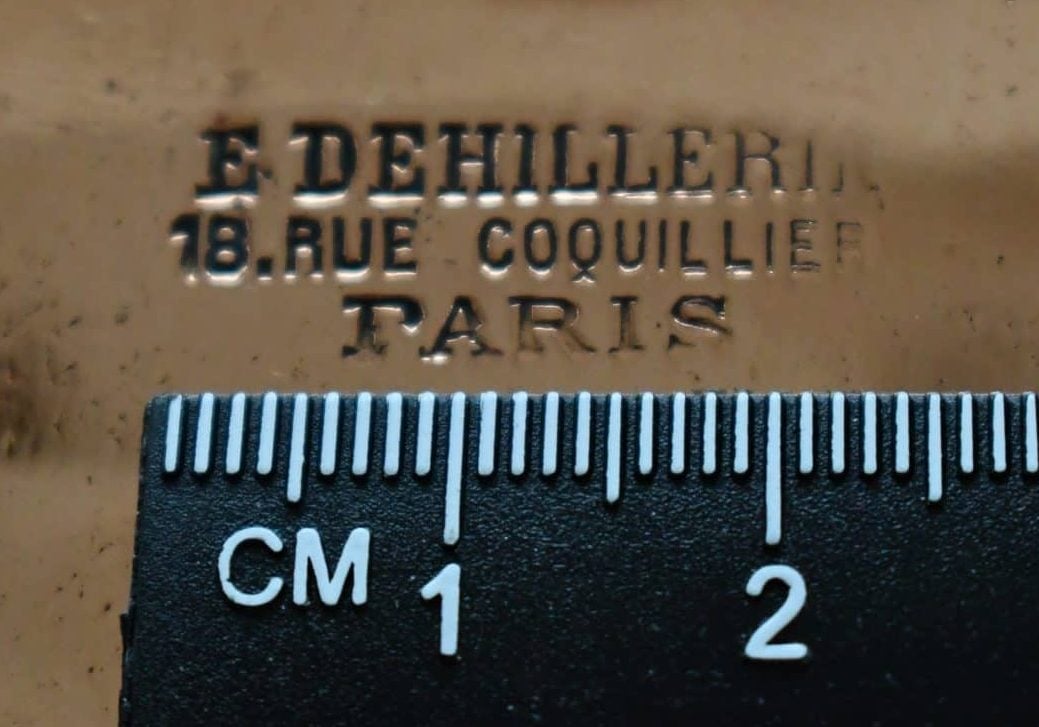 |
E. DEHILLERIN 18 RUE COQUILLIÈRE PARIS This one is almost identical to the one above except that it is smaller, about 24mm wide. |
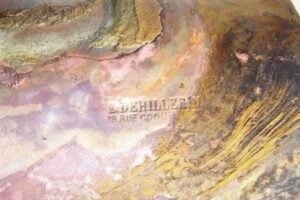 The example photo to the right was pointed out by reader Steve, a collector of artifacts from the White Star Line (WSL), the British shipping company that operated cargo and luxury passenger services across the Atlantic from 1845 to 1934. This is the stamp on one of the copper pots recovered from the wreck of the RMS Titanic that sank in 1912. According to Steve, “Although the WSL utilized Elkington for their standard galley cookware, the À la Carte Restaurant was not managed by the WSL. As it was operated independently by Mr. Luigi Gatti and his French wait staff, my guess is that this pot may have been supplied by Mr. Gatti himself.” As above, I think this stamp is from the early 1890s, making this pan already an experienced hand in the kitchen by the time of its sailing on the Titanic in 1912.
The example photo to the right was pointed out by reader Steve, a collector of artifacts from the White Star Line (WSL), the British shipping company that operated cargo and luxury passenger services across the Atlantic from 1845 to 1934. This is the stamp on one of the copper pots recovered from the wreck of the RMS Titanic that sank in 1912. According to Steve, “Although the WSL utilized Elkington for their standard galley cookware, the À la Carte Restaurant was not managed by the WSL. As it was operated independently by Mr. Luigi Gatti and his French wait staff, my guess is that this pot may have been supplied by Mr. Gatti himself.” As above, I think this stamp is from the early 1890s, making this pan already an experienced hand in the kitchen by the time of its sailing on the Titanic in 1912.
Thank you, Steve, for this stamp example and the story!
Single-line Dehillerin
 This is the only example of this stamp I have seen, and it belongs to a piece owned by Martin. Says he,
This is the only example of this stamp I have seen, and it belongs to a piece owned by Martin. Says he,
I came across a small (and presumably lightweight) 12cm saucepan in Austria with a hitherto unknown variation of the DEHILLERIN stamp, reminiscent of the plain sans-serif stamps from around 1900, but not complemented by any street name. Strange. The make of the pan, especially its rivets are consistent with this period. On the other side of the handle is stamped SAPEL, probably the name of a store, restaurant, hotel etc. There is a Café Sapel in Königsfeld, Black Forest, SW-Germany, which has a long history (founded in 1866, 5 generations so far). The connection I made between the stamp and the cafe is purely hypothetical, especially since the French pan also traveled from Germany to Austria, but I found no other origin.
I don’t quite know where to put this in the timeline, so I will follow Martin’s instincts and place it with the other early linear stamps.
Oval with complete address
This stamp has “E. DEHILLERIN 18. RUE COQUILLIERE PARIS” within an oval outline. I have seen it oriented vertically and horizontally. The earliest it could be used is 1890, but I believe it’s more likely 1895 or later into the 1900s, after the linear series above.

I have two pots with this stamp in vertical orientation: a big 38cm stockpot and a 20cm Windsor.
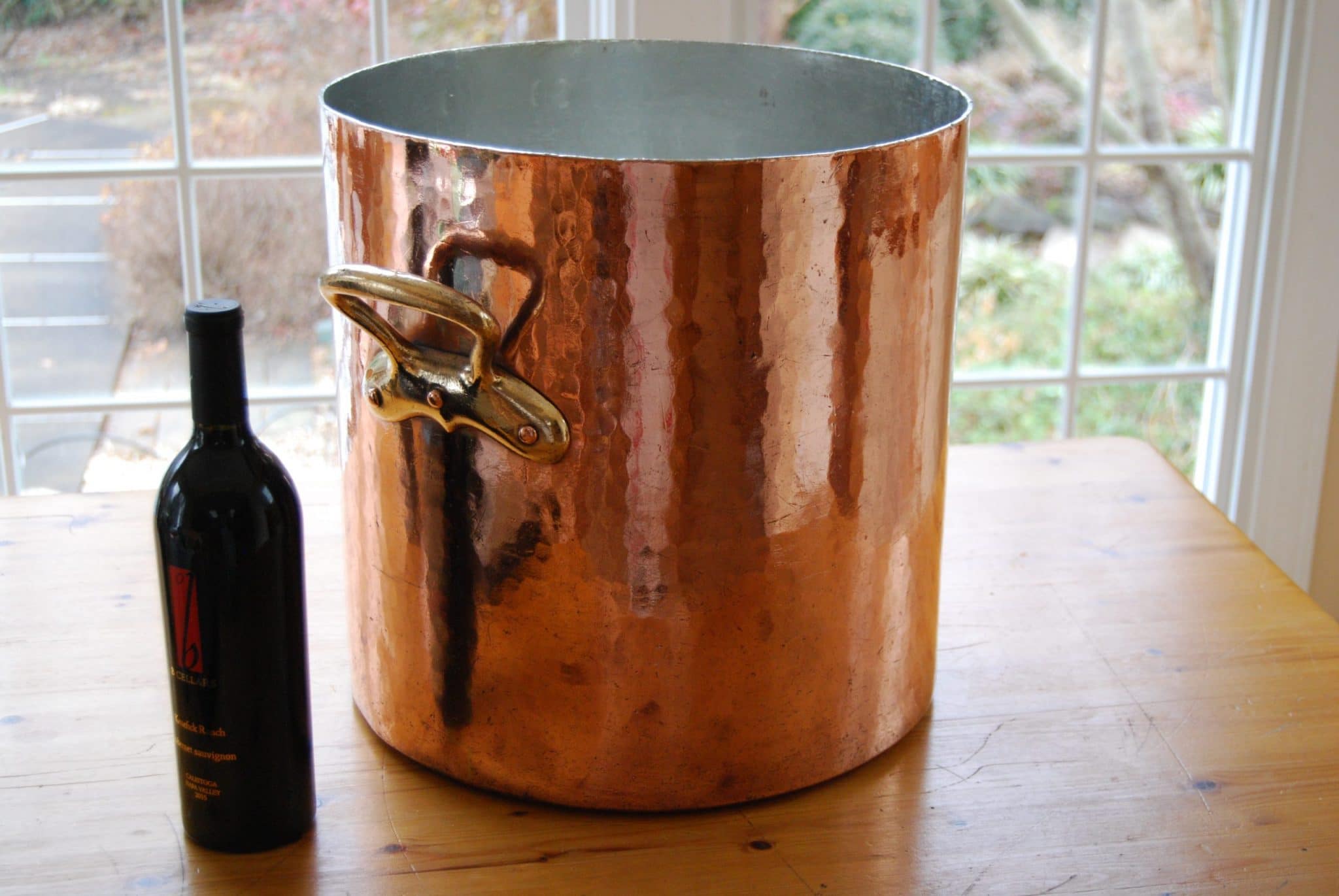
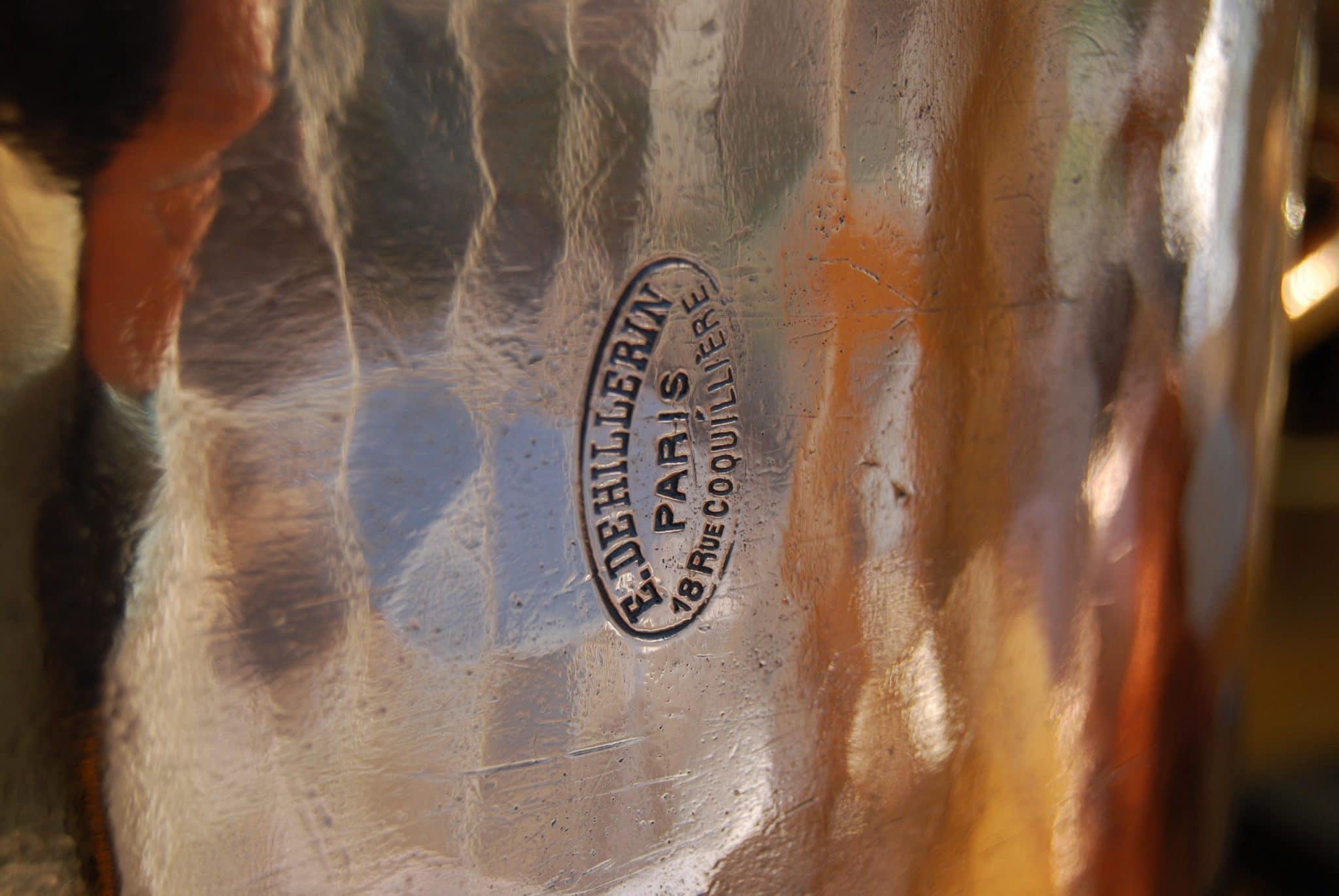
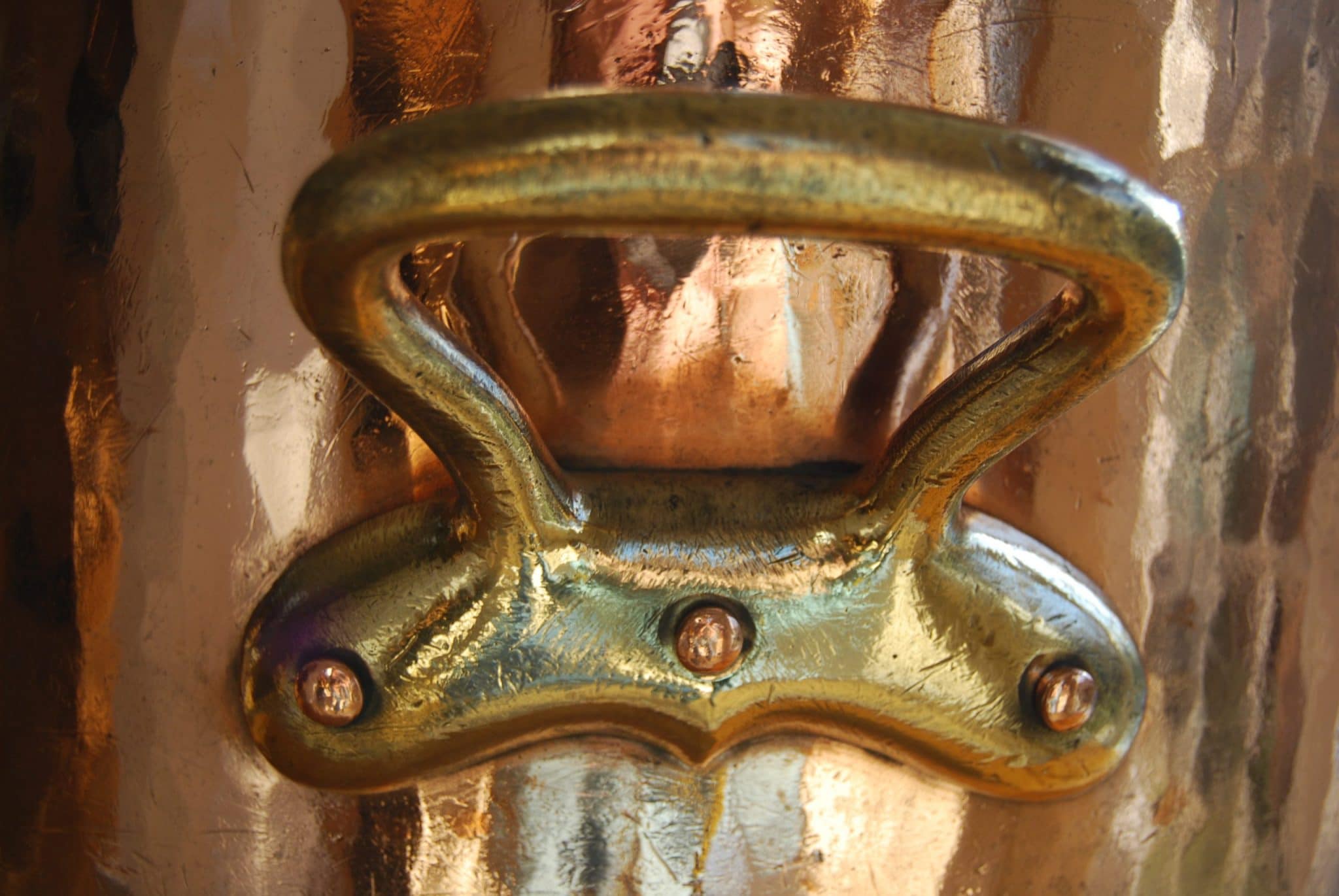
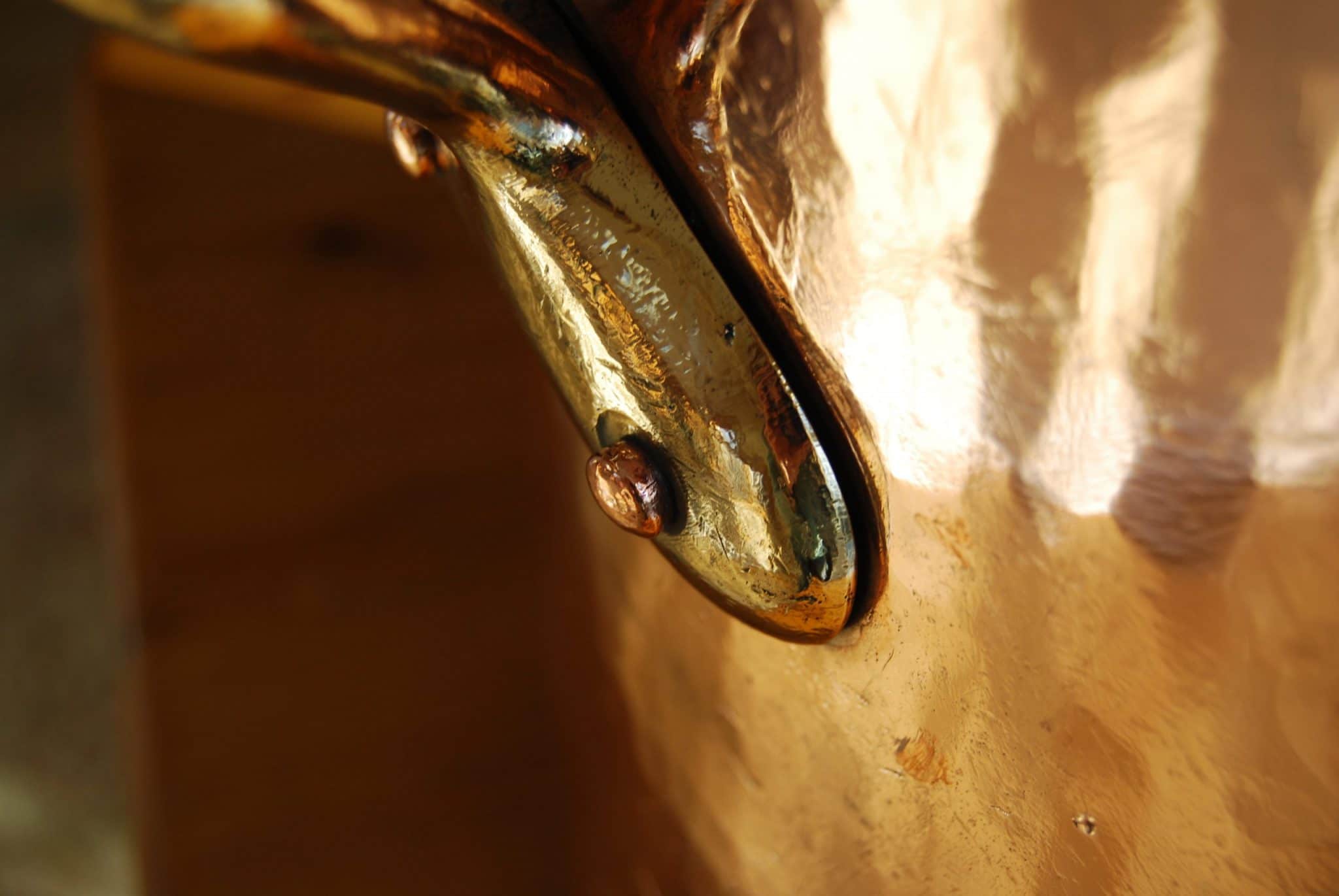
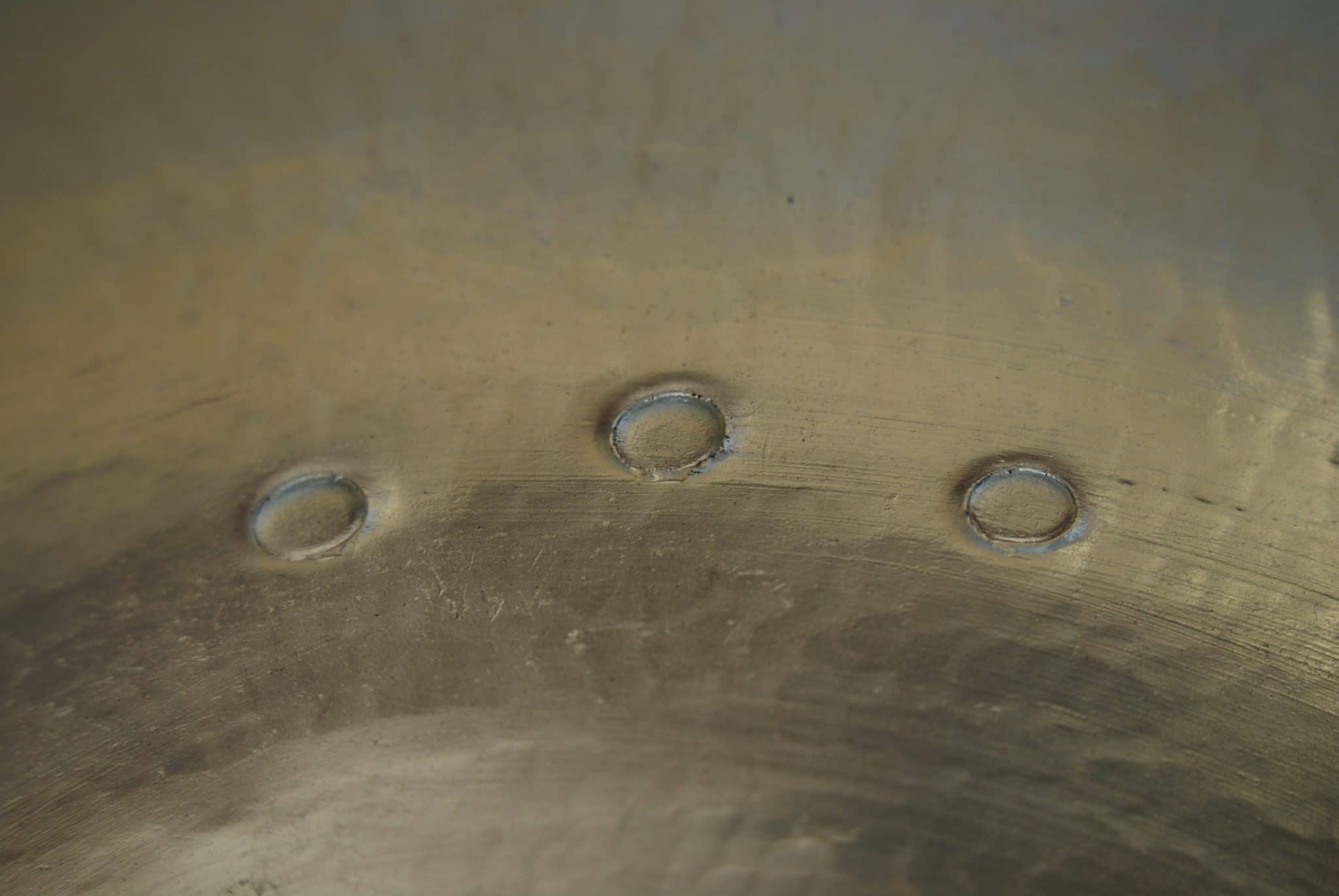
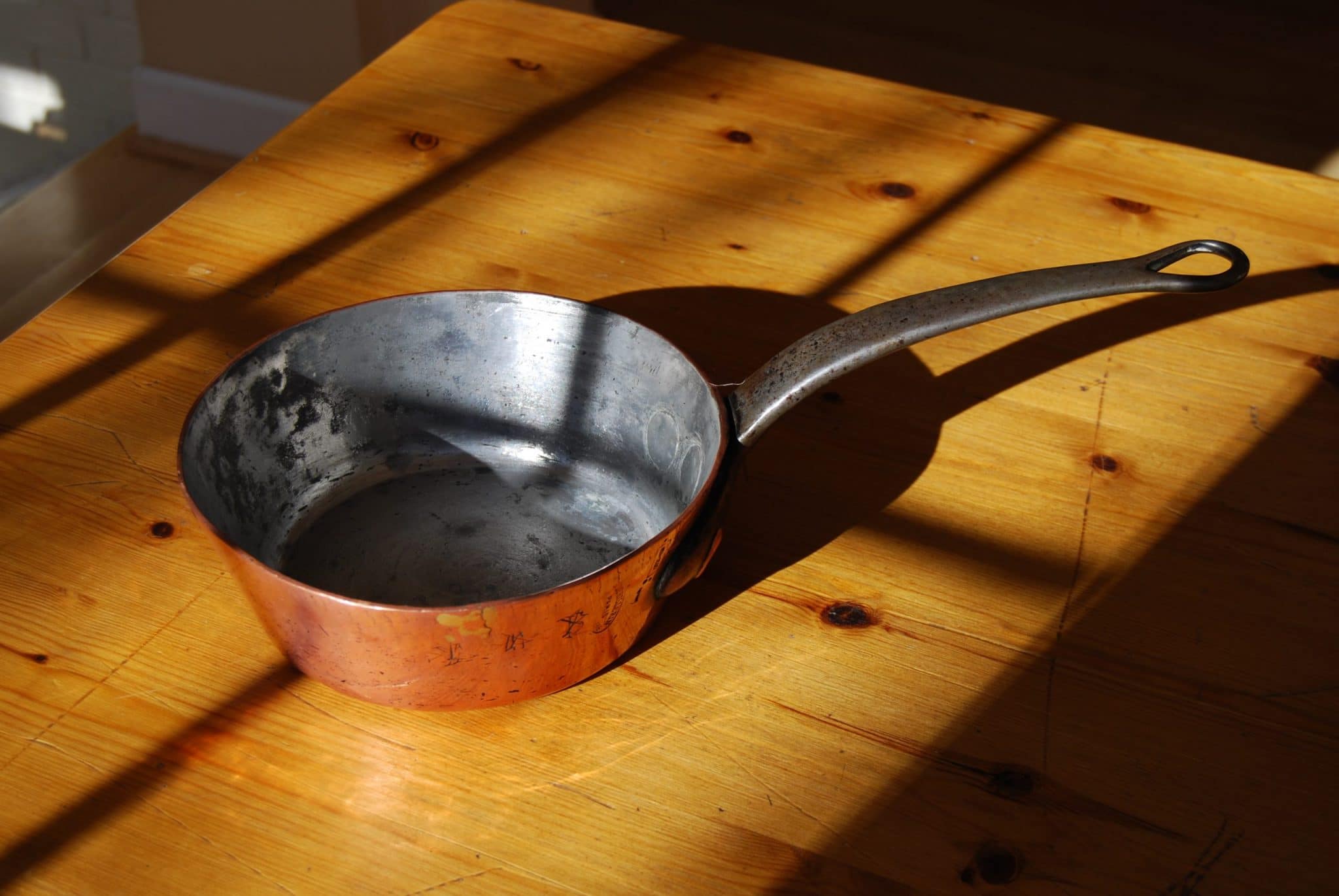

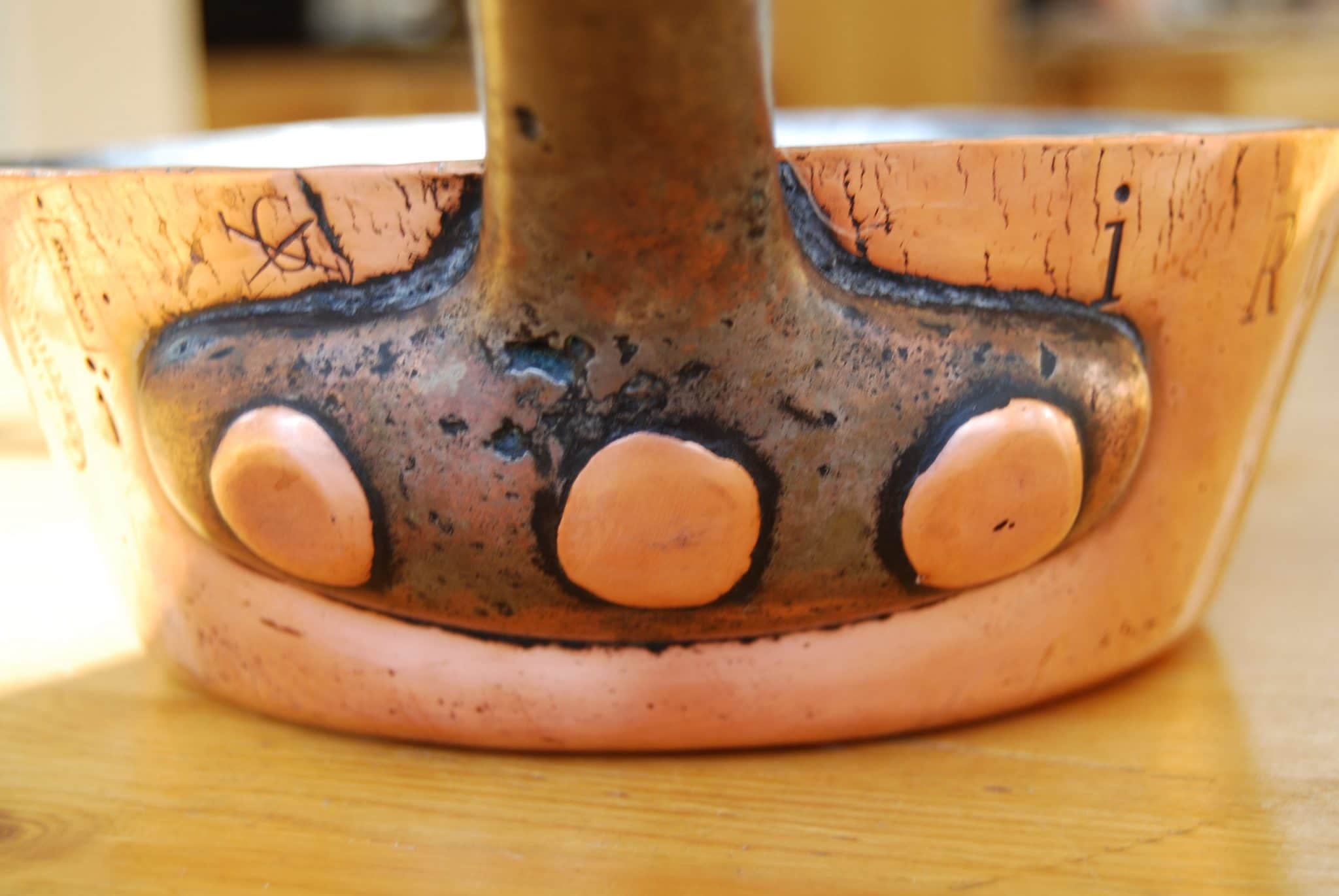
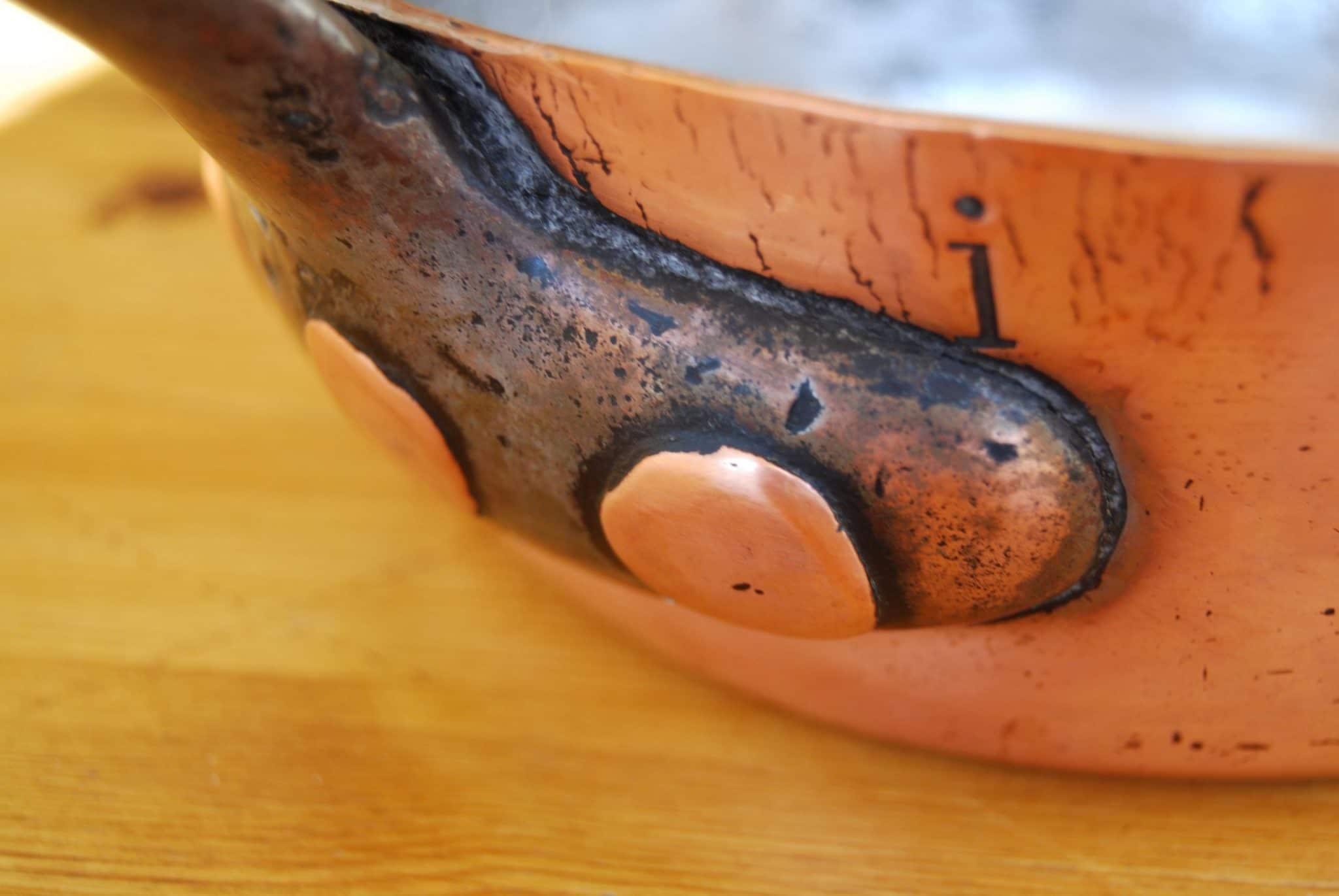
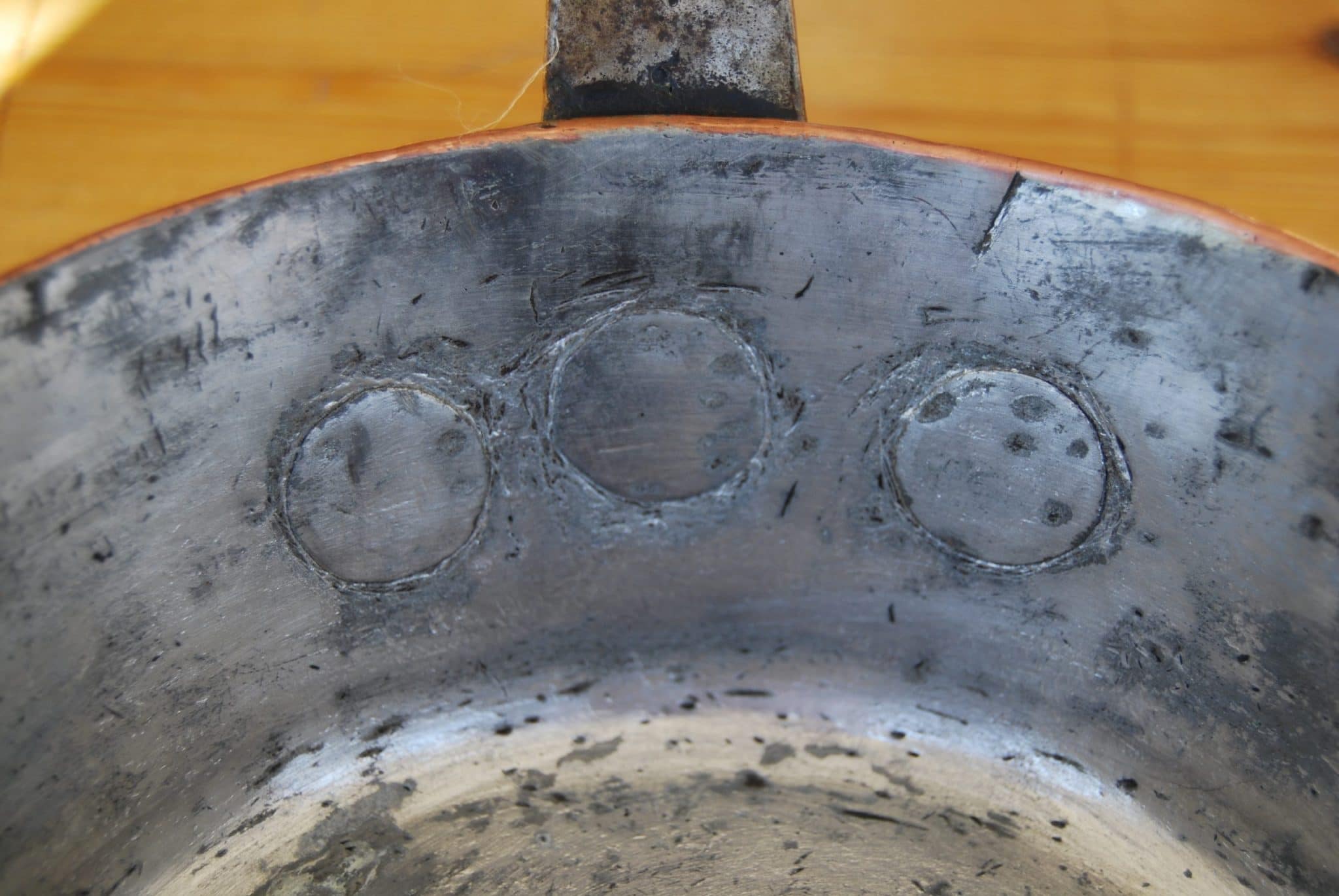
Get a load of the rivets on that Windsor. They’re totally out of proportion to the pan. That style of outsized rivet is a hallmark of early copper crafting, in my experience. The stockpot, however, has a smaller rivets and a more refined aesthetic. My guess is that the Windsor may may be a few years older than the stockpot.
Here’s another pan with the stamp stamp in horizontal orientation. I don’t know if there was any significance to the vertical versus horizontal orientation, but there is one potential common-sense explanation: this stamp is quite wide, and on a piece with a pronounced curvature, the stamp might not impress evenly at the edges. The vertical orientation solves this problem by providing a flat plane for the stamp strike.
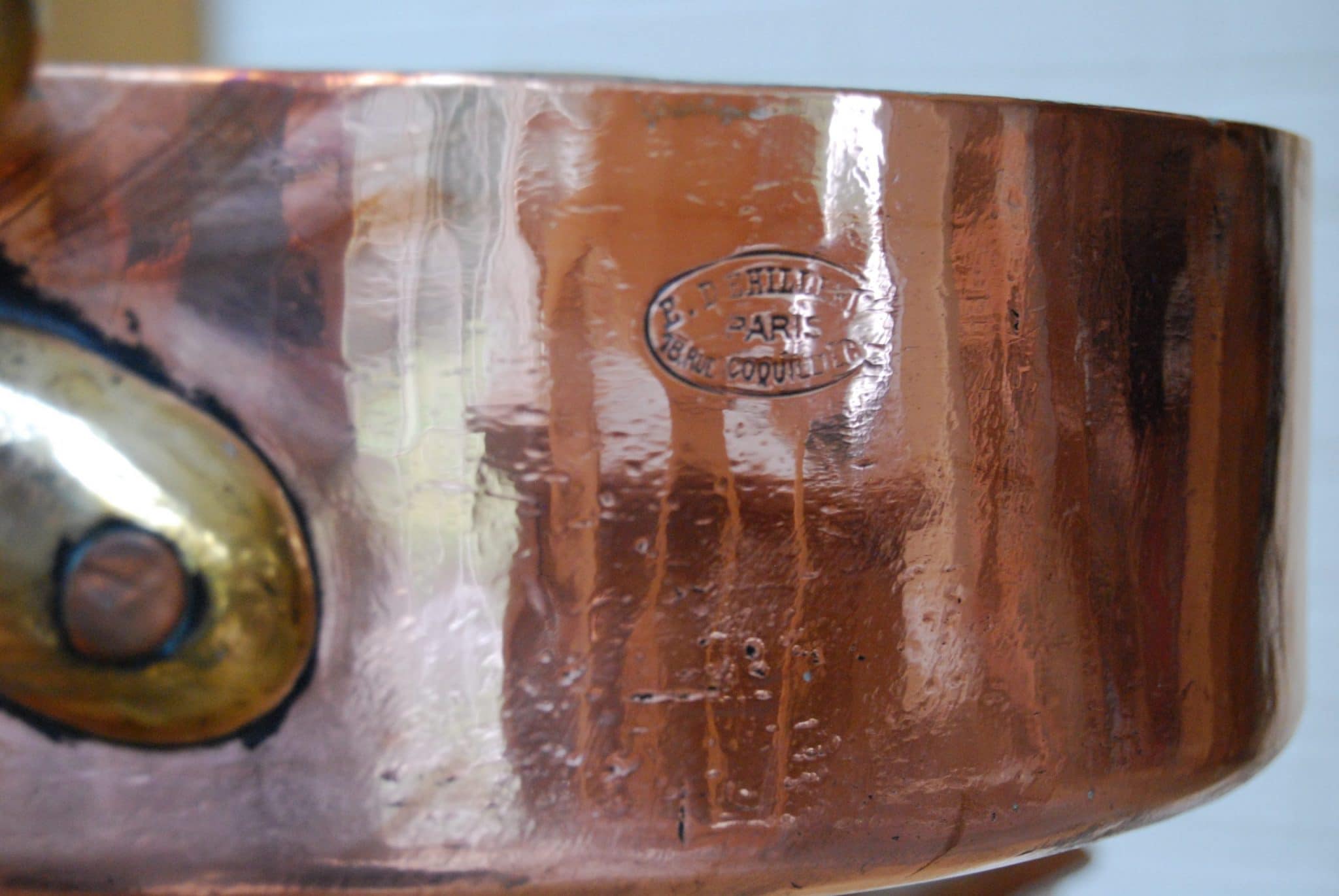
I only have one pan with this mark in this orientation — a 34cm rondeau.
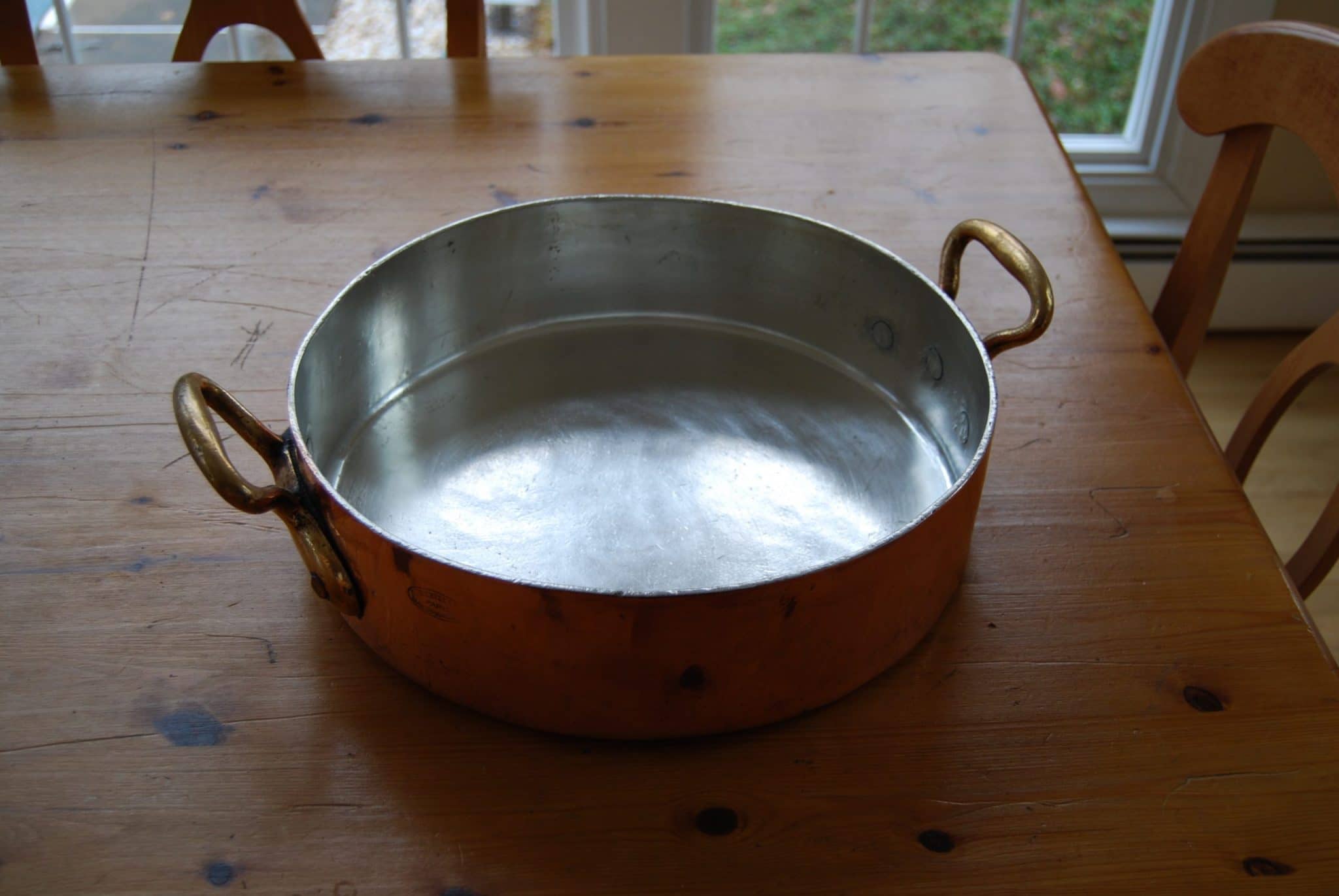

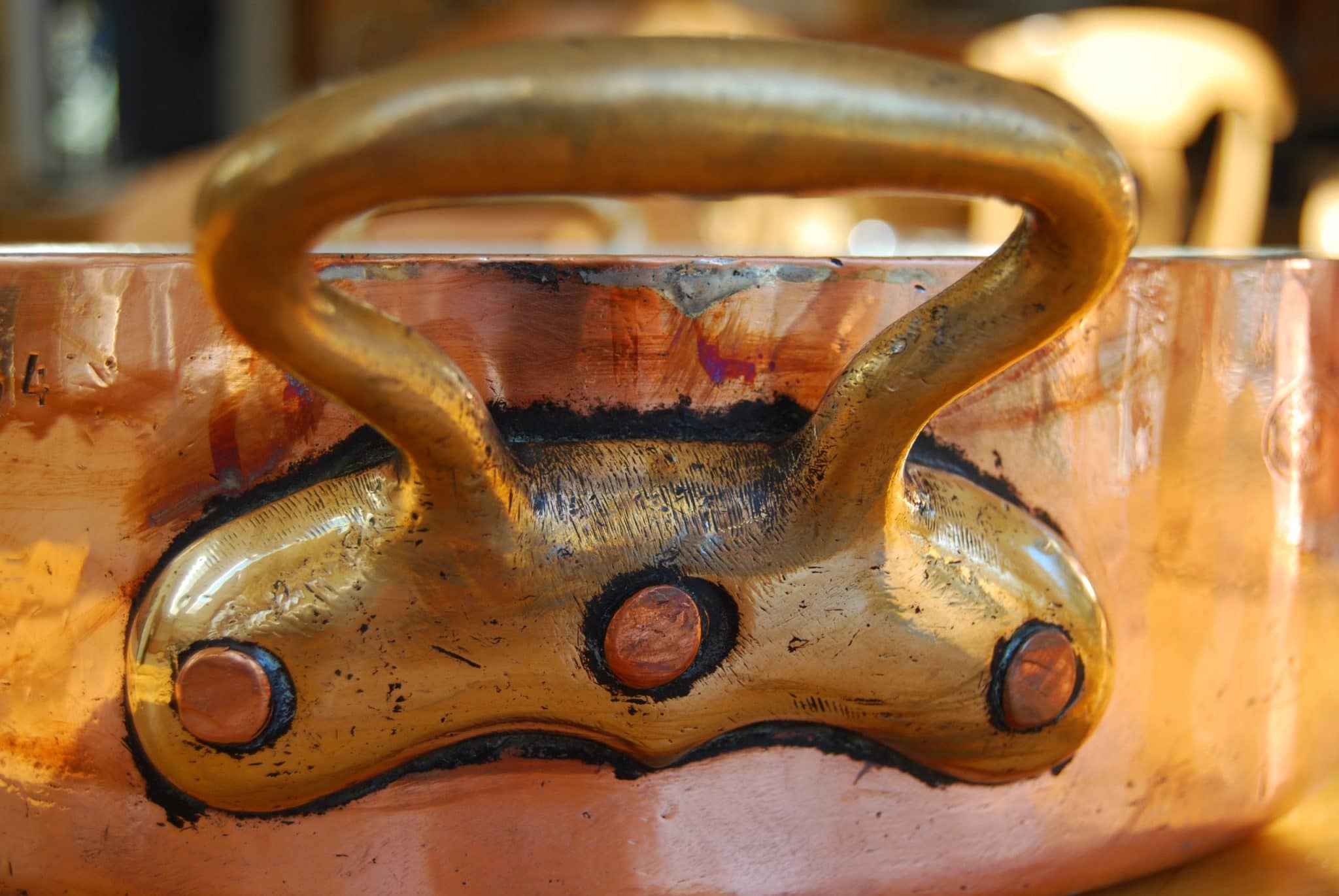
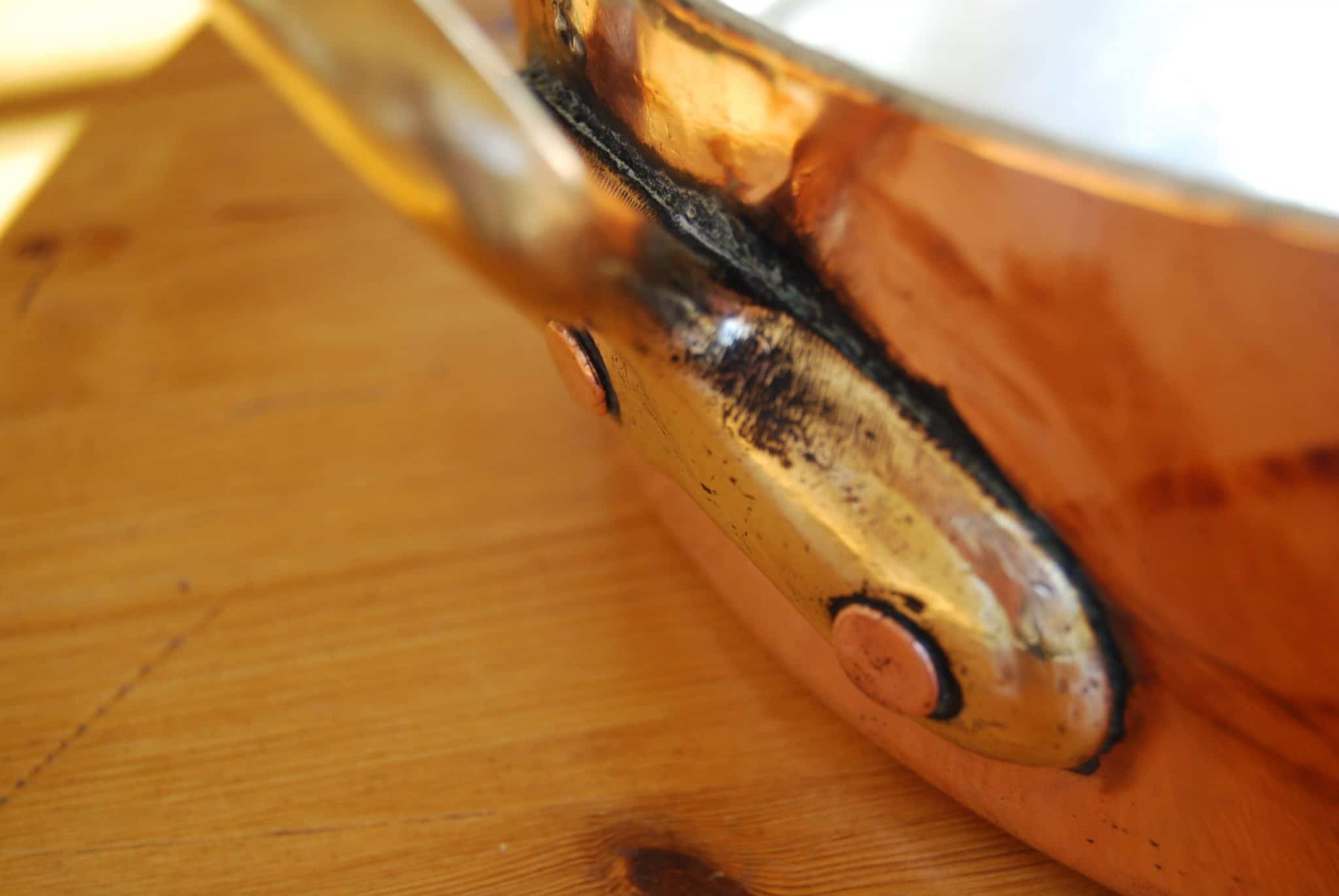
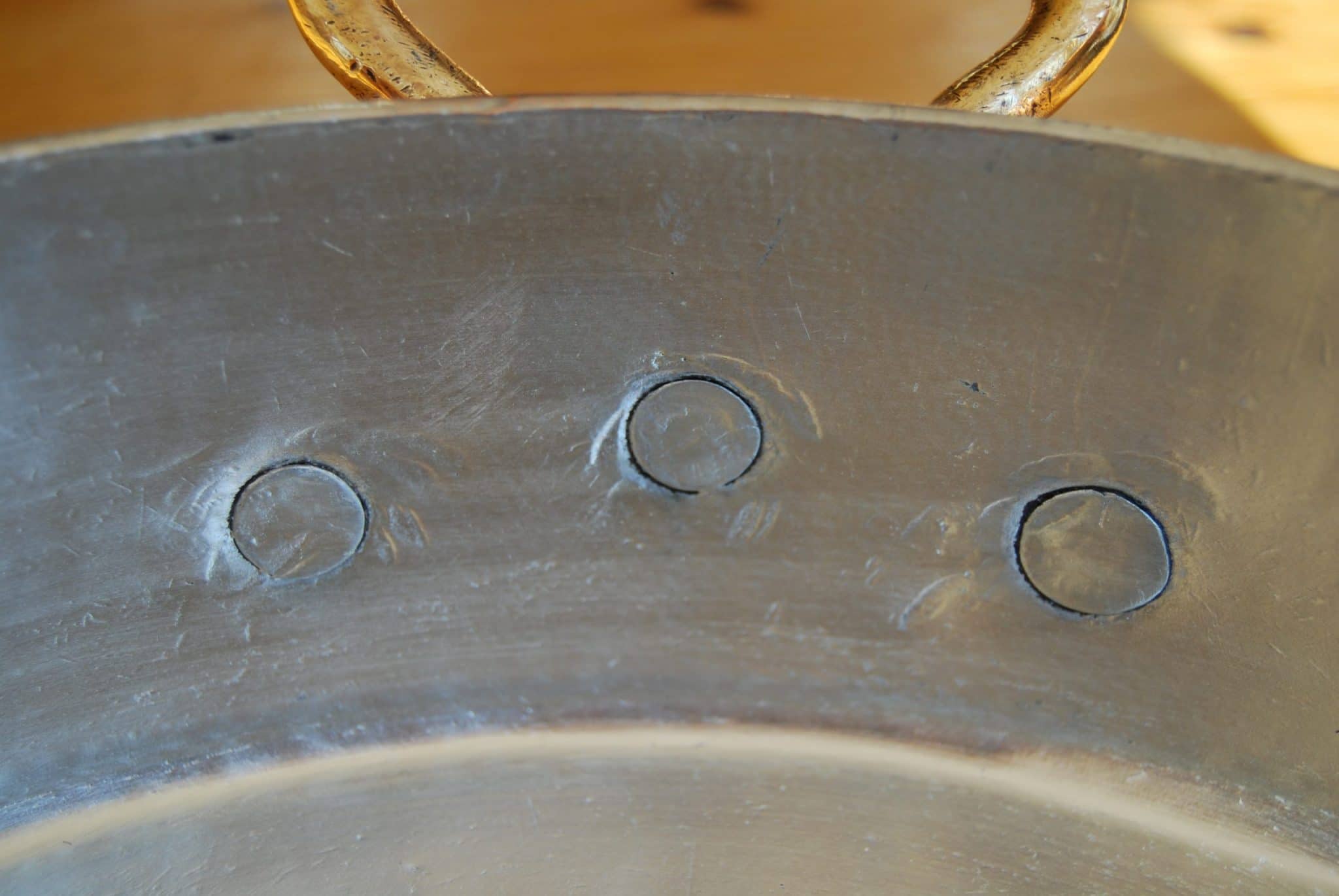
Compare this pan to the Windsor and stockpot above. They have the same stamp and I presume they’re of the same era. But even though this rondeau and the stockpot have brass hardware, the rivets are very different. This rondeau with its large rivets has more in common with the Windsor than the stockpot. I’m starting to think the Windsor and the rondeau are quite early and the stockpot may be a little later.
There is a second version of this stamp with a very slight difference: instead of “18 Rue COQUILLIERE,” it reads “18 R. COQUILLIÈRE.” I also see what looks like a proper accent grave over the E of Coquillière. In other respects, the stamp is virtually identical to the one above. My thanks to reader Marcus G. for spotting this stamp and providing examples.

Marcus has three pans with this stamp, all acquired from the same eBay seller. I see cast iron handles, small polished exterior rivet heads, and, on the interior of the sauté pan, what look like numbers on mass-produced mushroom-head rivets; Marcus adds that he sees a dot on the saucepan base, as well as bevels. My research suggests that these characteristics correspond to late-19th to early 20th century manufacture.
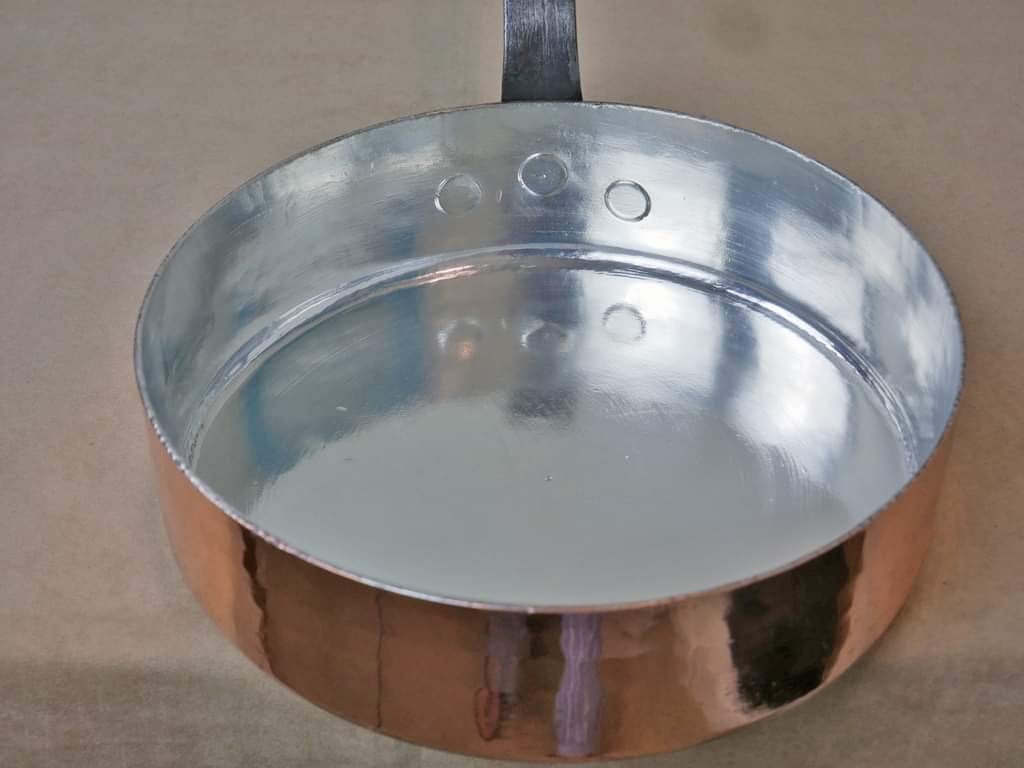
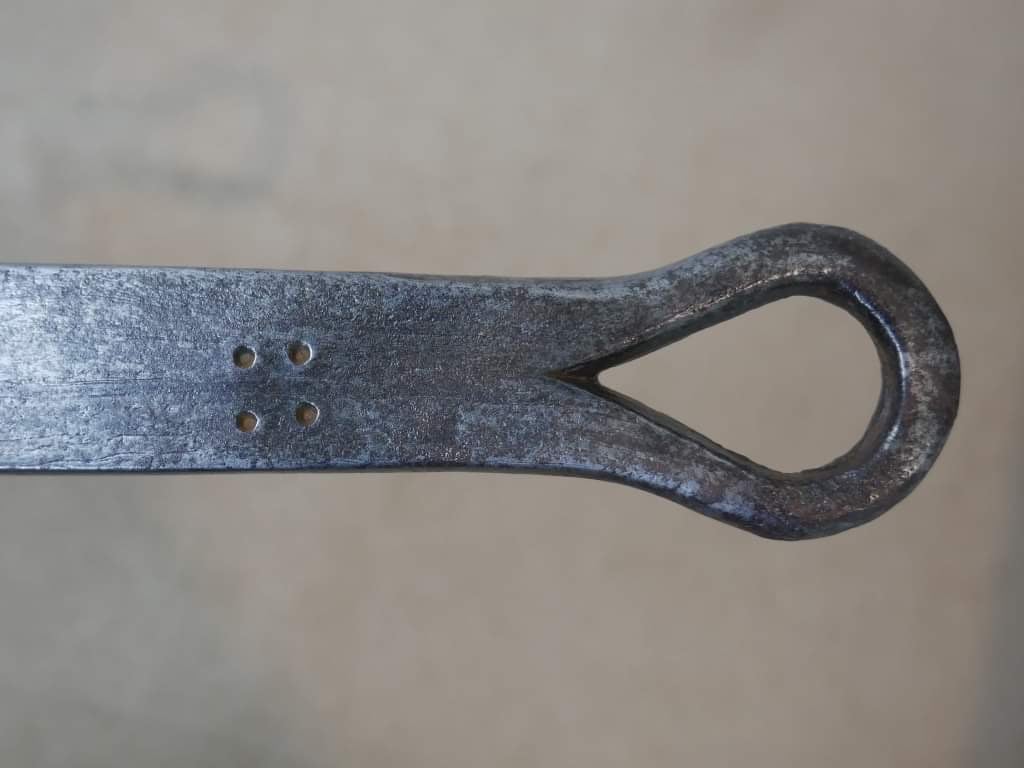
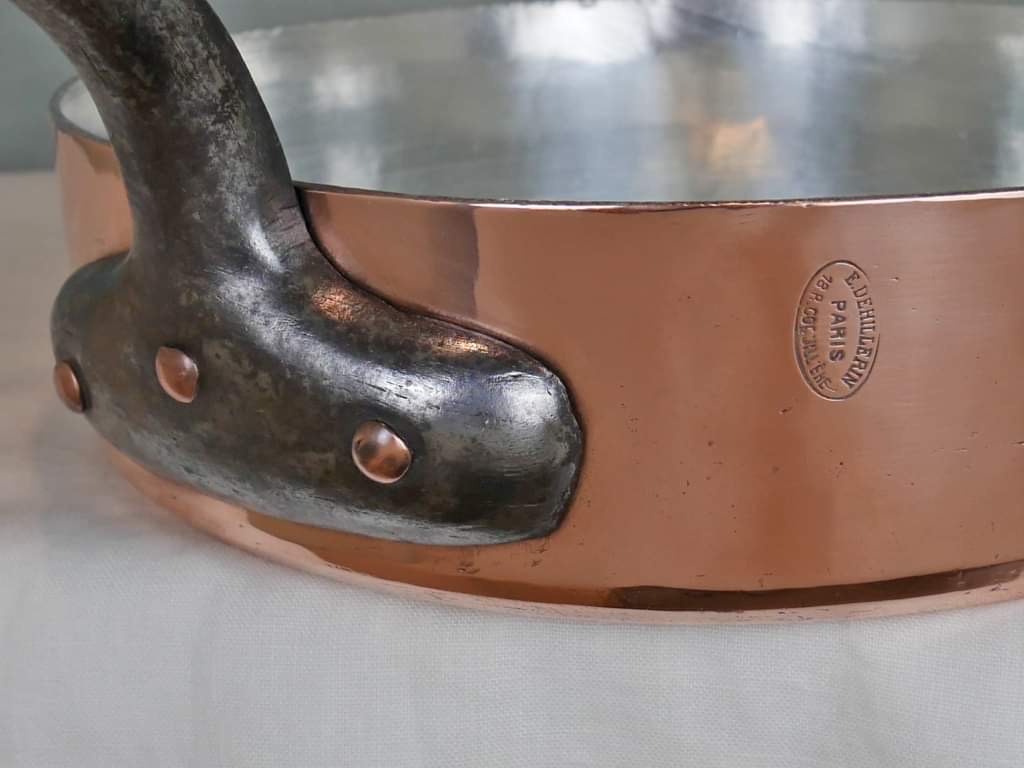
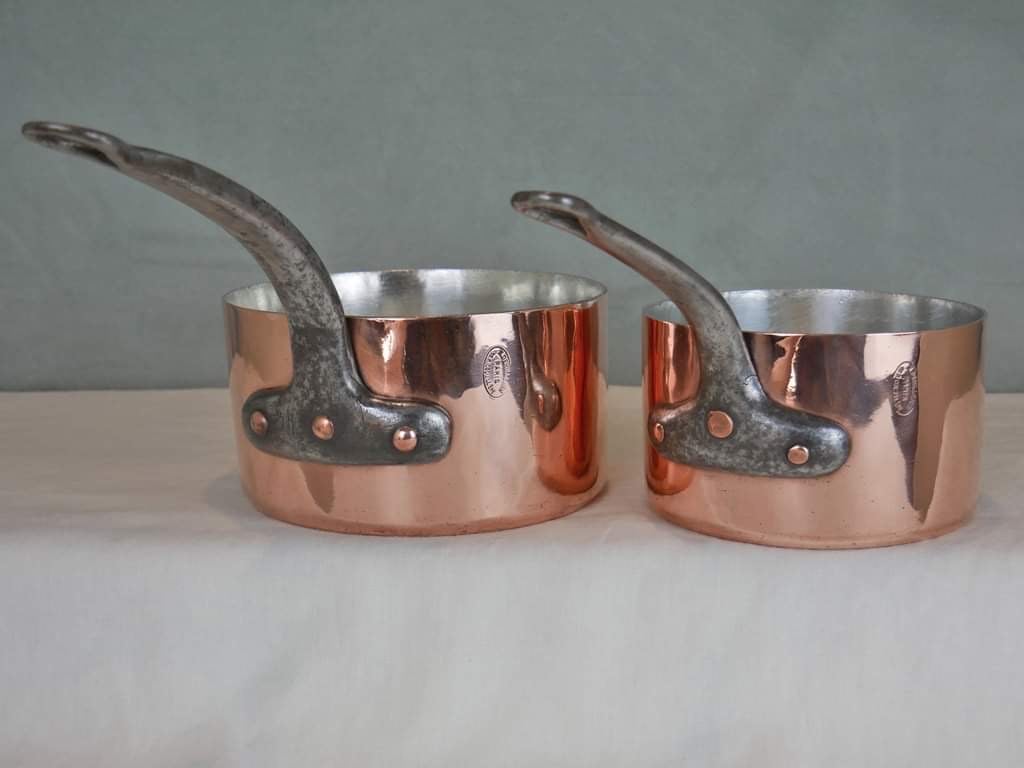
There is a third version of this stamp, shown below on a pot belonging to Martin. It is almost identical to the first version, but has small dots on either end between the top and bottom lines of text.
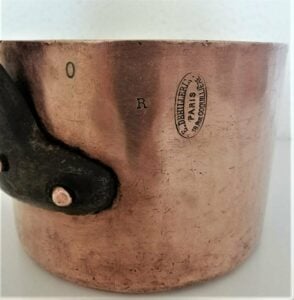 |
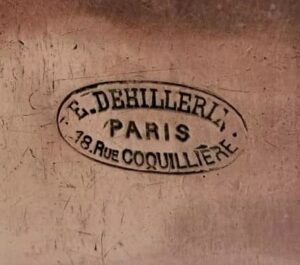 |
E. Dehillerin Paris oval
Reader Bryan P. found this, and it’s a new one for me. I was immediately struck (no pun intended) by this stamp’s strong similarity to the J. Gaillard Paris stamp at right — the same typestyle, the same line in the middle. My immediate supposition is that this Dehillerin mark is for Gaillard production. I’ve tentatively dated this Gaillard stamp to the 1930s-1940s, and if the association is correct, this Dehillerin stamp would logically be from the same time period.

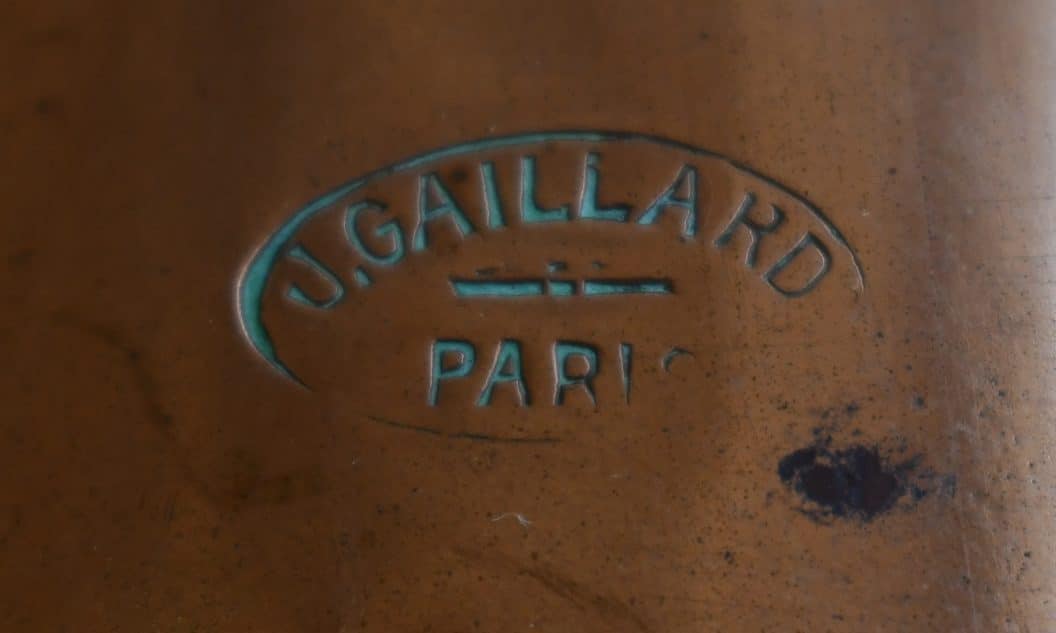
The example from which this Dehillerin stamp photo taken is an interesting one: an oval cocotte with dovetails. I’ve long maintained that dovetailing was being phased out by the 1920s in favor of welding or machine pressing; a dovetailed oval pan in the 1930s would be late. I would love to find more examples with this Dehillerin/Gaillard mark to get more information on the craftmanship in practice when this stamp was used.
Horizontal oval with street address and dots
This version has “E. DEHILLERIN 18. RUE COQUILLIÈRE” without the word Paris inside an oval with circular dots at either end. Those circular dots and the missing Paris distinguish this mark from the ones above.
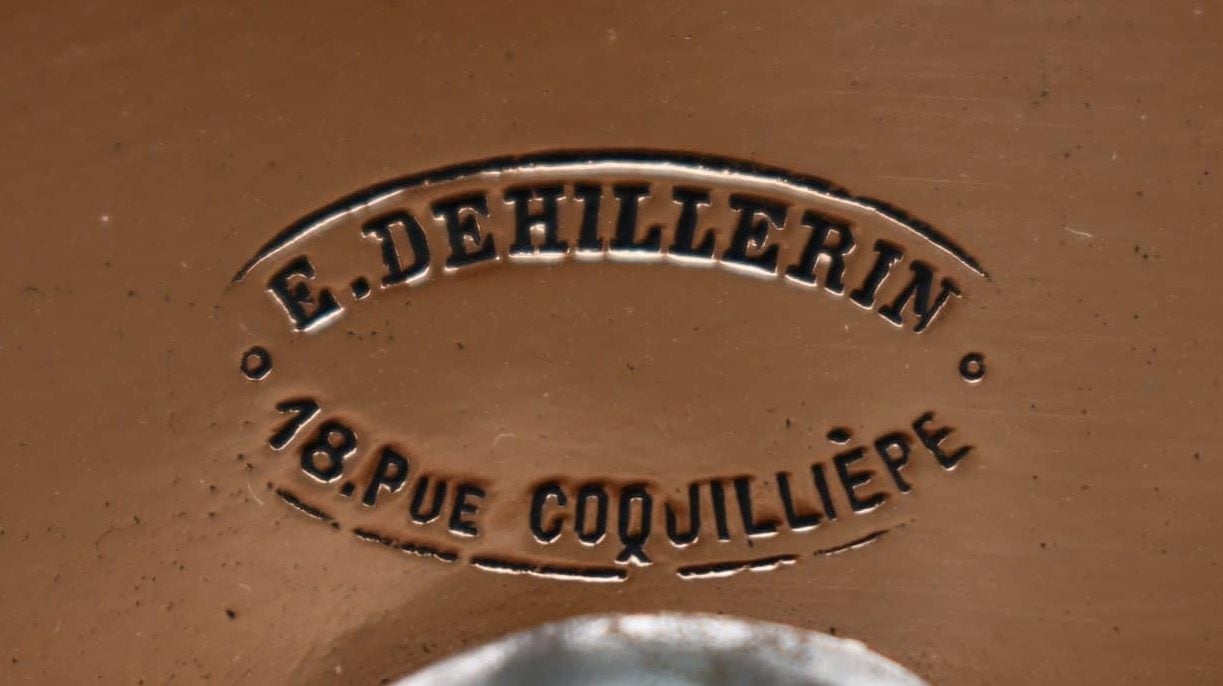
Here’s an example pan I have with this mark, a 28cm saucepan.
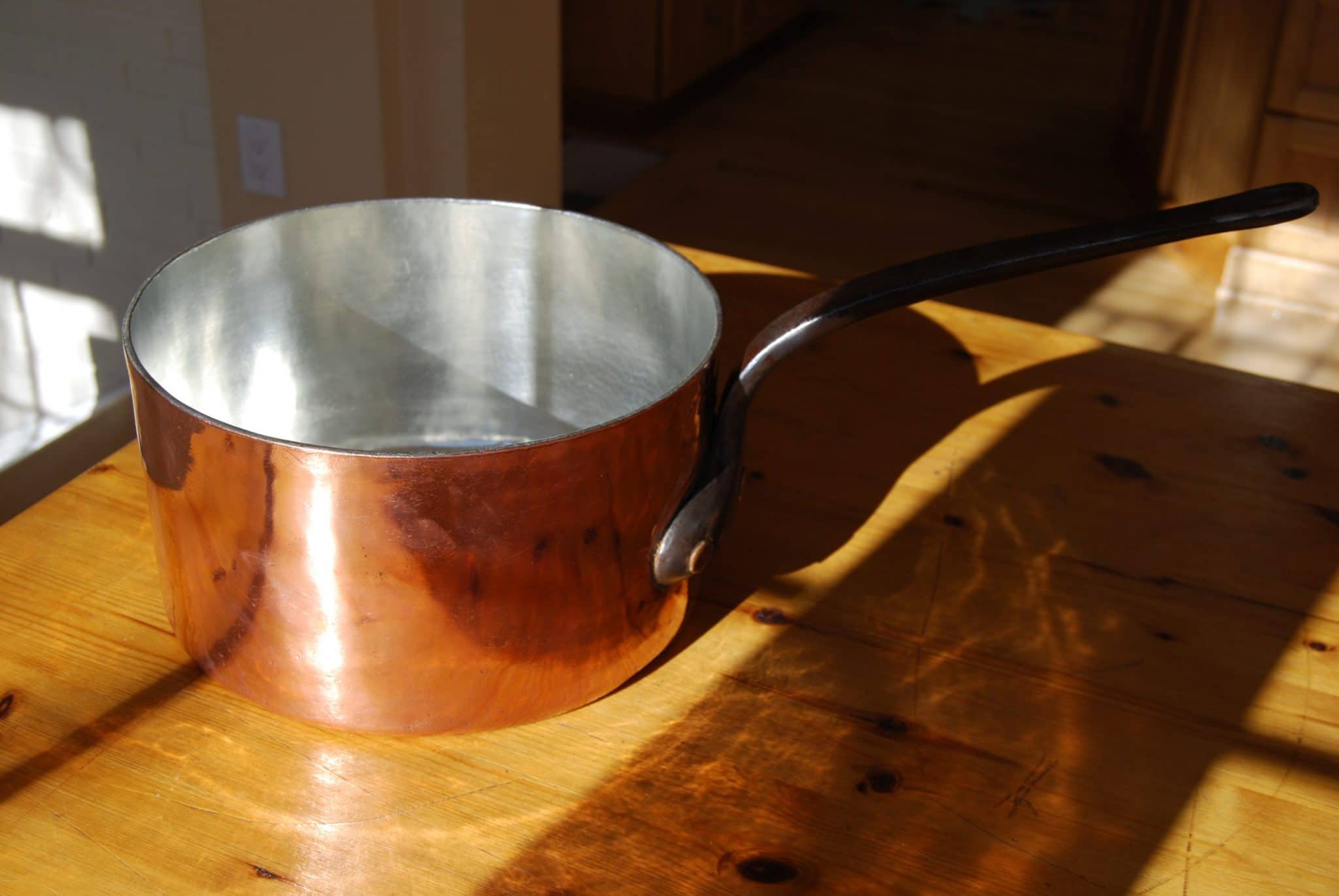
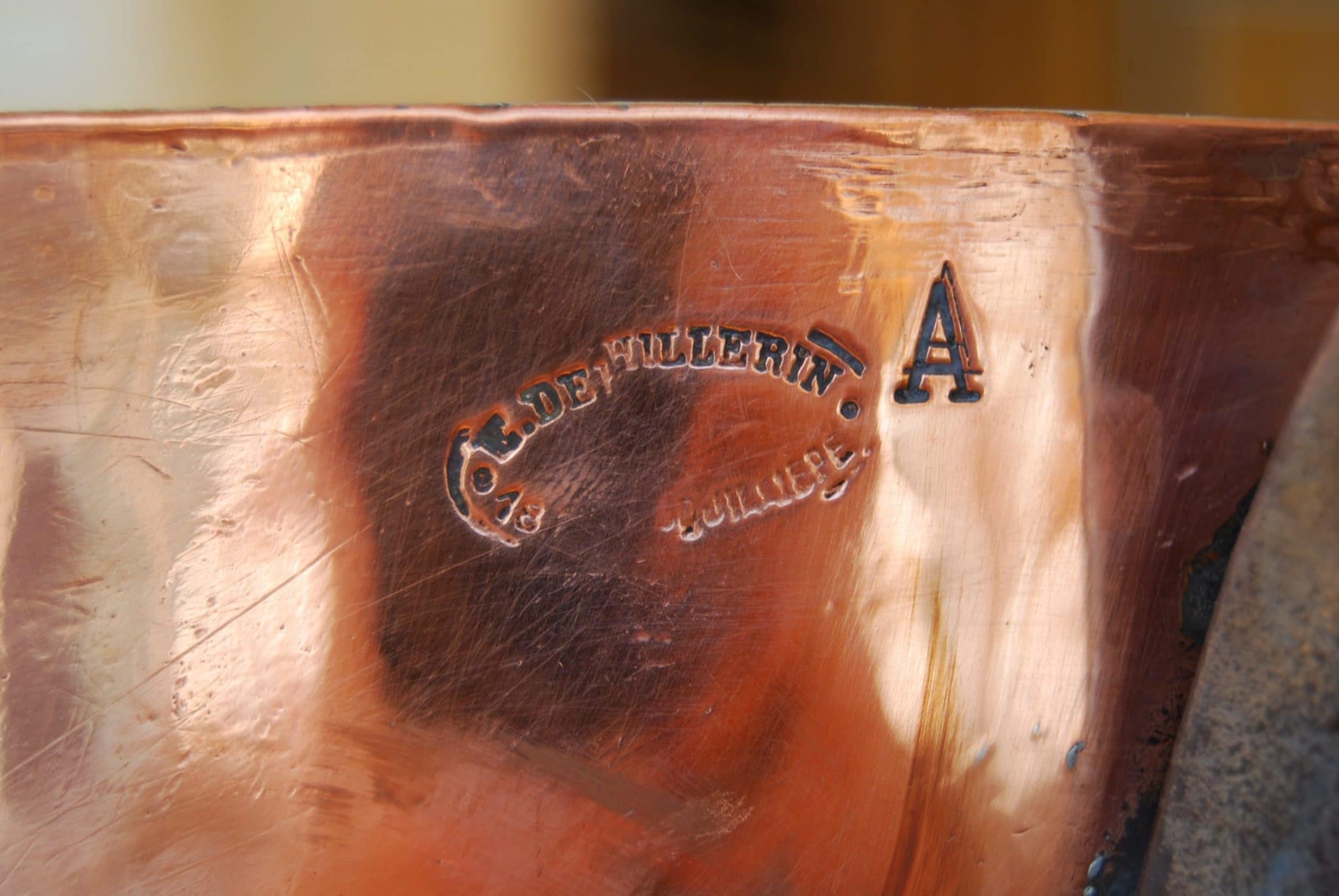
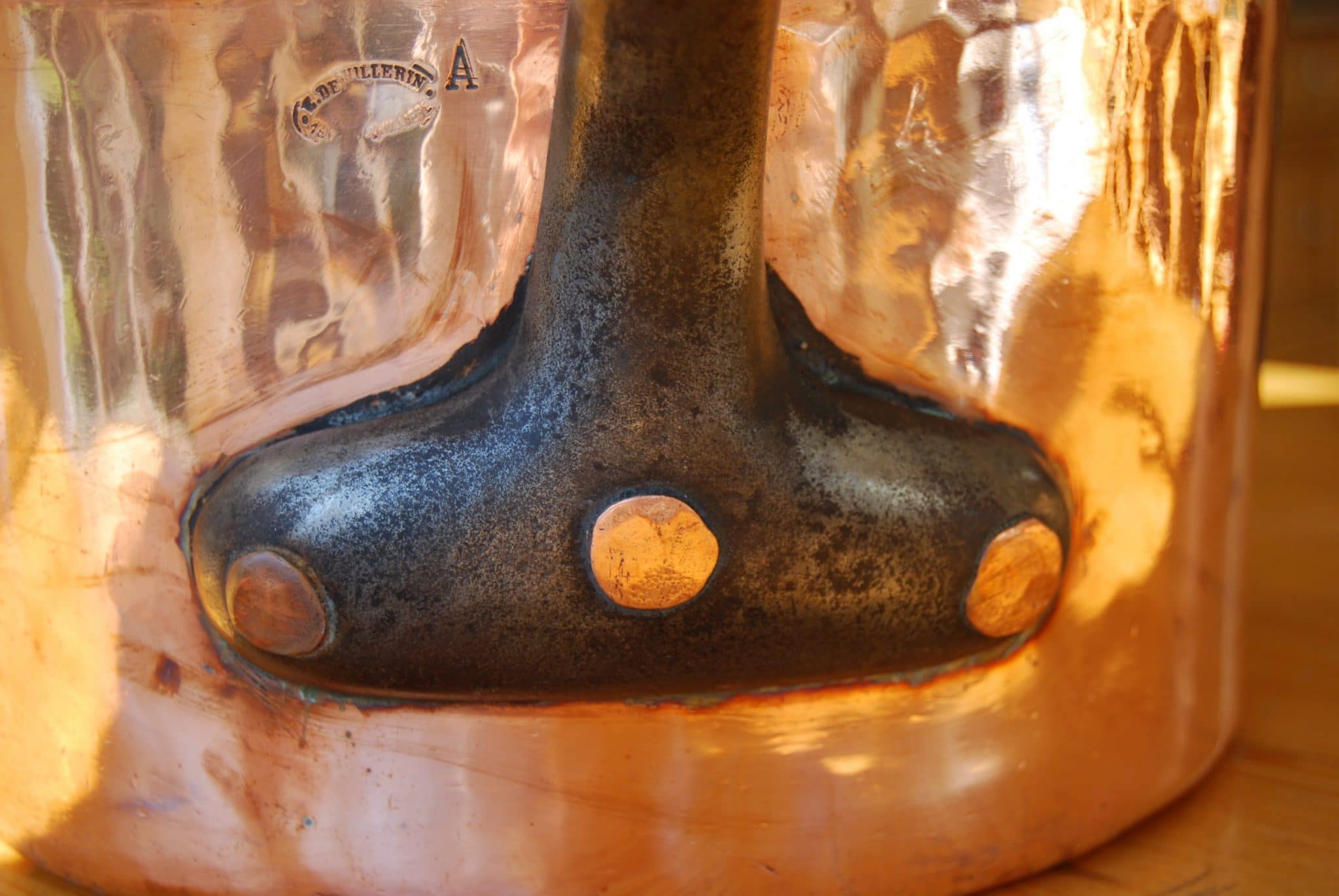

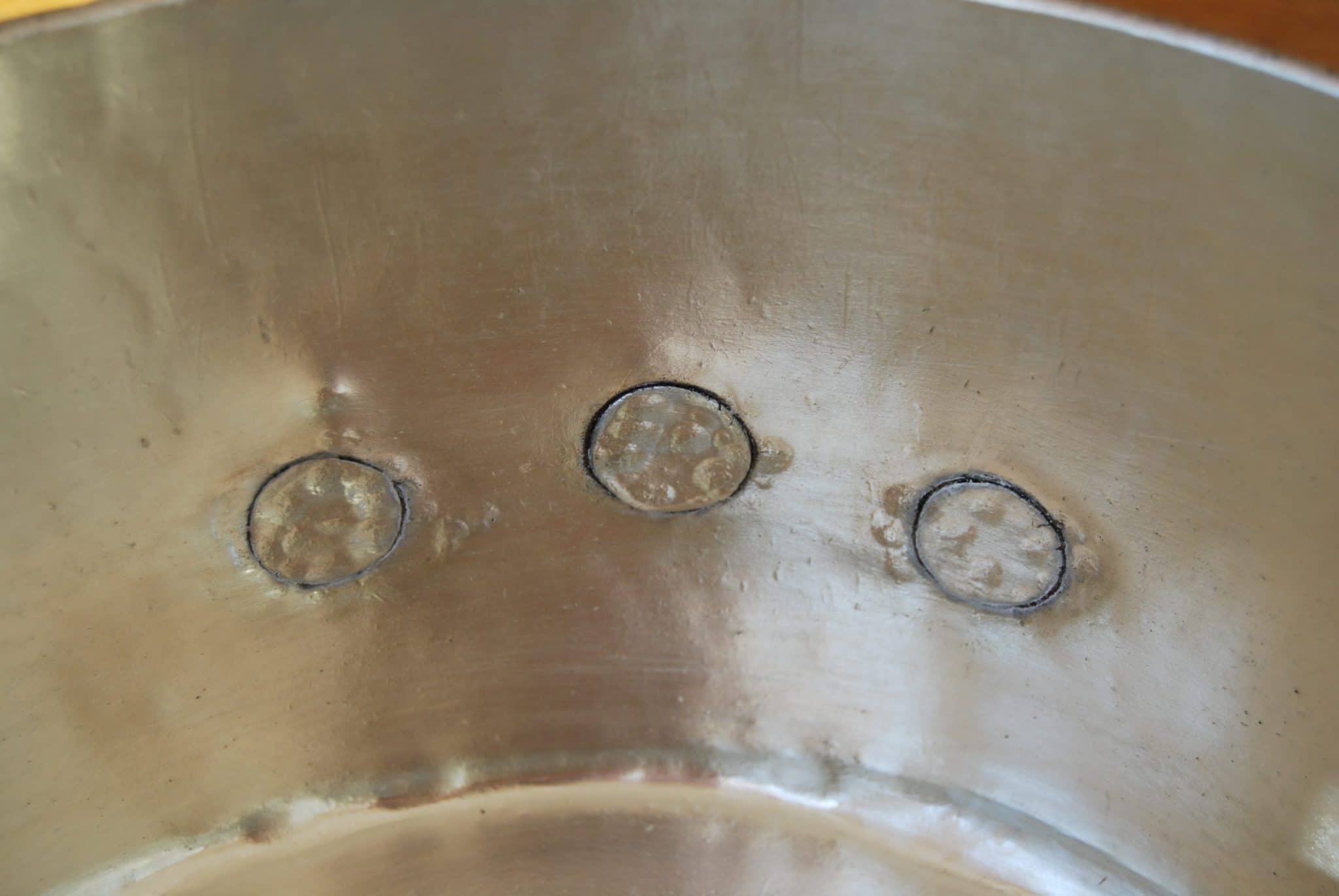
This pan has fat flattened exterior rivets and flush-finished interior rivets, very similar to the ones above, which gives it a late 19th to early 20th century feel.
However, I would note that the copper bowl in Julia Child’s collection at the Smithsonian — photo here — has that very same stamp. Either this stamp was in use on pans being sold from 1948 to 1952 (when Julia was buying them) or Julia dug a rather old bowl out of a pile at the store (which we know is still a regular phenomenon) that bore an older stamp. If you held a piece of tiramisu before me and told me you demanded my opinion or NO TIRAMISU, I’d say that this mark is from the first half of the 20th century, up to World War II, Julia’s purchase notwithstanding.
Horizontal oval with street address, no line
To be completely honest with you, I’m not entirely sure this mark is different from the one with dots just above. The one above is not deeply stamped and it’s possible that if the same stamp (and stamper) were at work here, that the dots and oval line would not have shown up. I only have one pot like this, so it’s hard to tell if this is just a one-off stamping aberration.
But let’s assume for the moment that this is a distinct stamp of an oval shape with “E. DEHILLERIN 18. RUE COQUILLIÈRE” without the word Paris and with no oval outline and no dots.
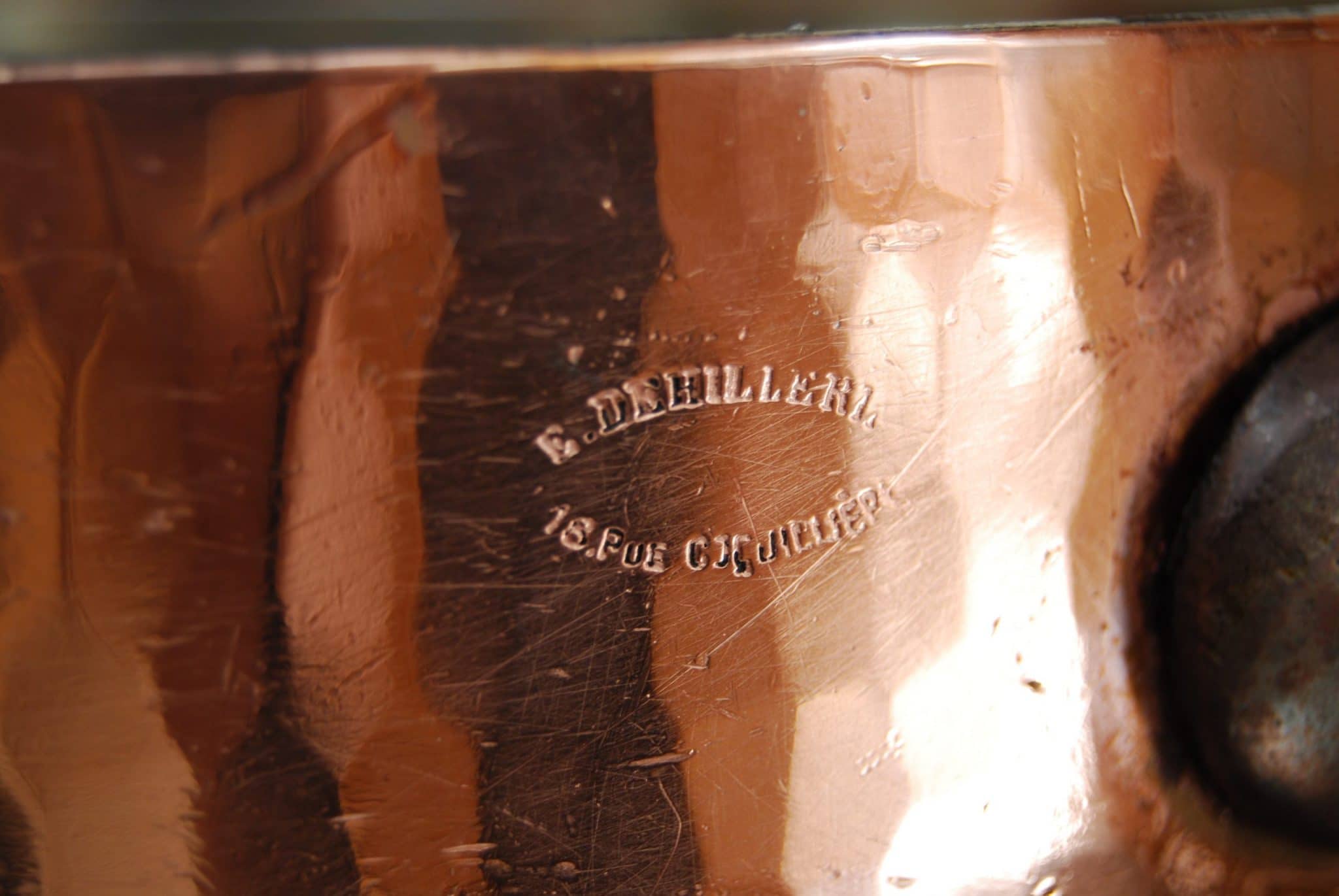
The pan I have with this mark is a 26cm sauté.
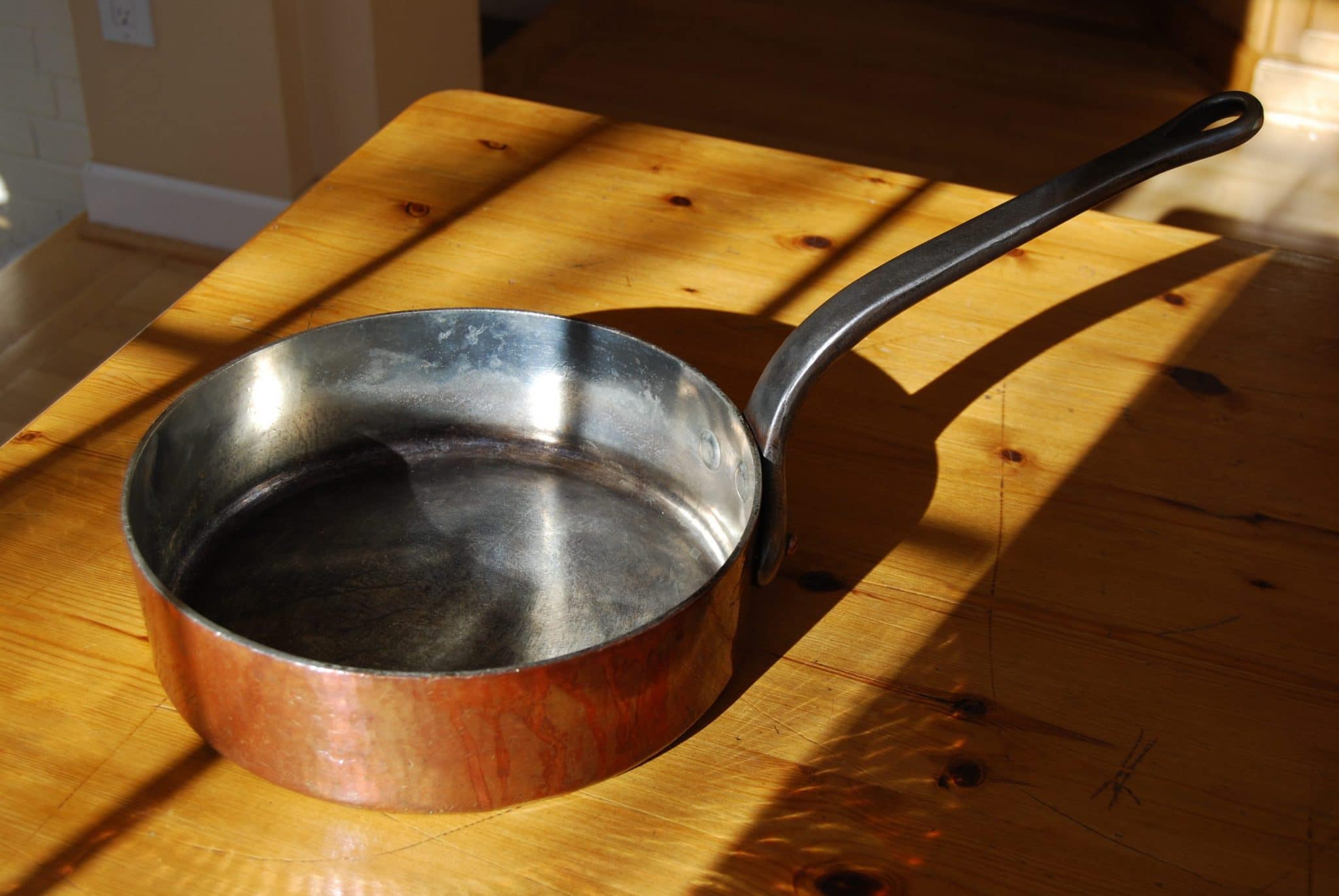

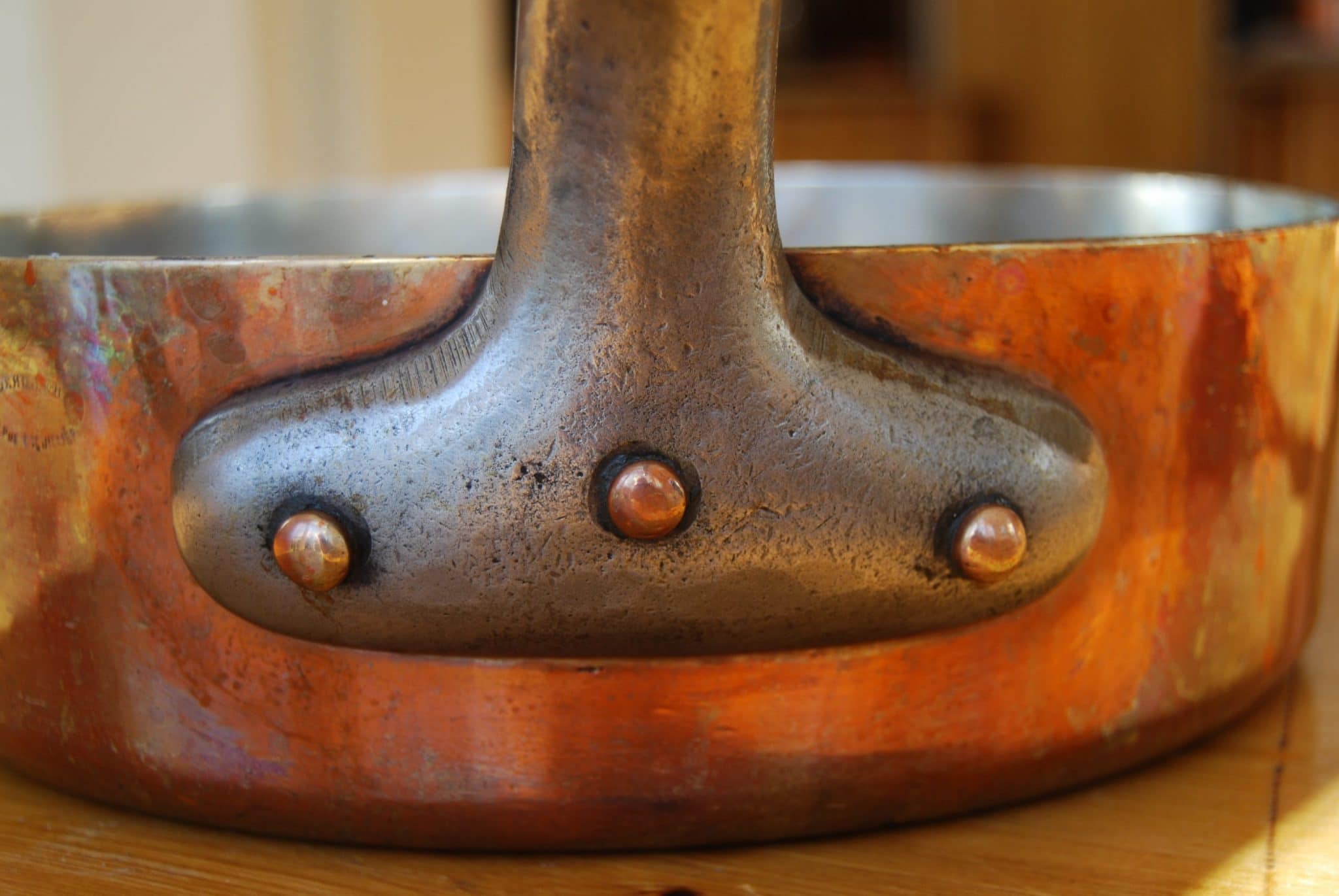
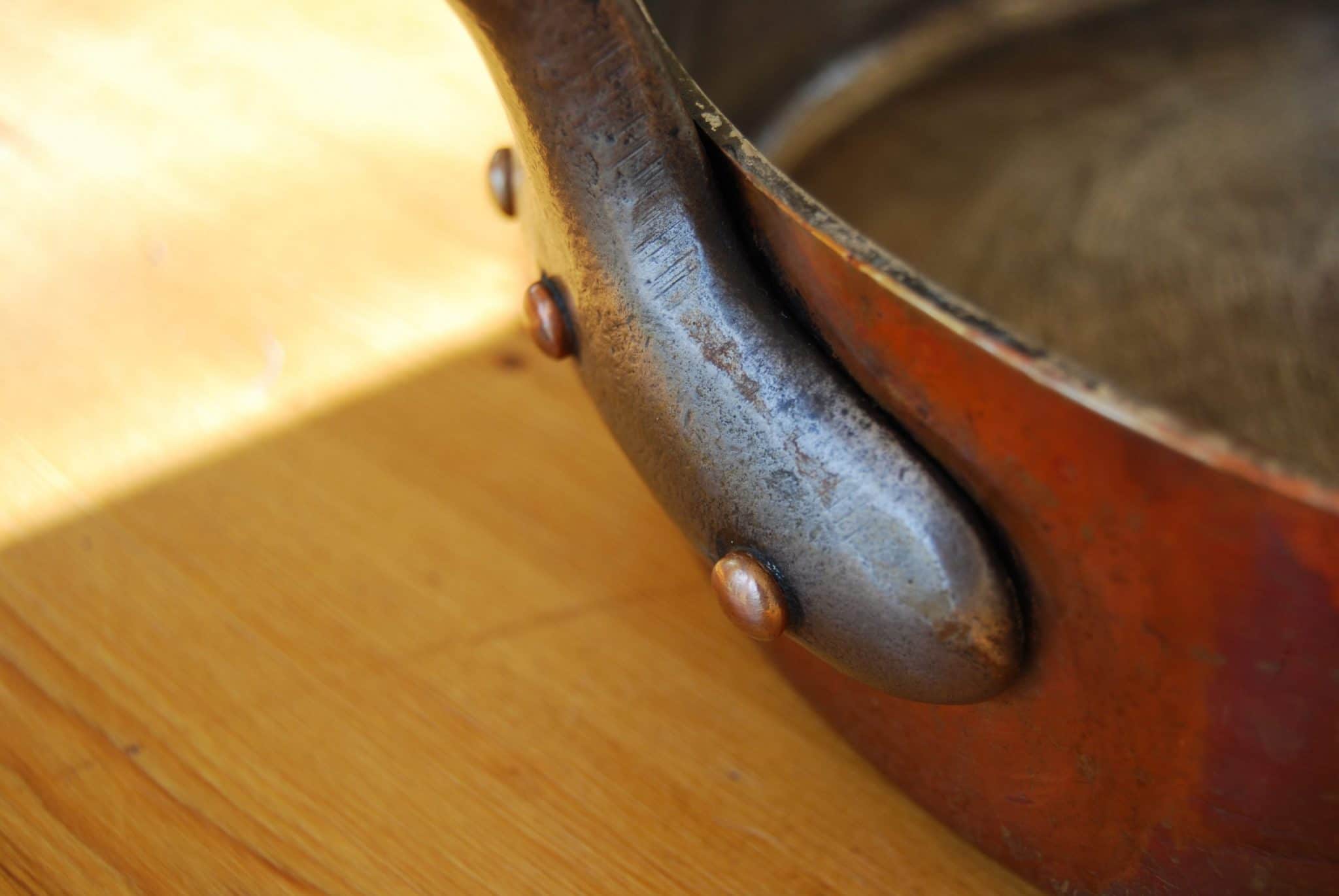
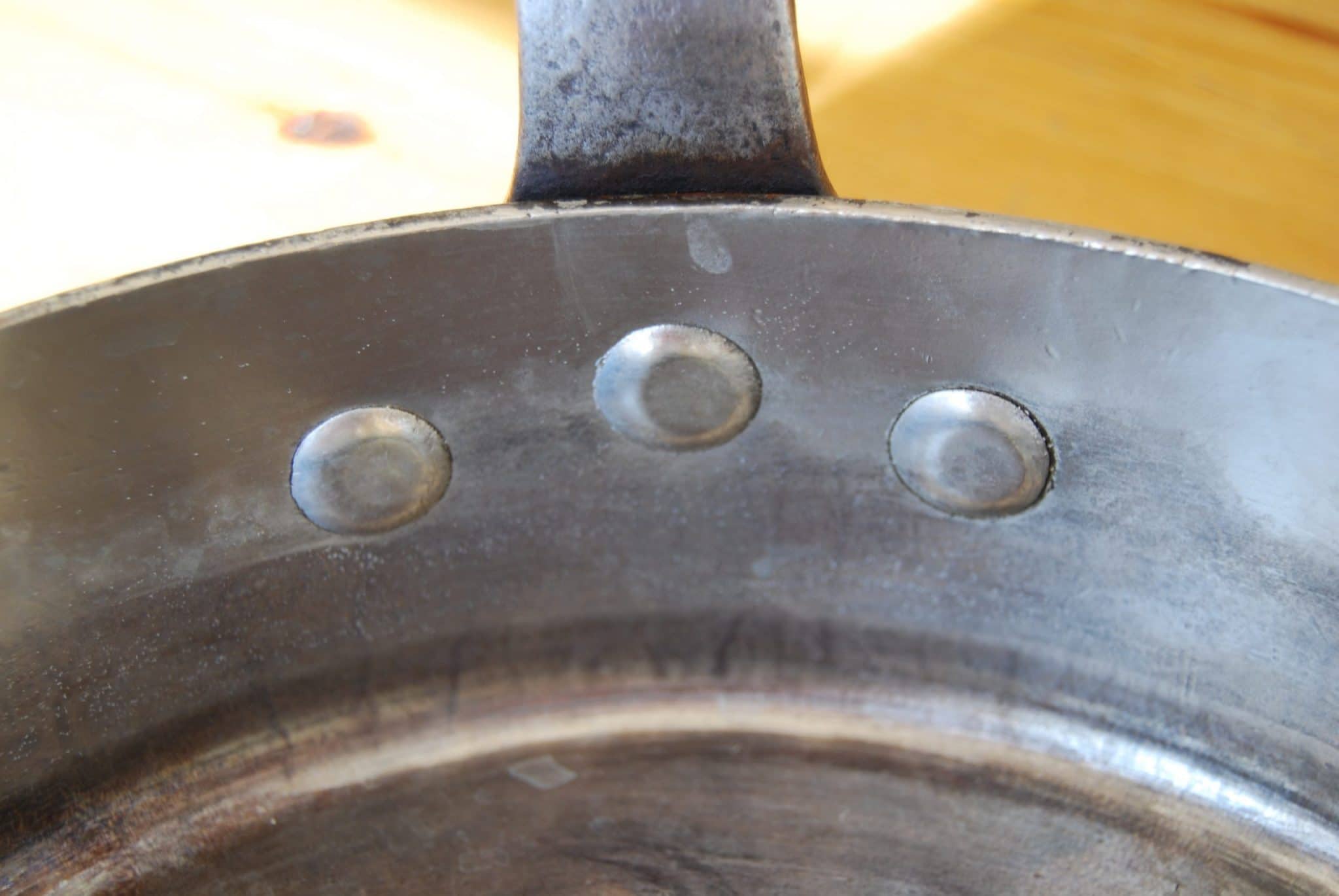
Regardless of the stamp issues, I see a significant difference between this pan and the ones above. Either this represents a significant leap forward into modernity for Dehillerin’s production or this pan was made by another maker.
The rivets are very different: on the exterior, they’re smaller and rounded; on the interior, they’re pounded slightly flat, but no longer flush-set against the interior surface. The iron handle is different as well — compare this handle to the handle on the pan just above. The base plate on this pan’s handle is more bulbous.
My gut feeling is that this is a more modern mark. The exterior rivets have a rounded shape that looks machined, the same appearance as rivets we see on pots today. The iron handle is also a modern style. The stamp has the Dehillerin address on it, but Dehillerin had been stamping other people’s pots for a while already, so that’s not necessarily an indication of provenance.
I think this is a 1920s-1940s pan, and if it’s Dehillerin made, part of the last production. (No withholding of tiramisu required for this opinion.)
WWII to late 1950s (?)
Dehillerin closed its copper-making facility in the 1940s, so after WWII, Dehillerin copper is Mauviel and, I suspect, also Gaillard. The stamps no longer have the 18 rue Coquilliere street address. I suspect that stamps without the Dehillerin street address were used by outsourced providers (Mauviel, Gaillard, et cetera) after Dehillerin closed its own chaudronnerie after World War II.
E. Dehillerin Paris arched
This is a simple text stamp that reads “E. DEHILLERIN” over the word “PARIS.”
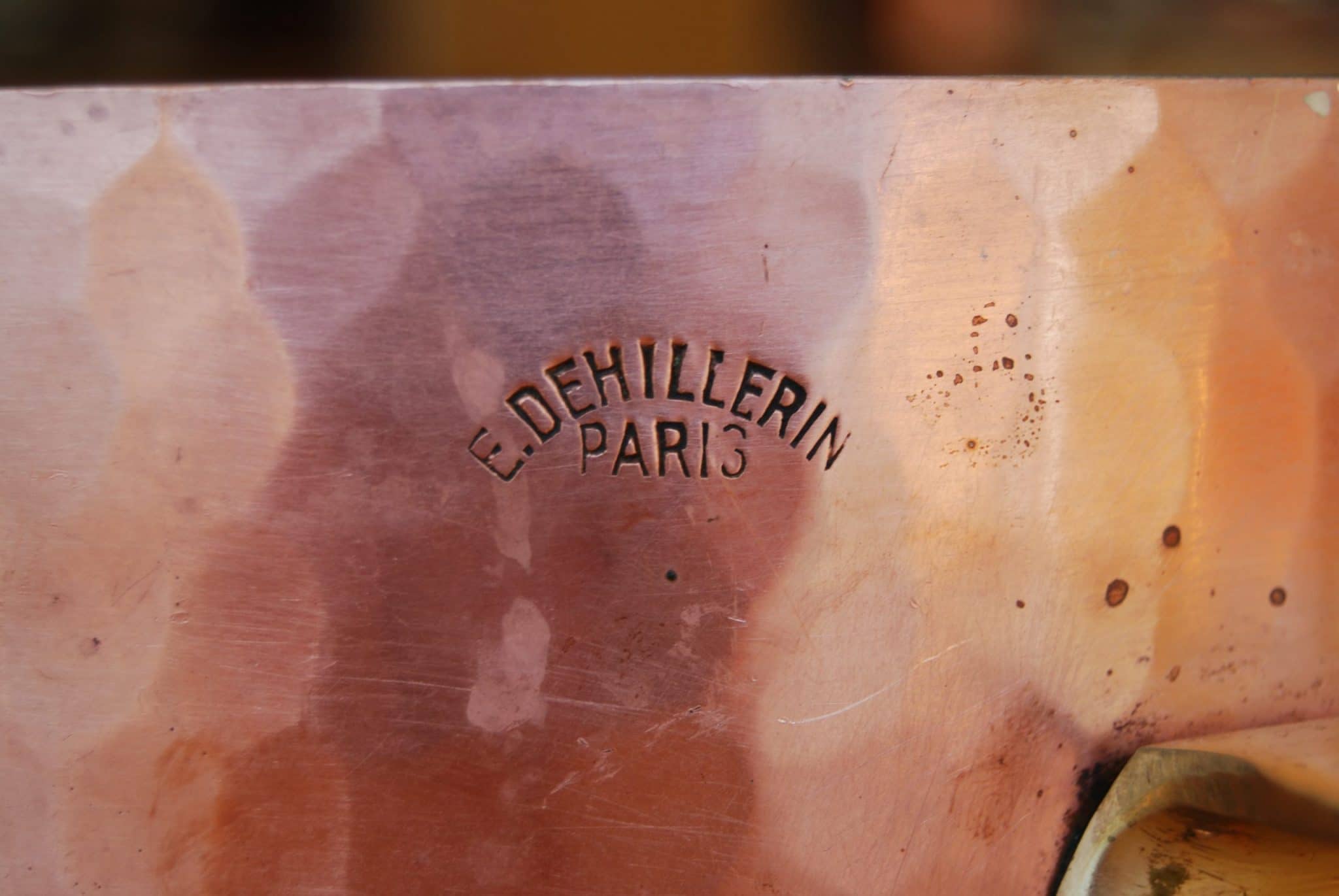
I have three pans with this mark: small (16cm) and medium (20cm) Pommes Anna pans and a 20cm Windsor.
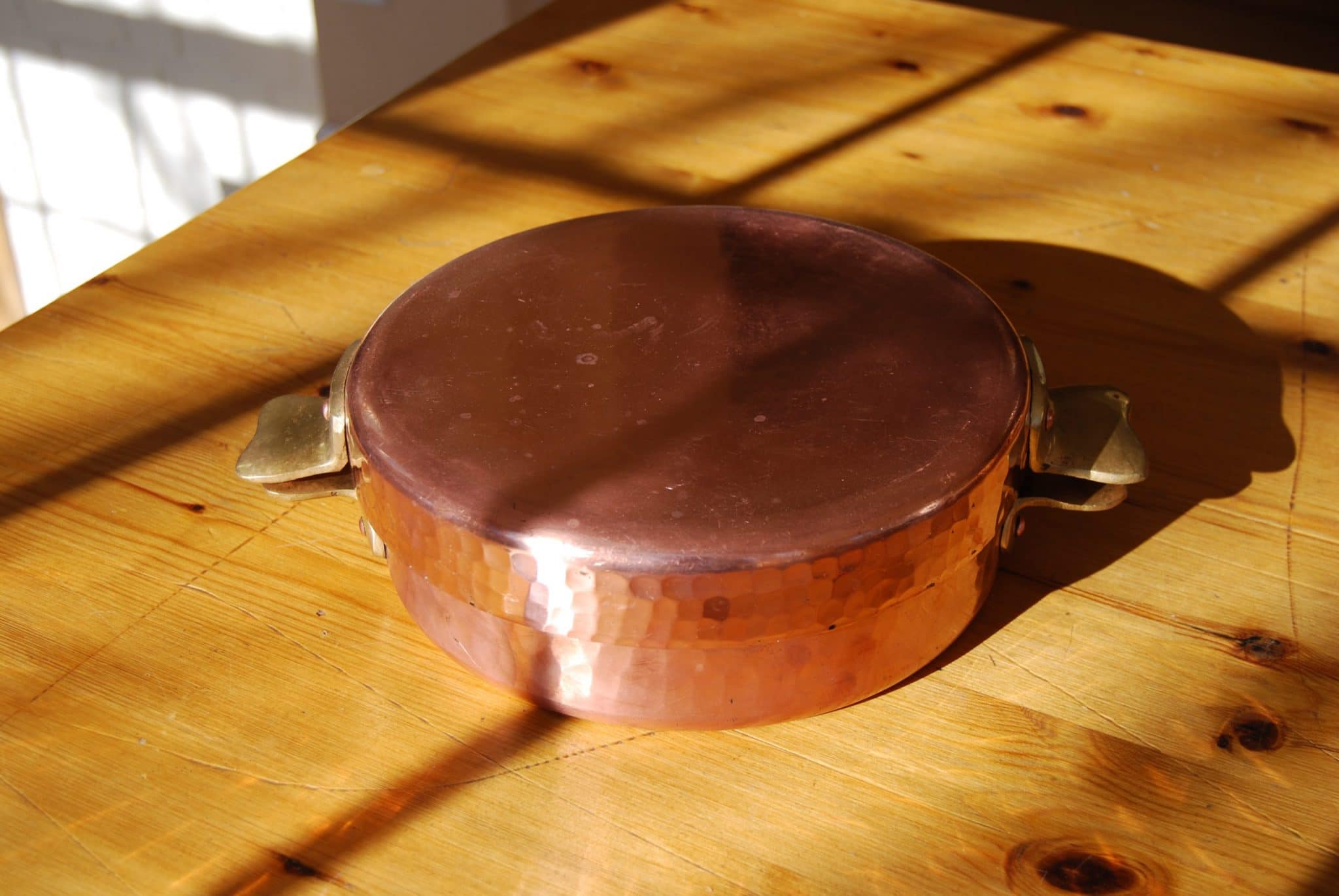

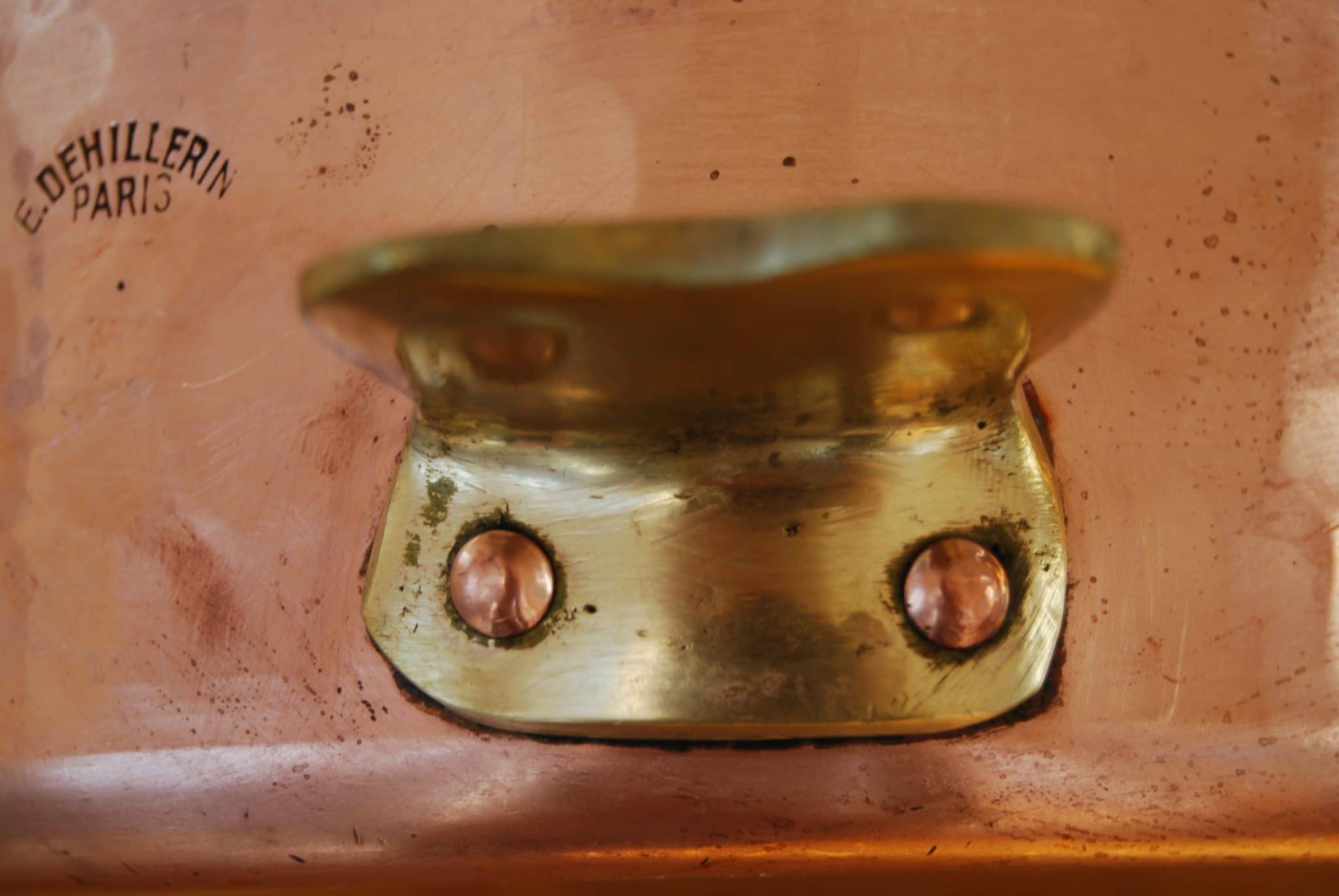

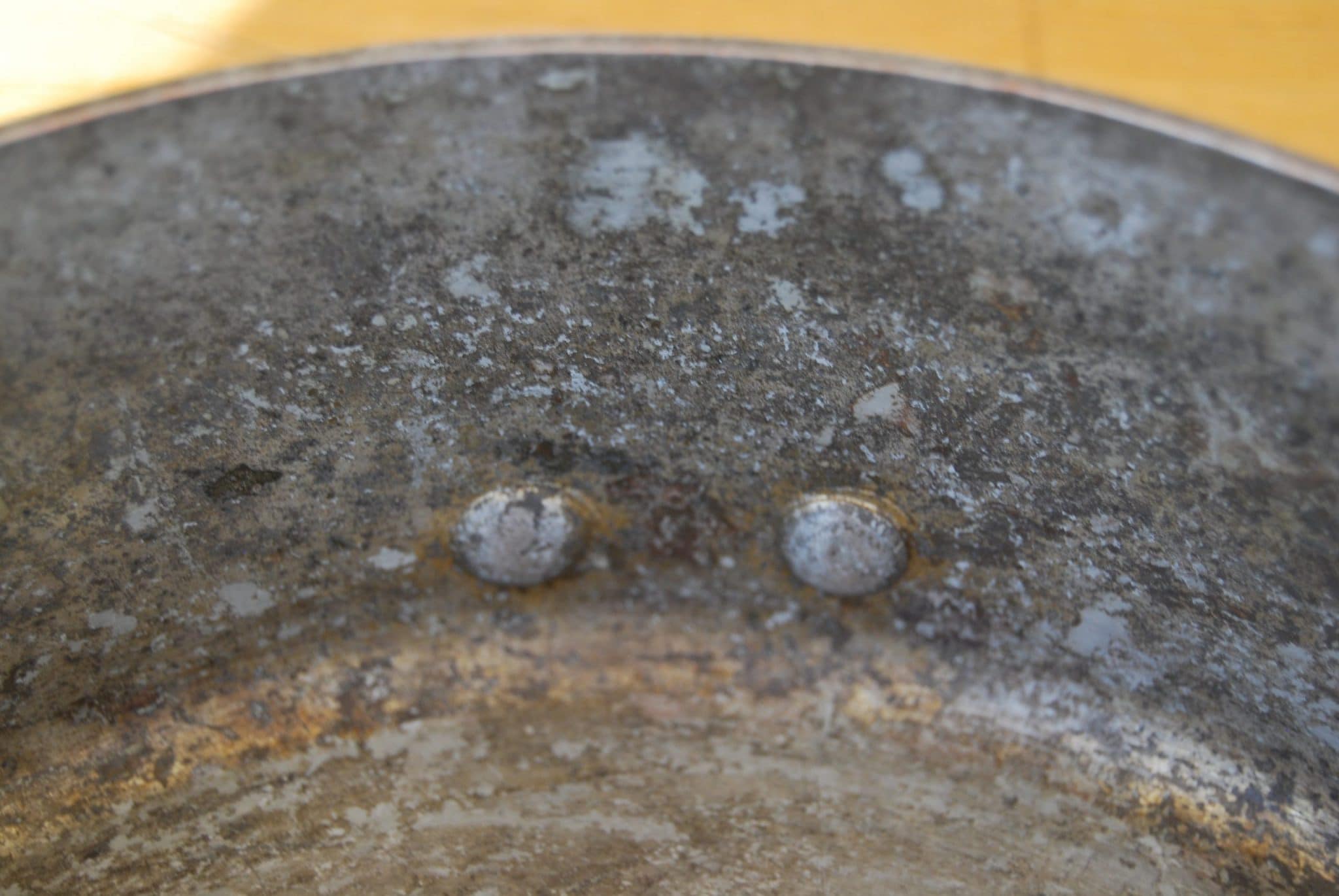
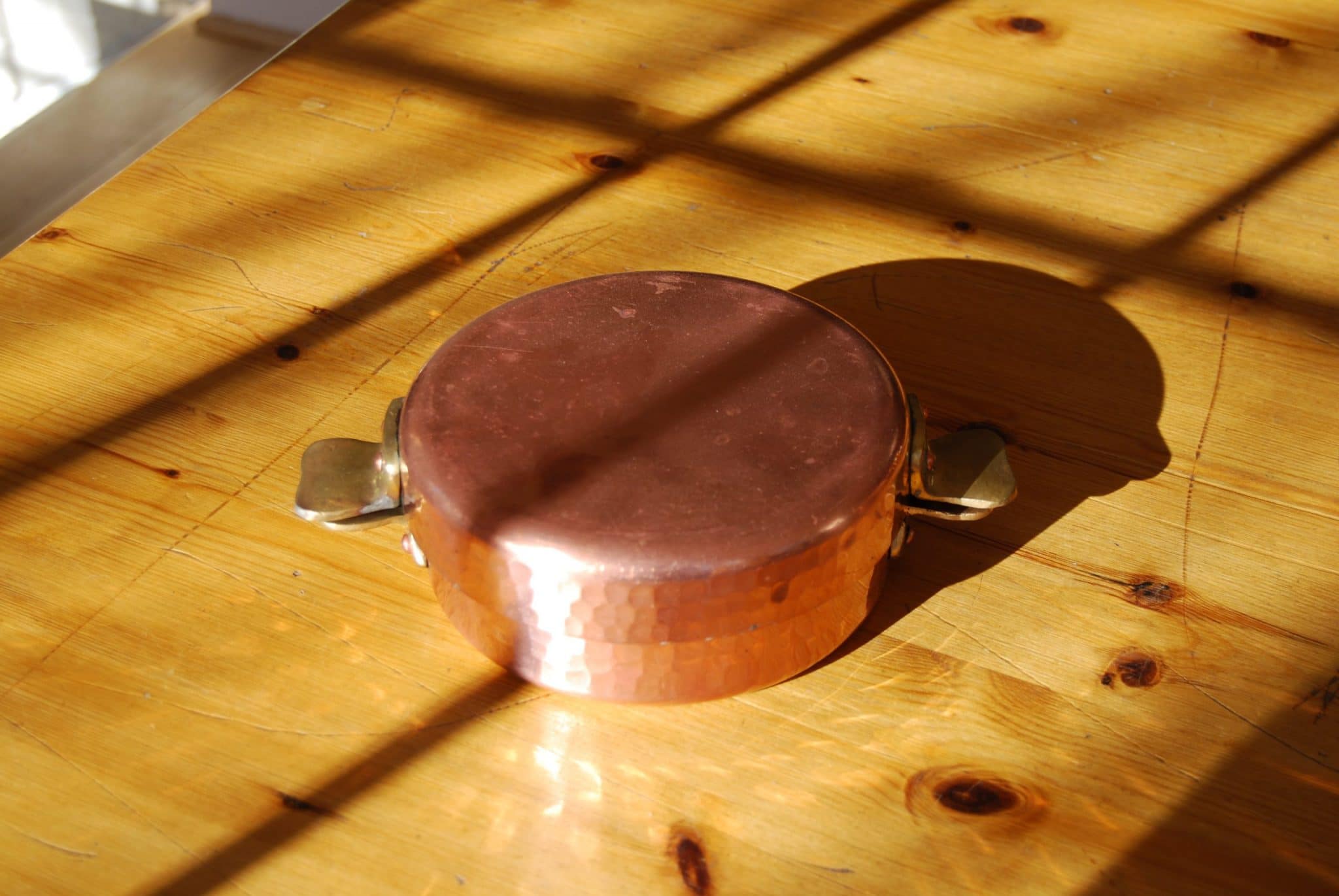
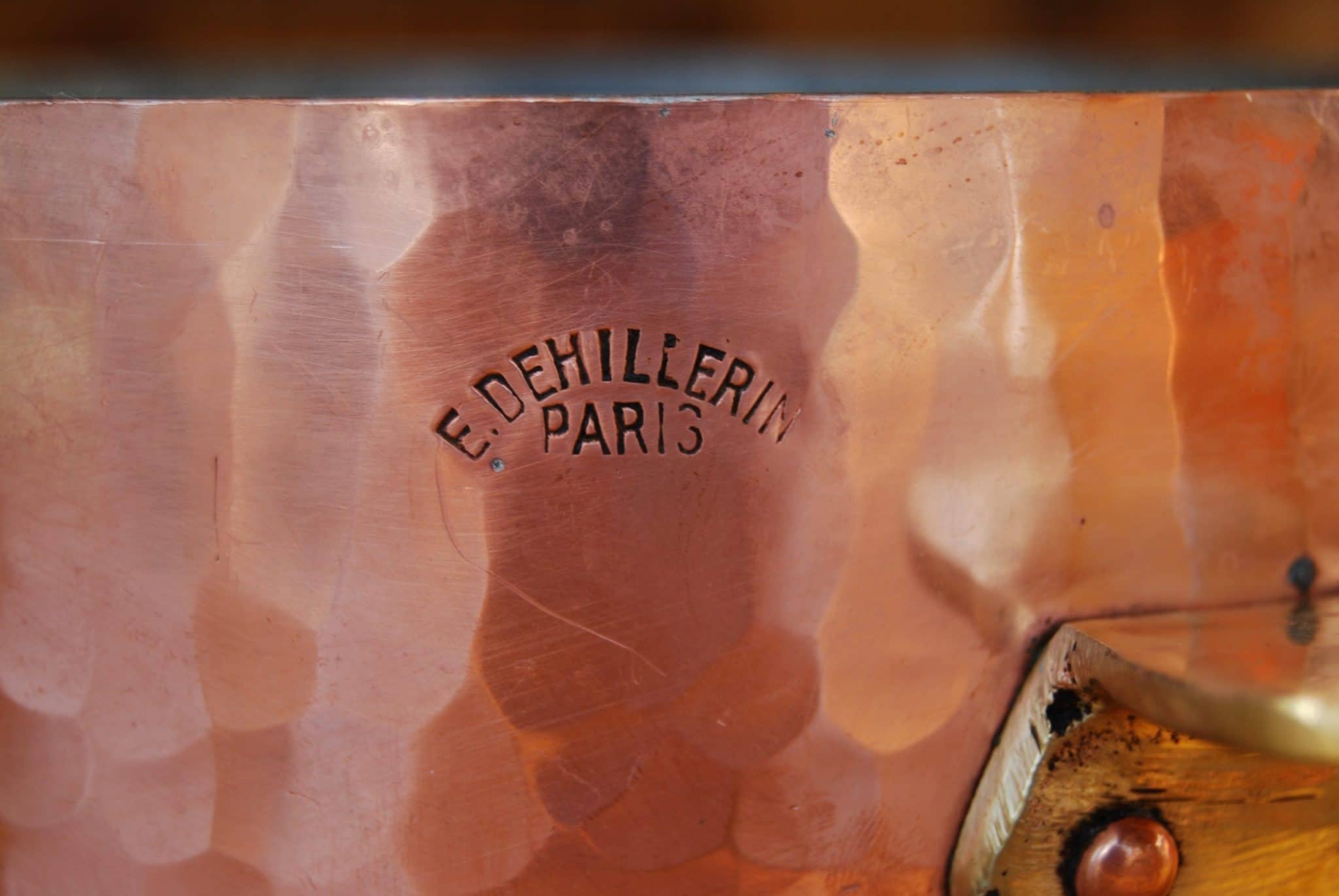
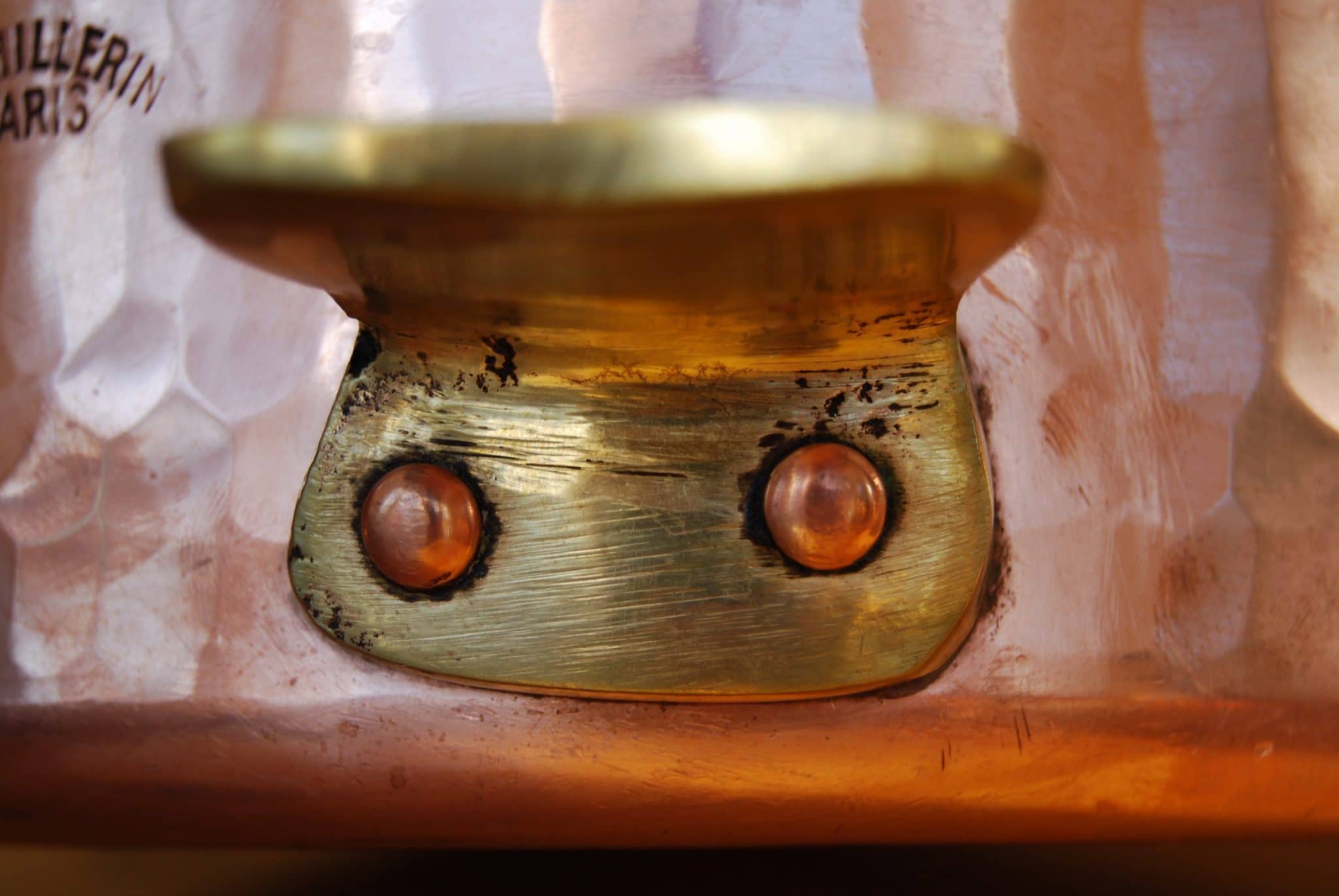

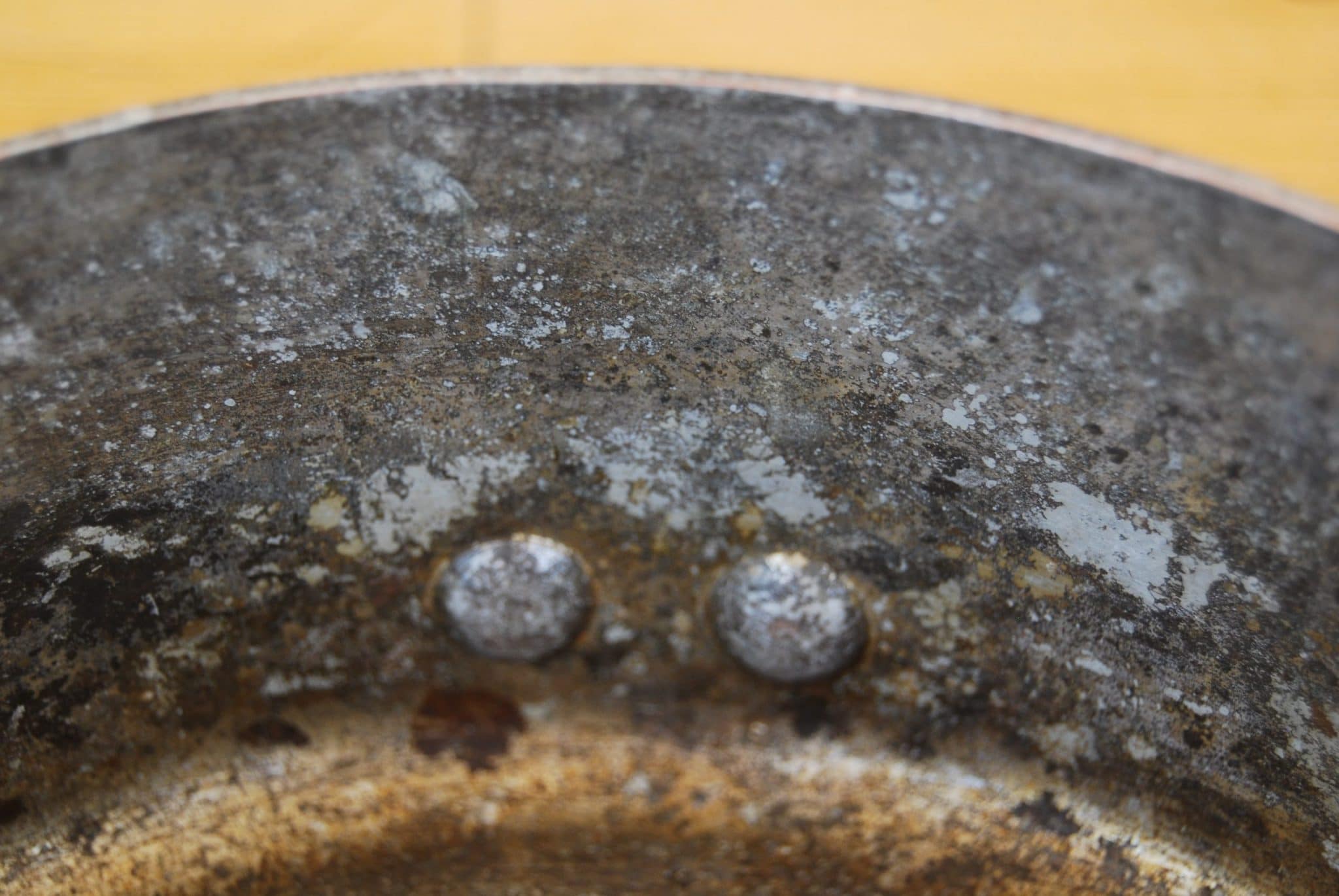
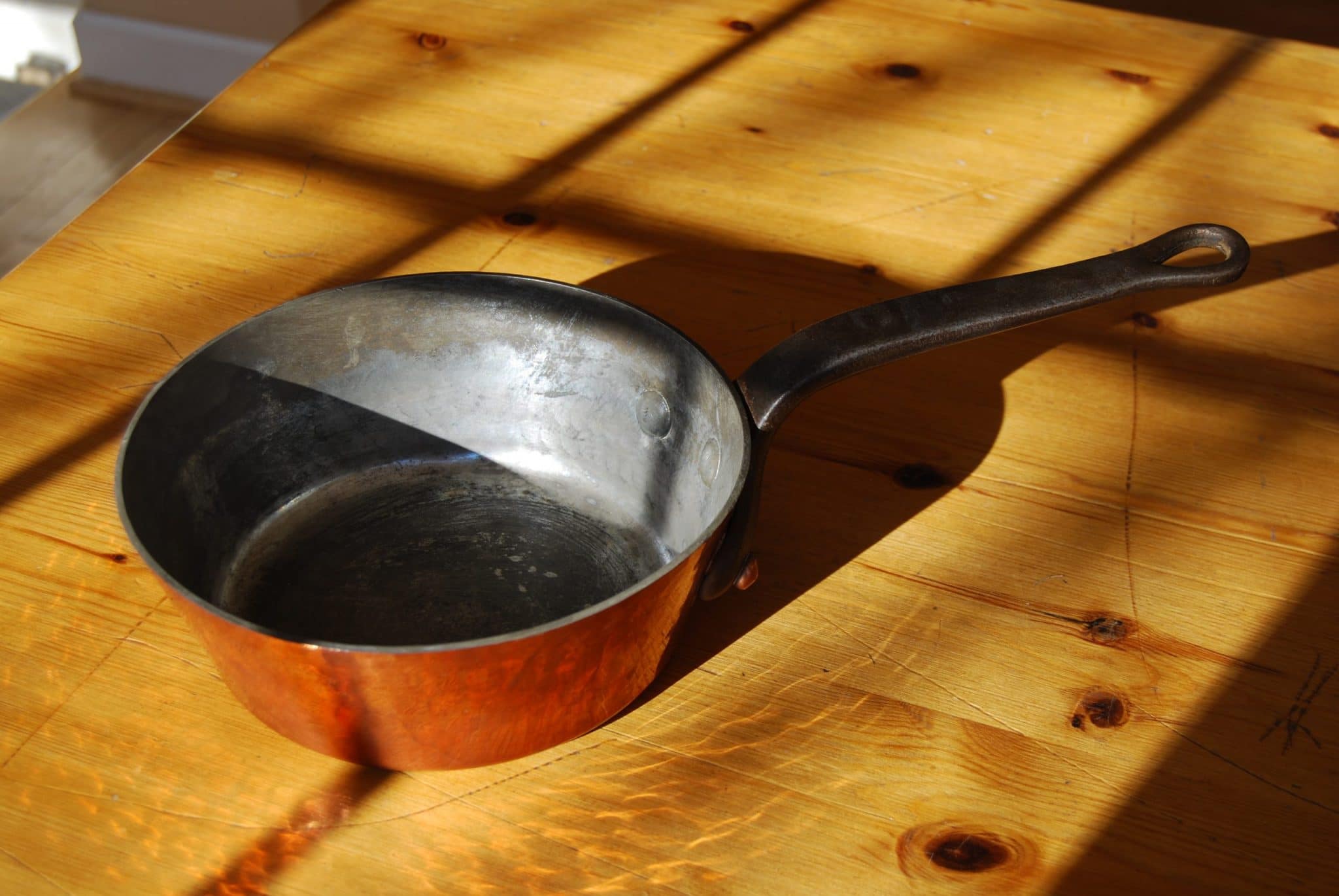
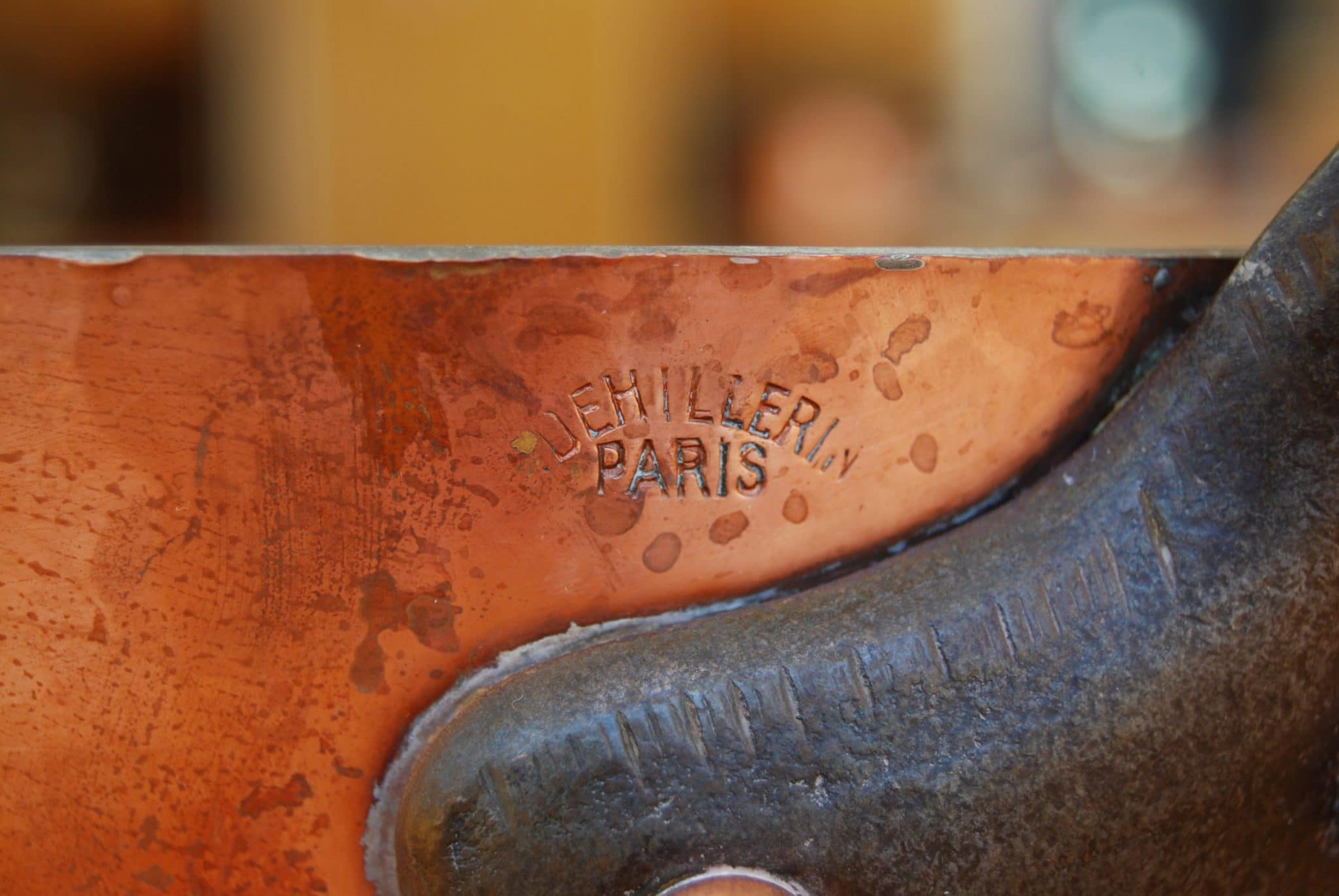
The rivets on the Pommes Anna handles are charmingly out of alignment, in my opinion, and I conclude they’re hand-punched, but in every other way these pans feel to me to be of the modern era, perhaps during the 1950s to 1980s. The internal rivets of the Pommes Anna are smoothly rounded, not flattened (and certainly not flush) as the ones we’ve seen above. And the rivets on the Windsor are a dead giveaway: do you see the numbers on them? I believe that’s a 17. These are size markings used to distinguish mass-produced rivets and are definitely 20th-century make.
Anecdotally, I have seen copper pots with this stamp that seem both older and more modern than the ones I have. For example, I’ve seen a stewpot with big hand-pounded rivets like those we see in my pieces above, as well as this same stamp on a pot alongside “Made in France,” which conclusively dates the pot to the 1970s or later. I am looking into whether this stamp indicates the work of Gaillard.
The E. Dehillerin oval
I have come to suspect that there are two versions of this stamp: an early one and a later one. They look very similar but the spacing is slightly different. I think the one on the left was in use earlier — perhaps 1930s into the 1960s — and the one on the right was in use later, into the 1980s.
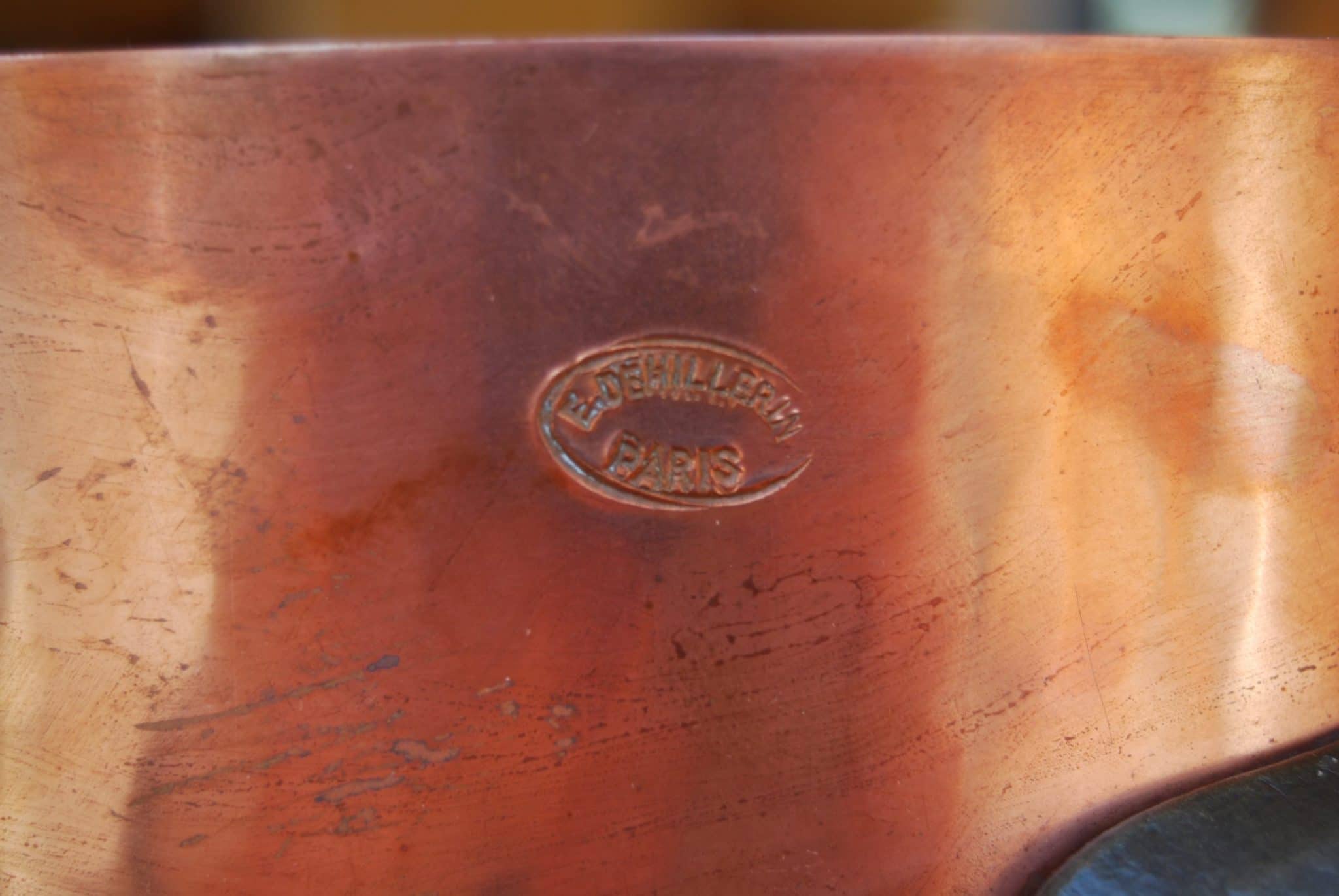

Early version
I think this stamp was in use prior to WWII and possibly into the 1960s. As evidence, Steve Nash at French Antiquity had a stewpot with this version of Dehillerin stamp along with the Blaser & Cie mark that my research suggests was only in use from 1928-1935. But I also have a saucepan with this stamp and a MADE IN FRANCE mark that I believe came into use after 1957 or so.

Here are my pommes Anna pan and my tinned saucepan with the MADE IN FRANCE mark.
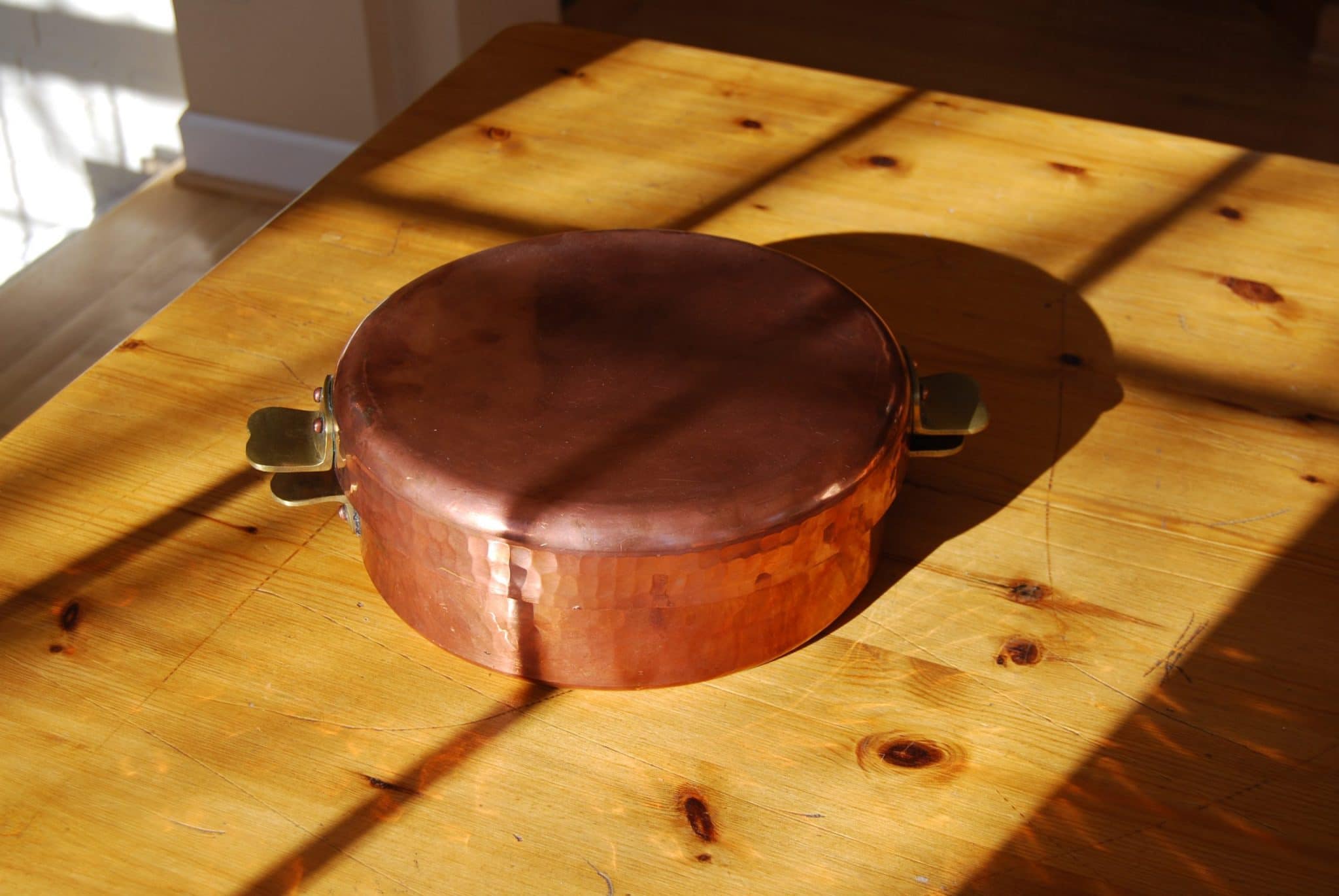
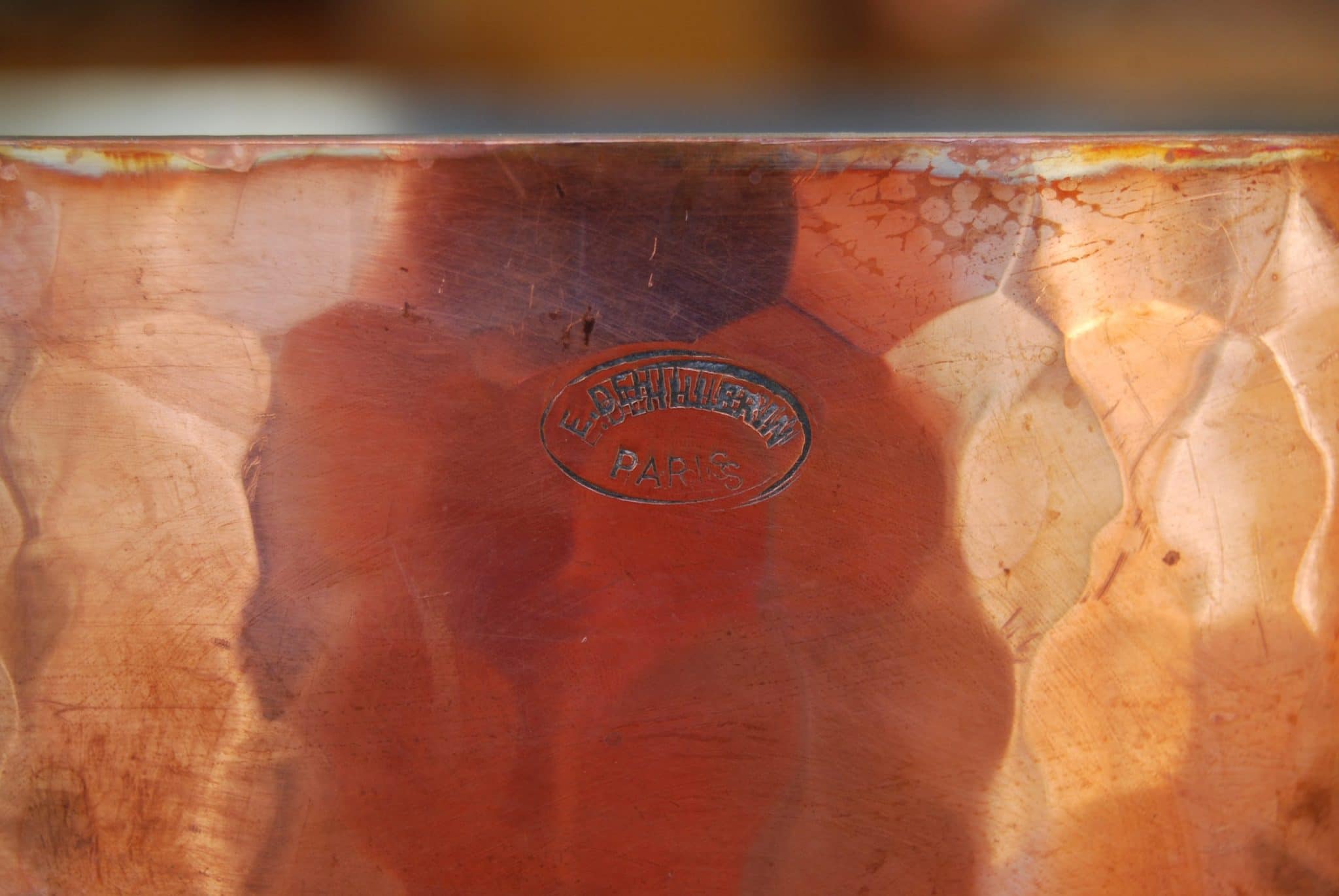
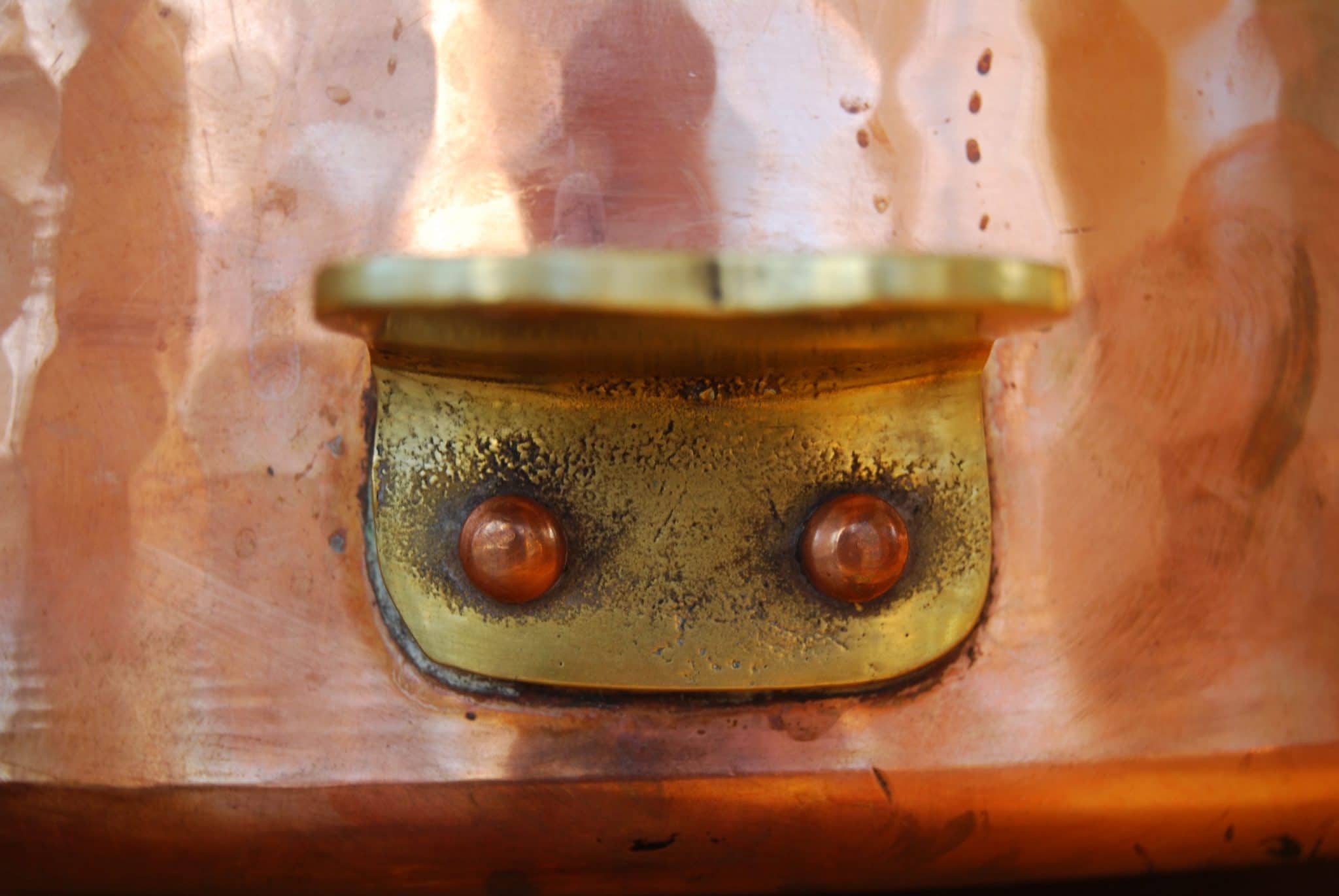
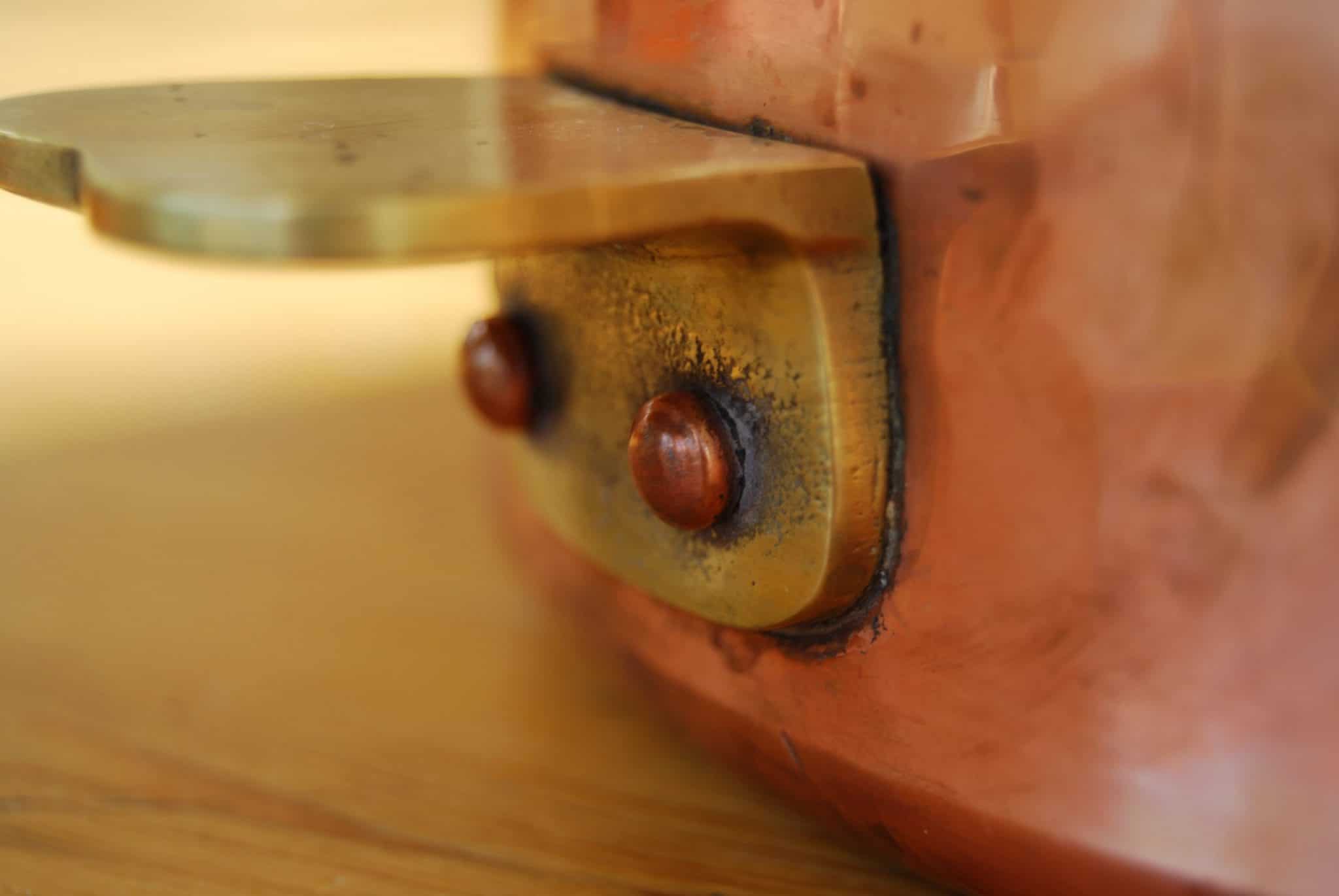
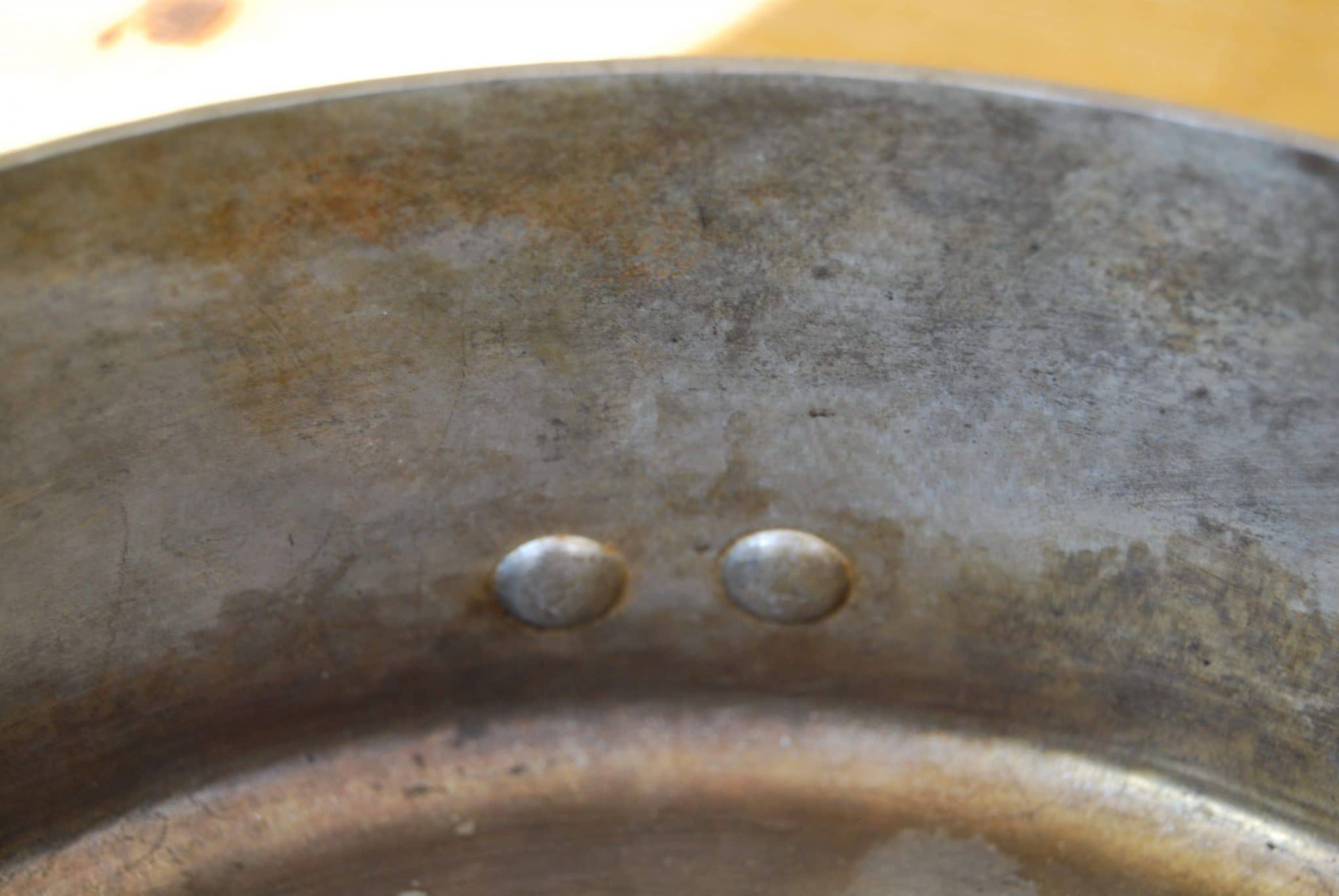
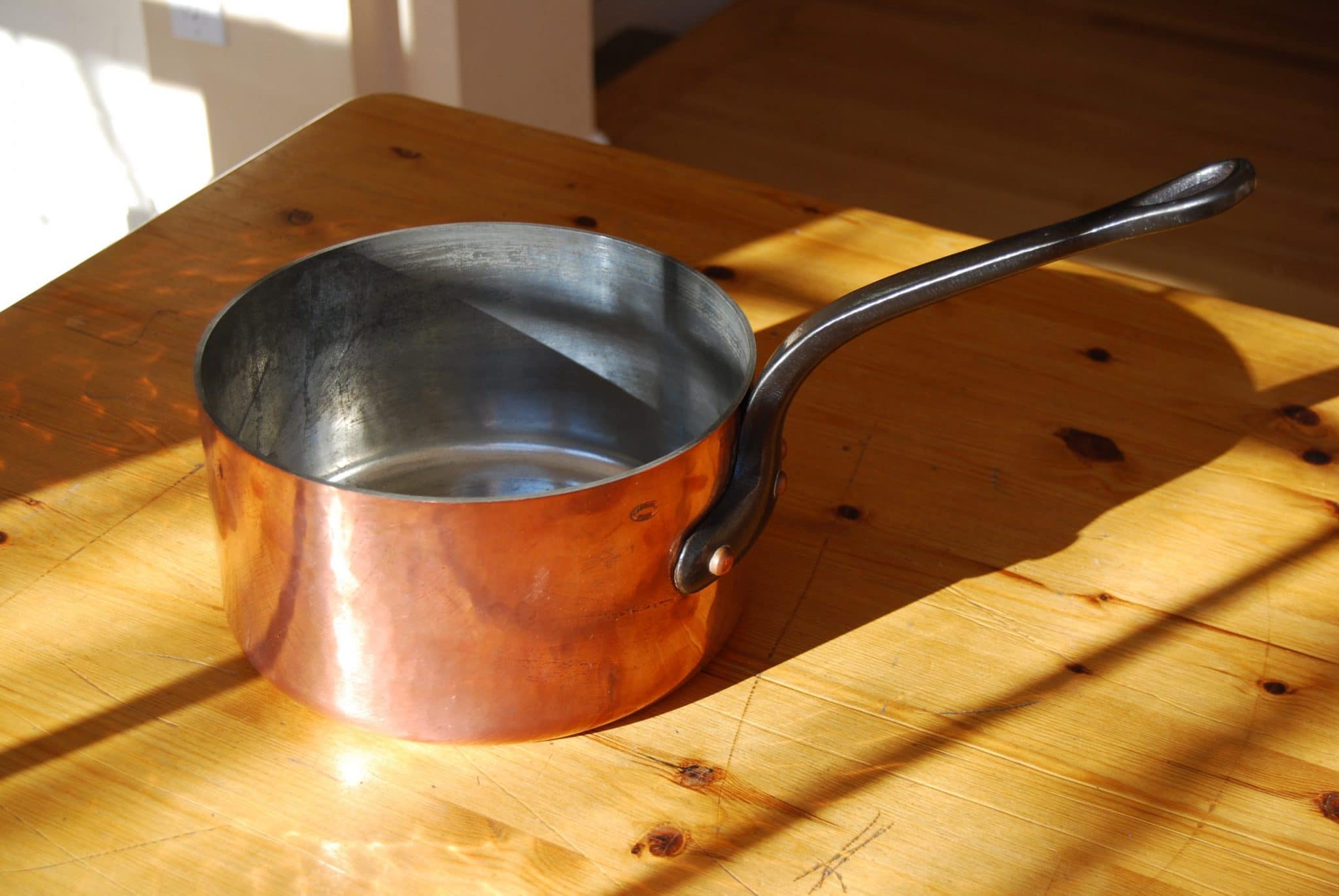

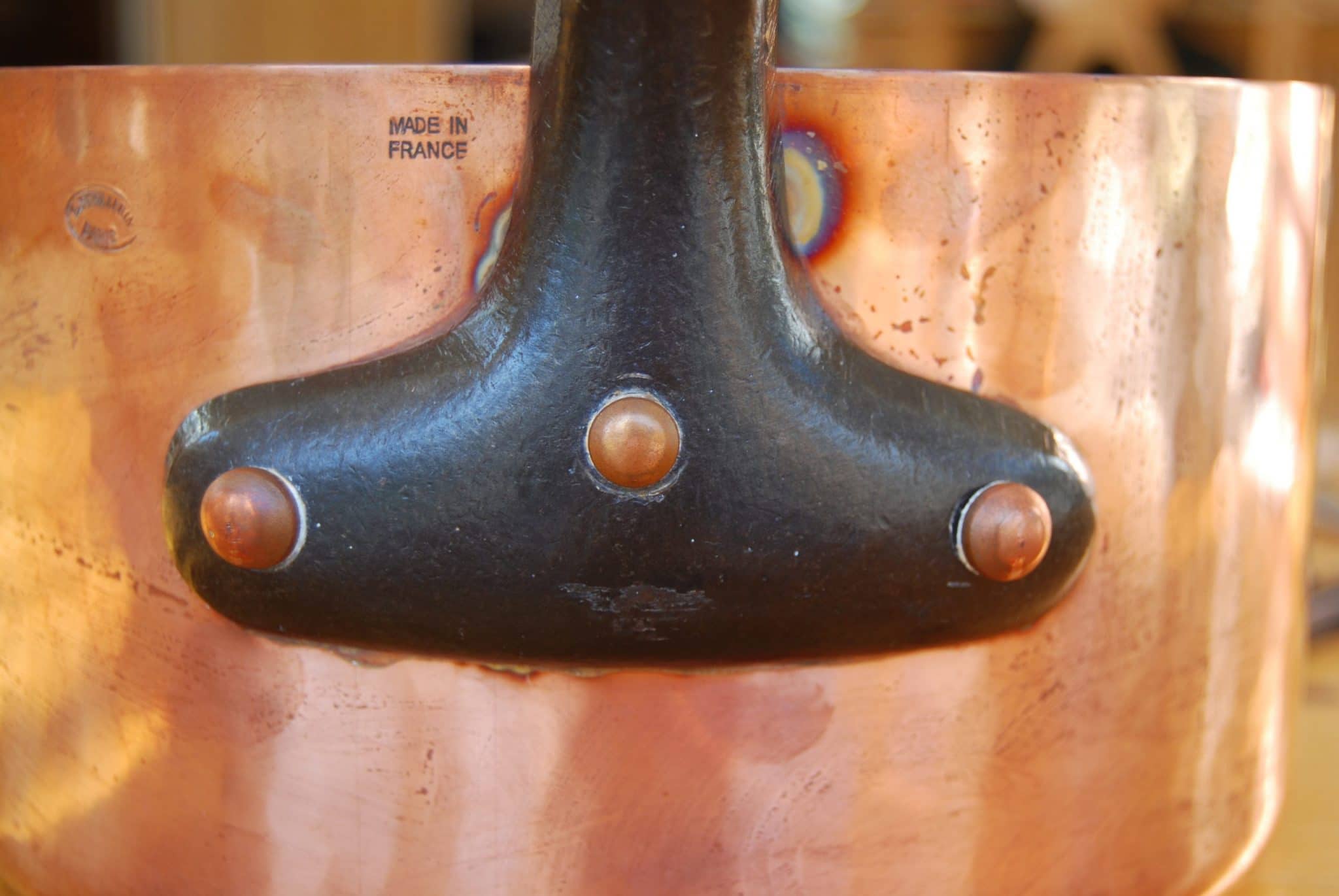
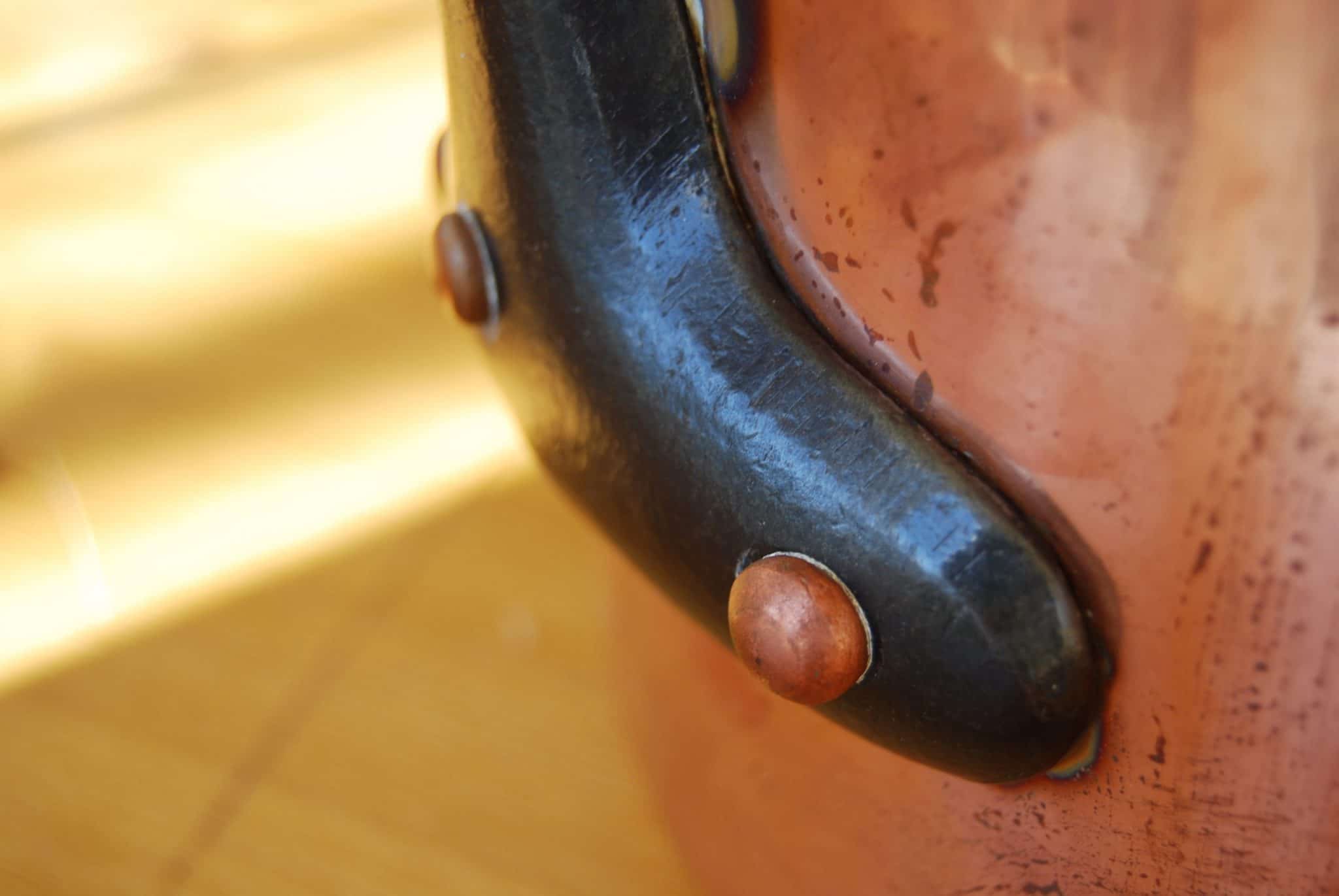
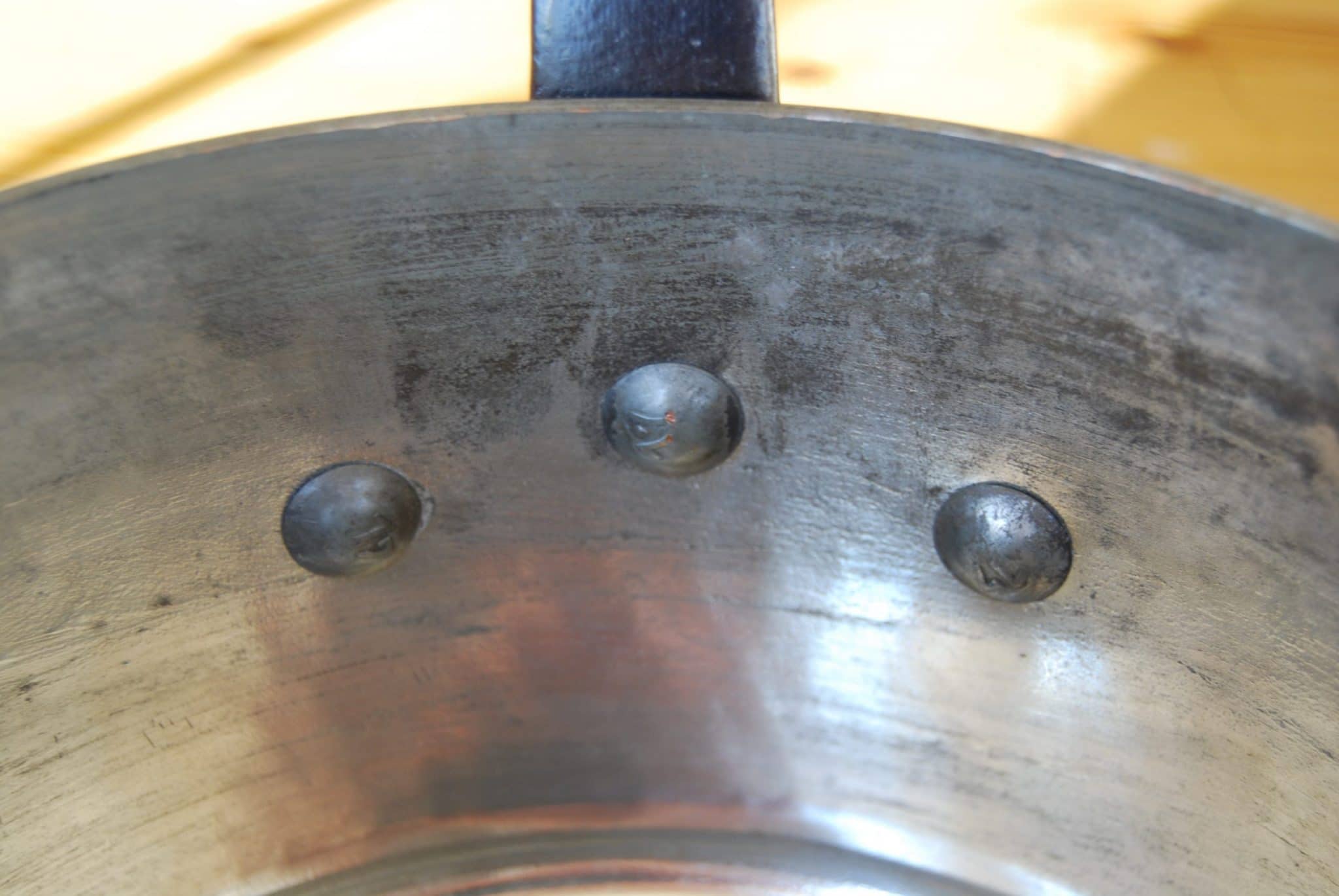
Later version
This second version is subtly different: the letters are smaller. I have two pieces with this mark that are both 1980s at the earliest — a steel-lined sauté pan and a nickeled stewpot.
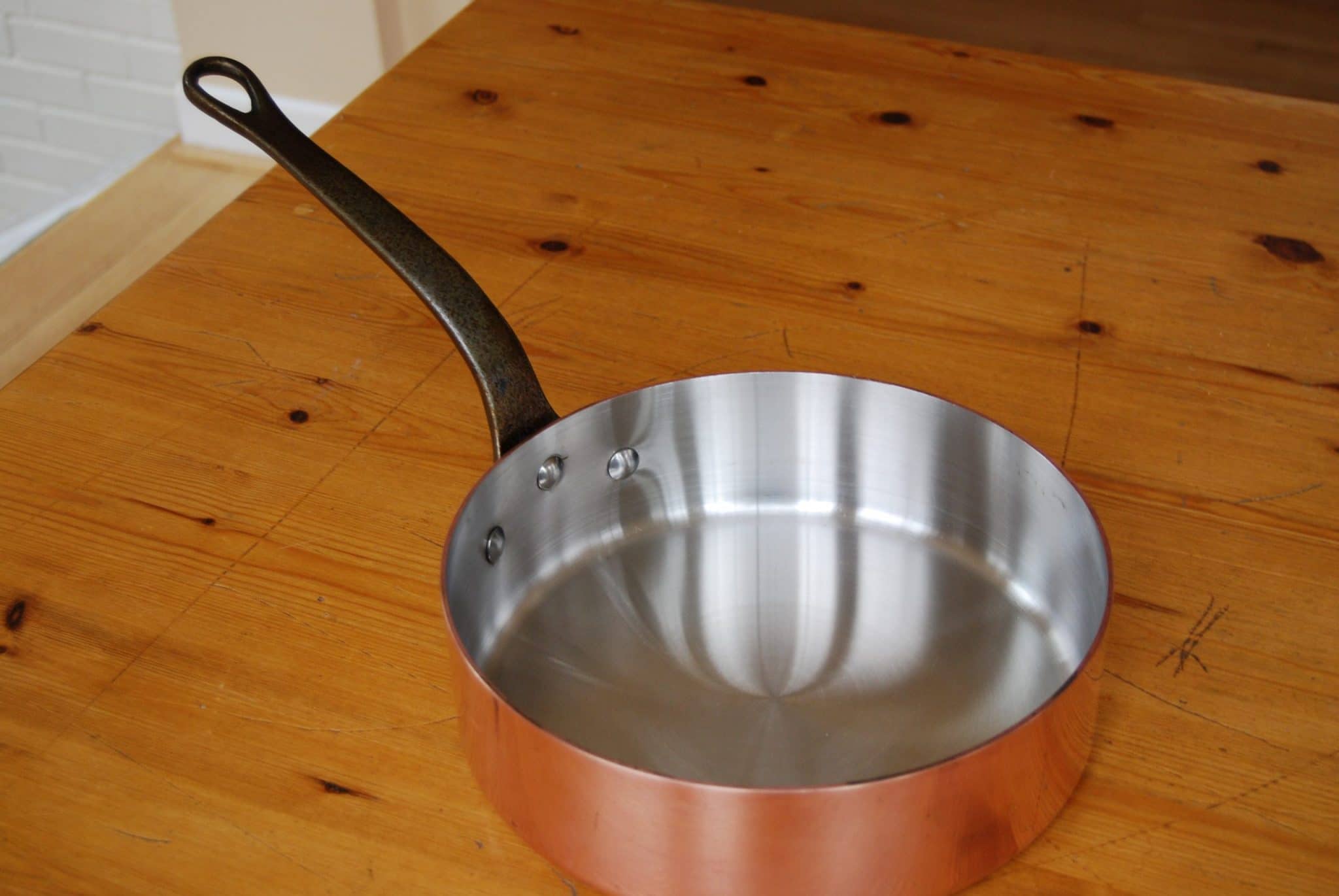

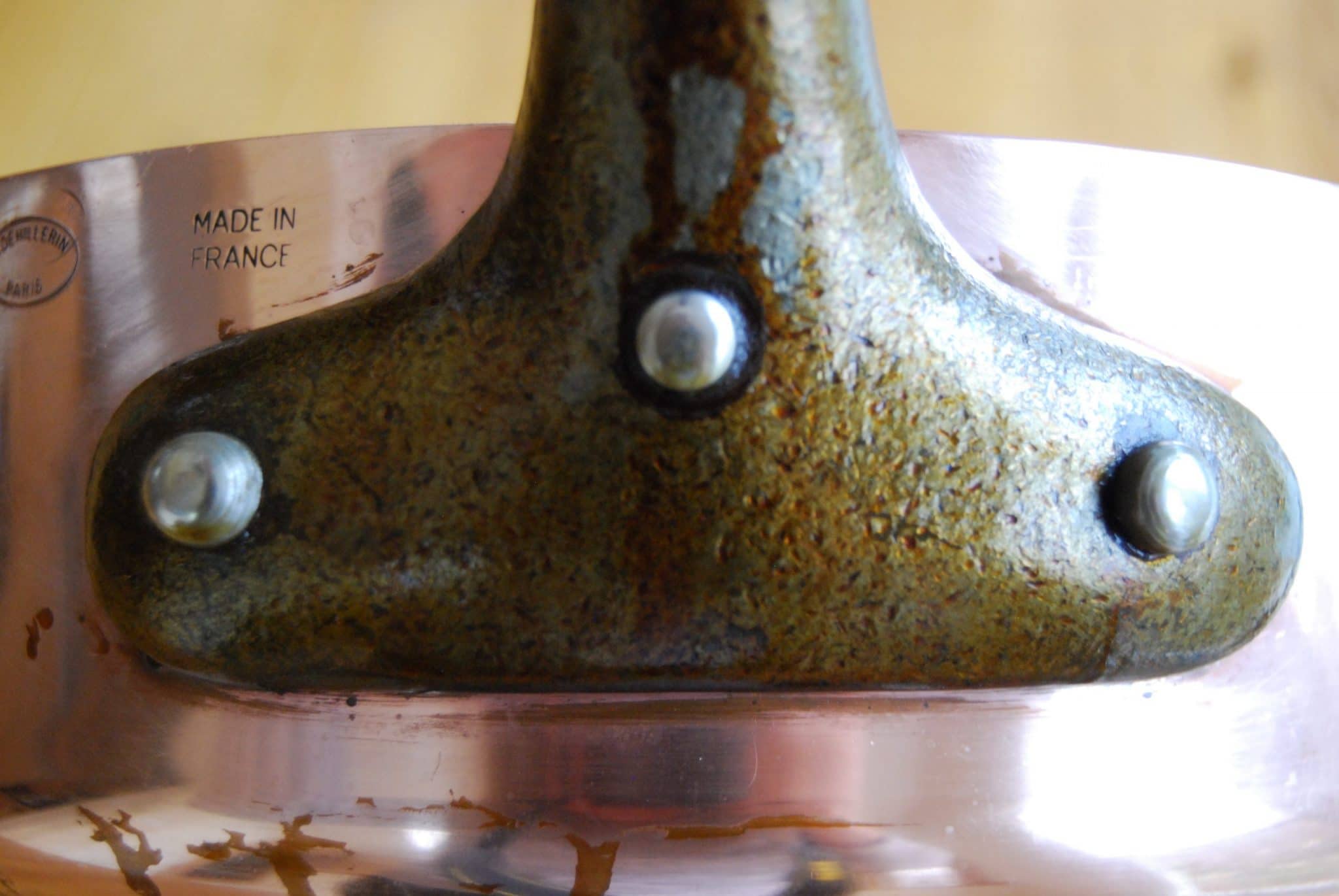

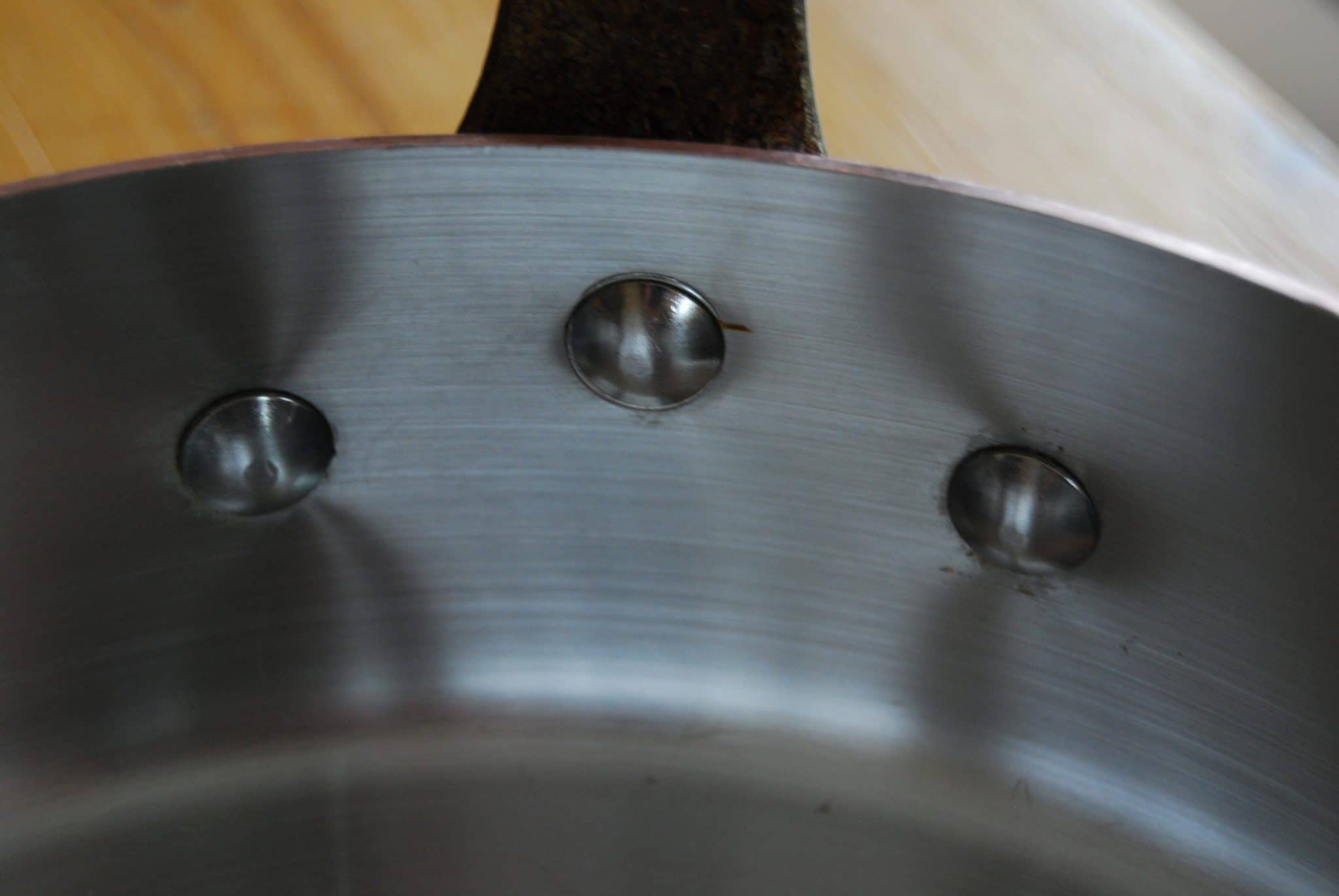
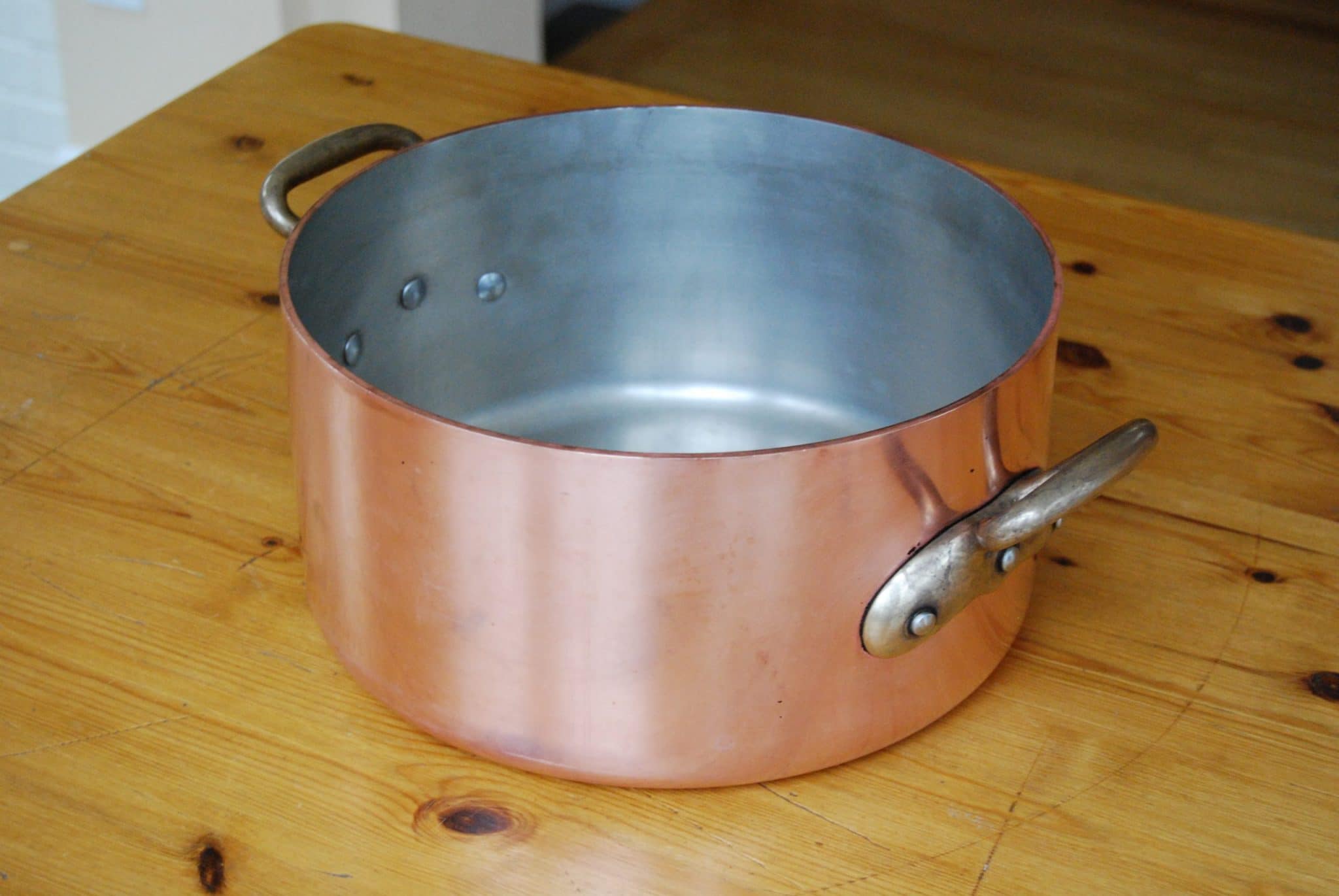
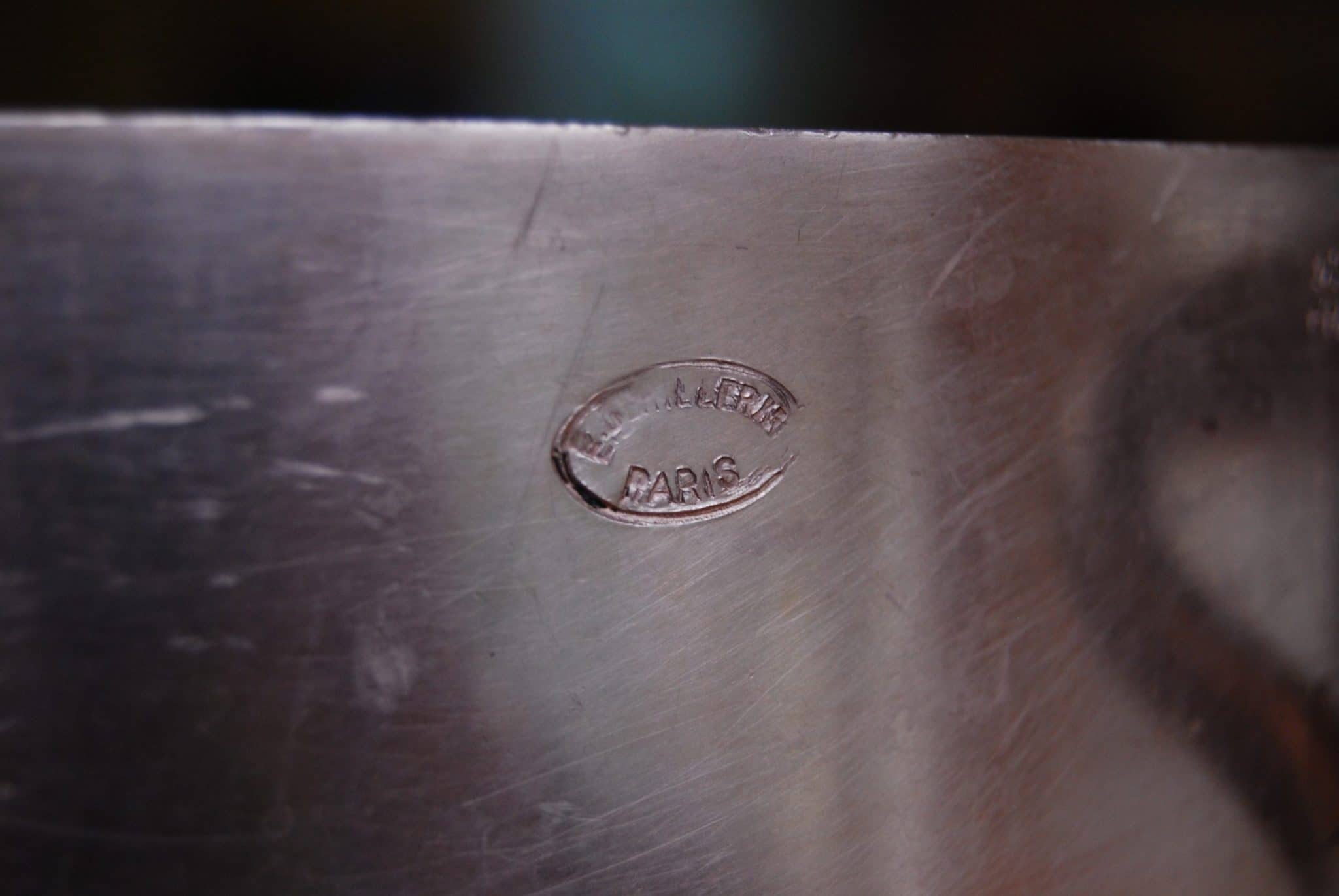
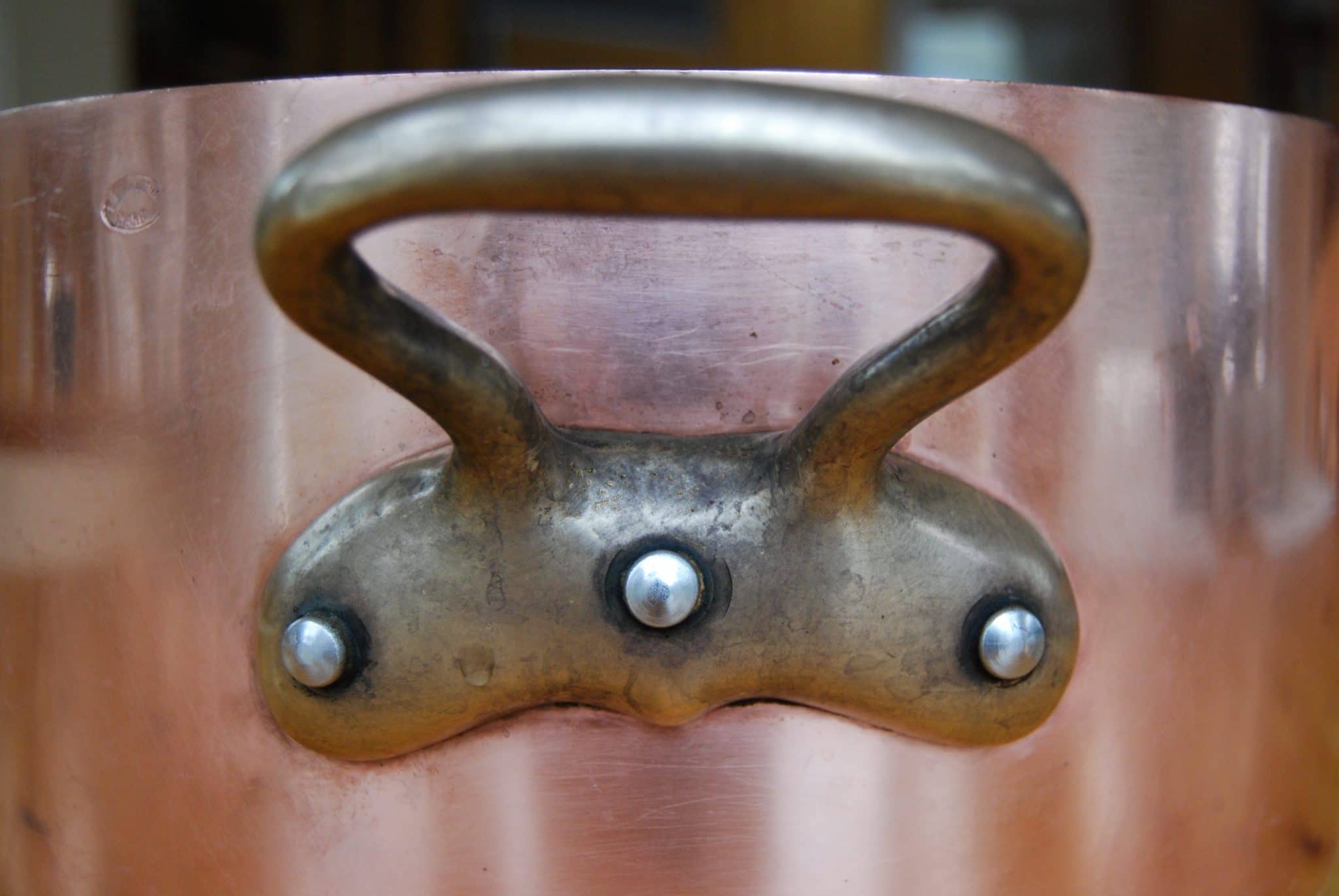

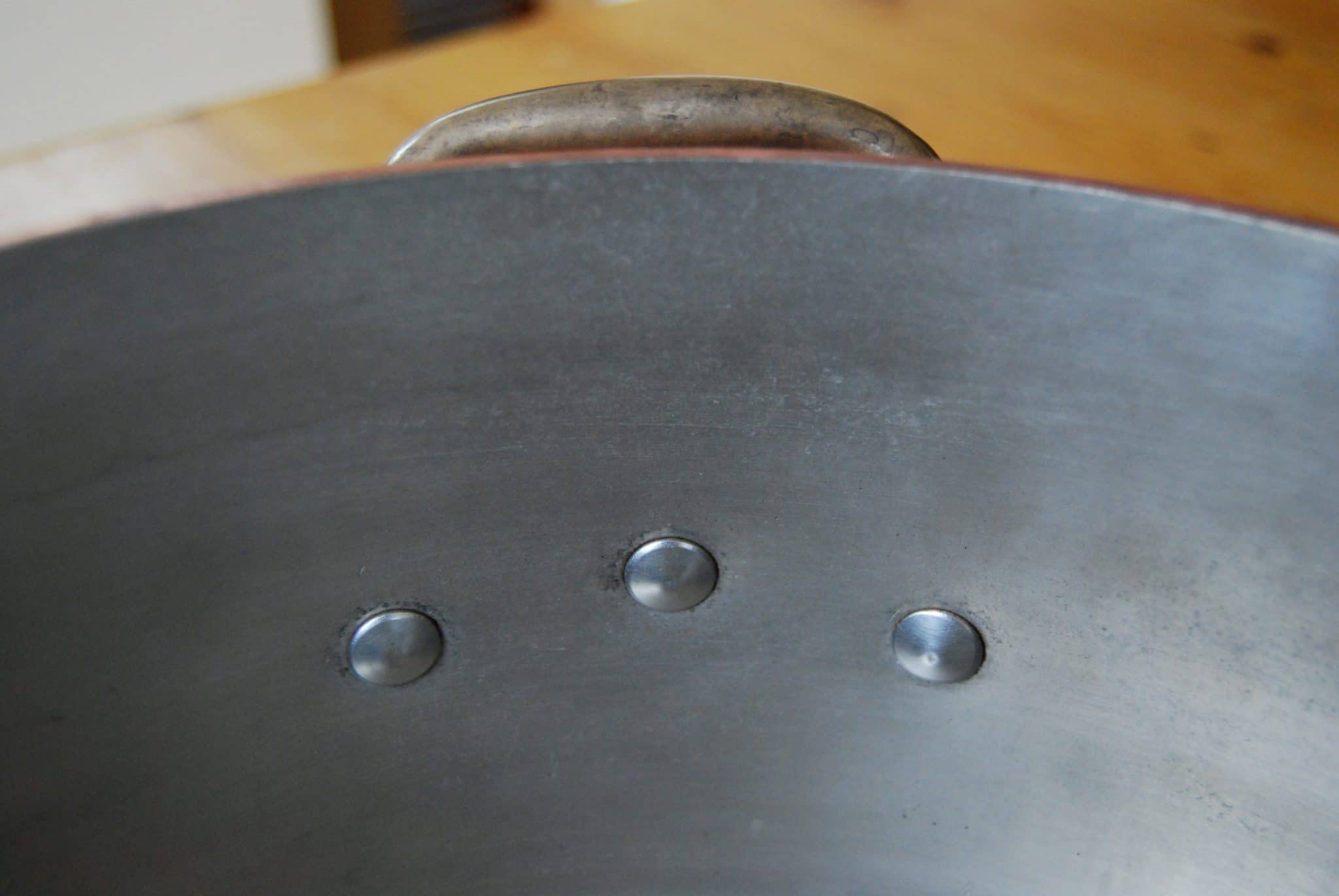
Dehillerin Paris oval
This is a new stamp I’ve seen on a few pieces and I suspect it’s quite recent — say, the 2010s and later. It says simply “Dehillerin Paris,” no longer E. Dehillerin. My suspicion at the moment is that this is a modern-era stamp in an archaic style meant to evoke the Dehillerin history; the loss of the “E.” may be perhaps a nod to modern branding and labeling requirements. I am keeping my eye out for more examples of this; it’s possible it is recent enough that not many examples have made their way onto the online stores (from which I gather many of these examples). What I’m missingI have some caveats about this “field guide.”
What I’m missingI have some caveats about this “field guide.”
- I am probably missing some marks. If you have a pot with a Dehillerin stamp shown here, I’d welcome a good closeup photo so I can add it — especially if you have information about when it was made!
- I’m making a lot of assumptions. I’ve done some research but obviously not exhaustively, and I welcome corrections from those who know more than I.
- There seems to be a lot of overlap. For example, I see “Made in France” stamps on at least three styles of stamp. Were these stamps all in use by separate producers at the same time? Was someone running around the bowels of Dehillerin, digging out old pans, and pounding Made in France onto them before shipping them off to ambitious American housewives? I don’t know. Do you?
What’s next? If you want to develop your own eye, go to eBay and Etsy and do a search for Dehillerin. Look at the stamps and then look at the rivets and handles on the pans. What do the rivets look like? How modern does the pan “feel” to you? Is there a Made in France stamp?
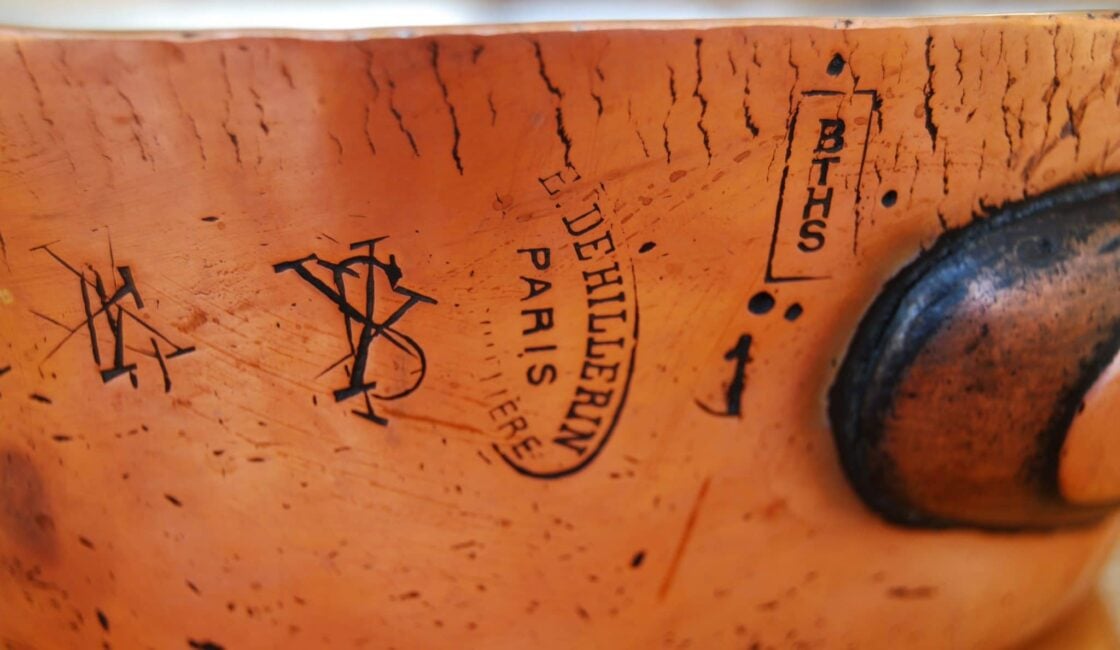

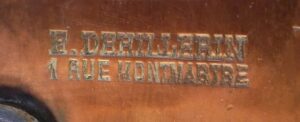
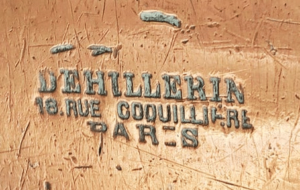
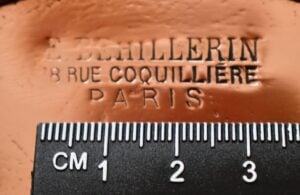
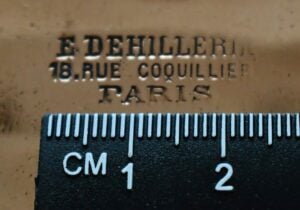


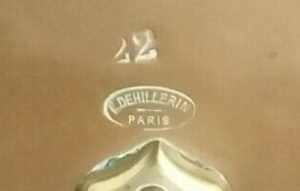
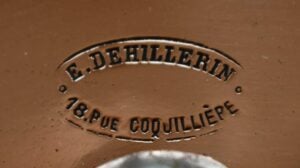
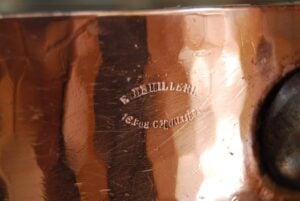
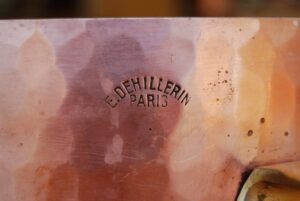
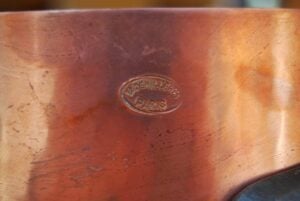
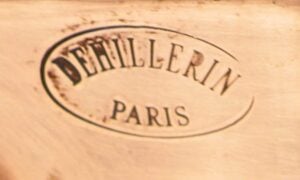
Hi, I have a stock pot I picked up at an estate sale for 10.00. It is not copper though, I’m assuming it’s stainless steel. It has the made in France stamp along with the Dehillerin stamp. I cannot find another pot made of this material on line anywhere. Can you help me out? Thanks, Kathryn
Hey Kathryn! Another possibility is that it could be made of aluminum, or even nickel. I’d be happy to take a look at it if you’d like to send me some photos. My email is vfc at vintagefrenchcopper dot com.
Found a few pots, with the oval Dehillerin Paris stamping, “Made in France” above the handle…would you know any time frame on this?
Hey John. I suspect that round stamp came into use sometime after 1957 but I don’t know the end date. I’m sorry I don’t know more at the moment — I think your best bet with those pots is to look at their construction and styling to see if you can figure out who made them. The most likely candidate is Mauviel — you might take a look at my Mauviel field guide. I’d also be happy to take a look at photos if you have them. Feel free to email me at vfc at vintagefrenchcopper dot com.
I recently purchased an 11 gallon DeHellerin, with the oldest of labels that you have listed above. It came from a Hotel In Provence where it had stayed for over 100 years until I got my hands in it in Los Angeles. Any guess at what its worth?
Hey Sebastien! Congratulations on the acquisition! An 11-gallon pot would be huge — I’m assuming it’s a stockpot or a big stewpot — what a wonderful find. I’m not an appraiser so I can’t give you a value for it, but I might be able to help you identify some comparable online listings. I’ll send you an email. Thank you — and enjoy your wonderful new piece!
I’ve recently acquired 2 pans marked DeHellerin, Paris and also are number engraved near the handles. They belonged to my now deceased sister in law who would have purchased them in Paris about 1972-73. She was a devoted student of Julia Child and cooked daily with these. I believe I was told that she had the exteriors coated with some glossy finish, perhaps to preserve their appearance after retiring them and purchasing newer, lighter weight pieces. One is 11″ x 3.5″ and the other is 9″ x 3″. I am curious about the fact that they are coated on the exterior. is it possible, do you think, that they can still be used for cooking ? Is there a market for this age pans in the US ? I would like to pass them onto someone who loves to cook with these but am concerned about the possible finish that I was told it has. Please, any comments or possibilities would be much appreciated.
Hello Judith.
The coating is likely to be some form of lacquer or varnish and should be fairly easily removed. I would try putting them in the sink and pour boiling water to see if that lifts it. If not try a solvent like acetone ( nail varnish remover ). If it’s really tough then a paint stripper is the way to go, preferably a water based one. Try a small area to make sure it doesn’t affect the copper. I had to strip my turbotiere like this.
If they are tin lined was the inside with a little vinegar as it will show up any copper showing through. If the lining is good then give them a try – you may not want to sell after experiencing copper cooking!
I am in the UK but these pans are likely to be be highly sought after, this is a desirable store stamp and the thicker/heavier they are the more valuable they are. There is a great weights and measures section on this site that will allow you to gain an idea of how measure up.
Roger
Hello Judtih, congratulations on these pans.
Some collectors of metal objects (old coins, copper, brass etc.) protect them from corrosion with “Zapon” varnish (chemically related to nail varnish). It was only a few days ago that I received pans that had been treated with this varnish. However, the seller had concealed this before buying. Copper pans treated in this way cannot be used for cooking again until this varnish has been removed. The paint is highly flammable! It can be removed with acetone. However, I would leave this work to a professional who can also check the type of varnish beforehand. If the pans need re-tinning, the paint could be removed in this context.
There is quite a market for these types of copper pans in the US, as you can see on VFC. Older, antique pans usually fetch higher prices. One sales opportunity would be eBay.
Roger was faster. Since I am German, it takes a while to translate. I treated one of the lacquered pans with boiling water. The paint peeled off well from the tin, but the result on the outside of the copper was somewhat incomplete and stained. Fortunately, the seller took back the inadequately described pans.
This article was brilliant!
I bought my first dehillerin sauté pan, it’s got a stamp and the letter “g” on it. Can I send photos to you to learn more?
Hey Sam! Absolutely. I’ll send you an email to which you can reply.
What a wonderfully thorough site! I love quality and buy vintage when I can. I get the question – “is it stainless or tin lined”? I never want to misrepresent a piece, and the one in question has a the Post 1957 E Dehillerin oval as shown above and is a 24 cm splayed. How do I determine tin or stainless? Thank you so much for your time. – Nancy
Hi Nancy! Here are a few ways to tell the difference. First, the rim of a steel-lined pan will be mostly copper with a defined thin inner layer of steel, while a tin-lined pan often has a tin-colored rim because the tin has spread over the edge during tinning. Second, the rivets on a steel-lined pan are also steel and are likely slightly magnetic; a tin-lined pan will have copper rivets that are not magnetic. (Test this on the inside, away from the iron handle if it has one.) Third, the exterior rivet heads on a steel-lined pan are silver colored, while a tin-lined pan’s rivets are copper (unless they have been daubed with tin, as a few were). Finally, look at the surface texture of the lining itself: a steel lined pan has been polished at the factory to produce a lightly grooved surface, a bead-blasted matte finish, or a mirror finish; a tinned pan has subtle swirl and wipe marks, most easily seen if you tilt the pan in the light to see the contours. (See https://www.vintagefrenchcopper.com/2019/01/interior-finishes-on-stainless-lined-pans/ for examples of these steel finishes.) I hope this helps!
We have a copper pan chaudromnaer briffault paris I can not find anything, can someone please assist, I’ll be willing to send photos. We would like to know it’s worth [email protected]
Hi Andre! I’m not an appraiser so I won’t be able to help you with a value, but I’d be happy to take a look. I’ll send you email. (I’ve edited your comment to obscure your email address for your privacy.)
Hello Andre, there was a business “Fourneaux Briffault” (chaudronnerie mecanique et au marteau) in Paris with a branch in London, which primarily manufactured or sold cookers, but probably also pans. Maybe that helps a little.
https://ultimheat.com/s3-museum/1904%20Briffault.pdf
Your post was put up two years ago but I hope you are still accepting comments. I just saw a pan with a mark like you E. DEHILLERIN ARCHED except that in the word PARIS, the letter A has been double stamped and is crooked. Do you have experience with such marks and what do you know about their authenticity? Thanks so much!
I only now saw the revision of this post. For this, VFC certainly deserves a piece of tiramisu and a ‘thousand leaf cake’. To the mentioned Dehillerin casserole with additional stamp SAPEL I would like to add an anecdote and a guess.
Albert Schweitzer also appreciated the confectionery Sapel in the Black Forest. Every year, for his wife Helene’s birthday, Café Sapel received a telegram from Lambaréné, Africa, with an order for the ‘Thousand Leaves Cake’, an elaborate puff pastry specialty of his Alsatian homeland, which Helene especially loved.
The great-great-grandfather of the founder of Konditorei and Café Sapel, Joachim Sapel (born 1668), was a master blacksmith. His ancestors had probably immigrated to Germany from Italy. In the old cemetery of the town of Netro in the Italian Western Alps, the name Sapel can be found on numerous gravestones. Netro was originally a settlement founded by the Celts and meant “New Defense”. The Celts in Netro had excellent skills in forging weapons. The art of blacksmithing was preserved in Netro over the centuries. Blacksmiths from Netro were in demand as far away as France and were often hired as instructors. It is possible that during the Thirty Years’ War a blacksmith named Sapel answered the call of the great armies that marched through Europe recruiting mercenaries everywhere, but also blacksmiths and other craftsmen. Even if there is no direct link between the small Dehillerin casserole with the complementary stamp Sapel and the blacksmiths named Sapel, it is possible to find common roots.
Martin, thank you for your kind words — they mean more to me than you could have known! My father visited Dr. Schweitzer at his clinic in Lambarene in the 1950s and maintained a deep lifelong respect for the man. He taught me the deep humility of Schweitzer’s “reverence for life.” What a nice reminder of the unexpected connections that bind us all together, even across generations.
VFC, in life, there are always surprising connections that leave me amazed and touch my heart. Now I am even more delighted about this find.
Cockerel + scrollwork redux
Scrollwork (squiggled) handles are also occasionally seen on pans by Vanneuss (Brussels) and Pianfetti (Annecy), also made around the turn of the 1900s. Now I wonder, were Charmois/Lasnier the originators of these handles and did the other two manufacturers obtain these handles under license or was there a supplier from whom all four mentioned manufacturers obtained these special handles?
I have a dehillerian copper and silver chafing pan that I can find no information on. Do you recall seeing one of these. I see nowhere to add a picture here.
Hi I recently visited the store in Paris and it made me think. I live in Swansea South Wales. In the 19th Century Swansea was known as Copperopolis, the greatest copper smelting centre in the world. At its height it smelted 90% of the World’s copper. So I wondered if they sourced their copper from Swanse in the early days. Could anyone help me find the answer to this question.
Single-line Dehillerin
In the meantime, the senior manager of Cafè Sapel confirmed to me that the confectioner’s shop had several Dehillerin pans at the beginning of the 20th century. All with this one-line stamp showing only the name Dehillerin. Why was the street and city not indicated? My guess is this.
The decades from about 1850 to 1950 was a time of increasing nationalism in Europe, leading to 3 wars. I think it was therefore not popular to buy quality products from rival countries. One way to facilitate the export of such products may have been to disguise the origin. The name Dehillerin alone without any other information was innocuous. This meant that the pan could not be immediately identified as a foreign product.
A similar method of disguising manufacture around foreign countries was to replace the foreign maker’s mark with a domestic store stamp. I saw corresponding examples in various countries in Europe. As long as origin or protection marks like “Made in ….” or “Unis France” did not become obligatory, hiding the origin worked quite well.
What do you think about my assumptions?
Hello again
I am hesitating buying a gratin dish that has the Dehillerin Paris oval stamp but also right next to it VILLEDIEU FRANCE stamped. Is that possible or even koscher ? Thanks Lisa
Hi Lisa! I see no reason why a piece with these two stamps would be suspect.
I have a question! Did Dehellerin do factory seconds and stamp the pots as such or mark pots for other reasons? I found one with an RT stamped next to the logo that the seller said was retinned, one here has an A in a similar spot, and another on R-Bay had marks over the logo as well. They look intentional to draw attention to some aspect of quality. All Clad does this, so just wondering if anyone knows if Dehellerin ever did?
Hi Melissa! My first thought would be that these additional stamps were owner’s marks. I am not aware of a factory seconds program for Dehillerin prior to WWII when they made their own copper, and since then, Dehillerin has sold copper made by others (primarily Mauviel). I would not expect Dehillerin to resell a factory second piece by Mauviel, and while Mauviel does have its own factory store and *might* sell seconds there, such a piece would not also be stamped for Dehillerin. (I hope this makes sense!) Readers, any other thoughts?